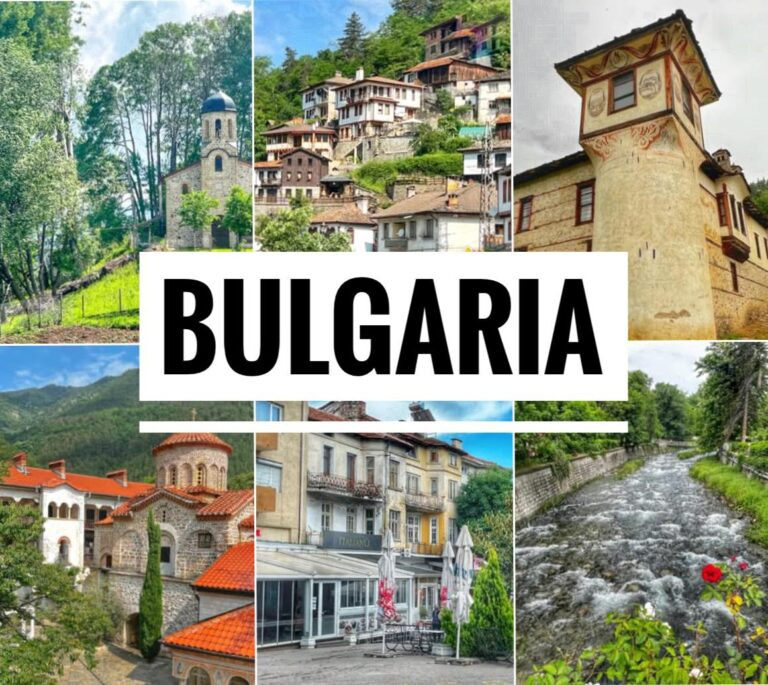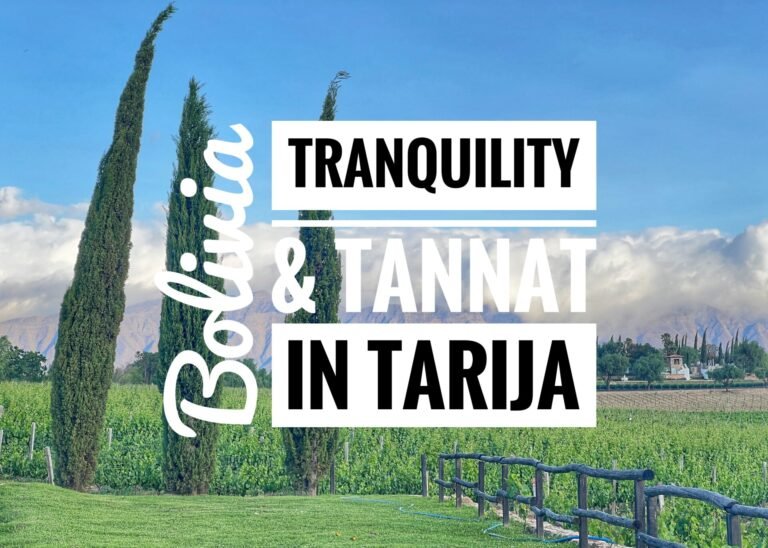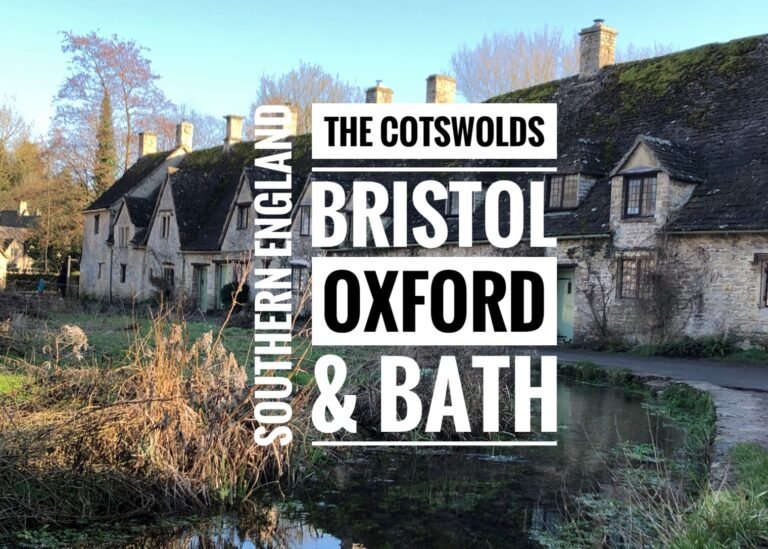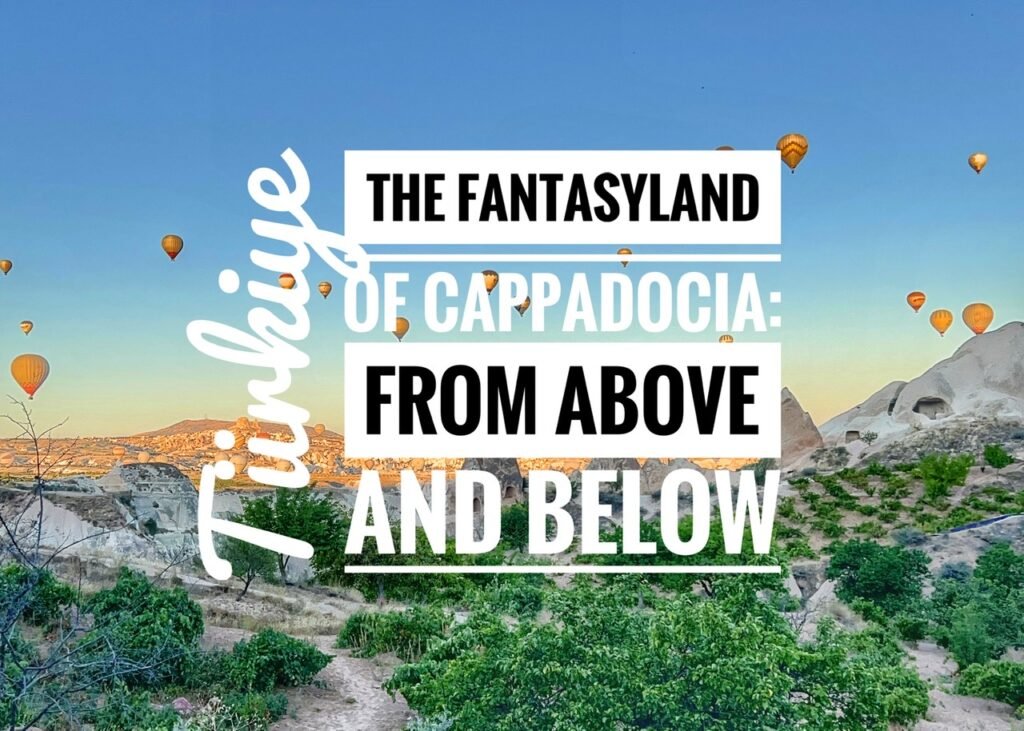
Anyone who has been to Türkiye usually swoons when you mention the whimsical fairylike land of Cappadocia, located in the Central Anatolian plateau. The entire region is blanketed with fairy chimneys, conical wizard hats, gnome-like domes, and Smurf-esque spectacles, which have served as churches, monasteries, tombs and dwellings for centuries. The landscape of Cappadocia has significant stretches of soft volcanic rocks formed 60 million years ago from volcanic eruptions, which have shaped as a result of constant wind and water erosion.
It is a wonderland well suited for solo, couple or family exploration where you can stay in a cave dwelling, scramble through domed “castles,” explore miles upon miles of ancient underground cave cities, soar far above in a mystical hot air balloon, or hike in some of the most interesting terrain you might ever see in your life. If it’s not already, make sure to add this region of Turkiye to your “bucket list.”
Sleeping in a Cave
Speaking of, this may come as a surprise, but we don’t do “bucket lists.” For us, they’re too loosey goosey and don’t offer enough accountability for measurement. After all, we want to actually achieve those goals, which is why we instead have developed age specific goals, which we then breakdown into annual goals. For the time being, this has resulted in a “60 by 60 List.” And Greg got two checked off while in Cappadocia. The first was…sleeping in a cave, which happened to coincide with a splurge for our 9th wedding anniversary.
Ah yes, wanna get back in touch with your prehistoric roots, but still into modern conveniences…like a mattress, electricity, wifi, and plumbing? We chose Takunya Cave Hotel for $64/night. Takunya is an ancient family home that has been converted into a hotel. The owner mentioned to us she was born here and her grandparents too! The rooms were authentic caves, carved by hand a century or more ago. It was a long-held and somewhat bizarre dream of Greg’s to be able to sleep in a cave. He succeeded. We specifically chose a windowless unit to get the full cave experience.

We loved the pocket hole lights and the ebb and flow of the walls and ceiling, but, the best thing about staying in a cave? Eerily quiet and totally pitch black. This was kind of a shock to our systems after a month living next door to a mosque. Also, a totally unique experience!

The worst thing? Not a lot of air flow…and a distinct cave-y (surprise) and musty odor accompanied with tiny bits of the stone roof tumbling onto our backpacks, but fortunately not our heads ?

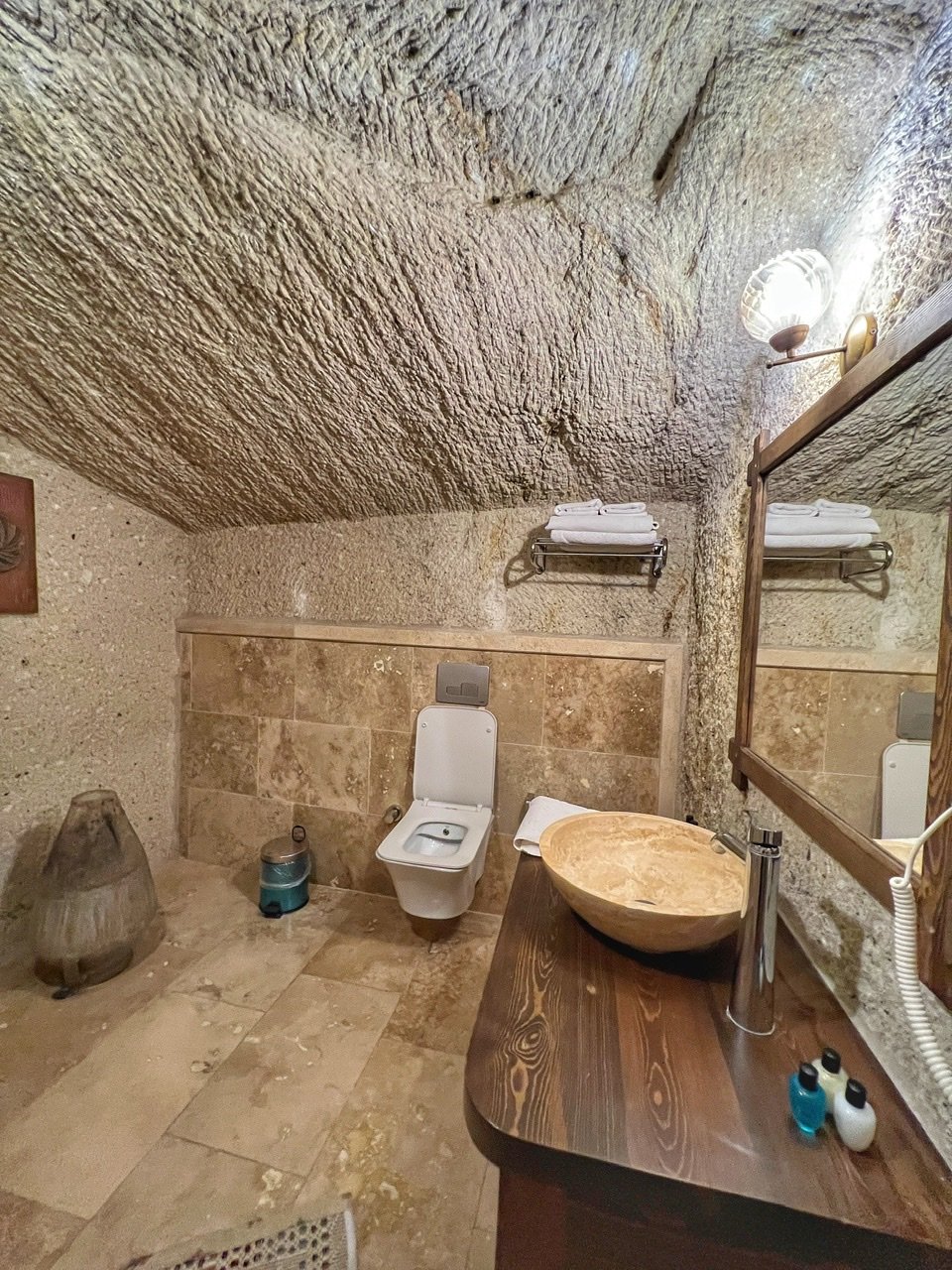
Showering in a cave is fun but makes it extra musty and humid. There didn’t seem to be any ventilation! Also, the toilet has a bum gun spigot inside it, which has been pretty common in Türkiye! There is a little knob next to the loo to fire away! Healthy, functional and modern. We’re fans.
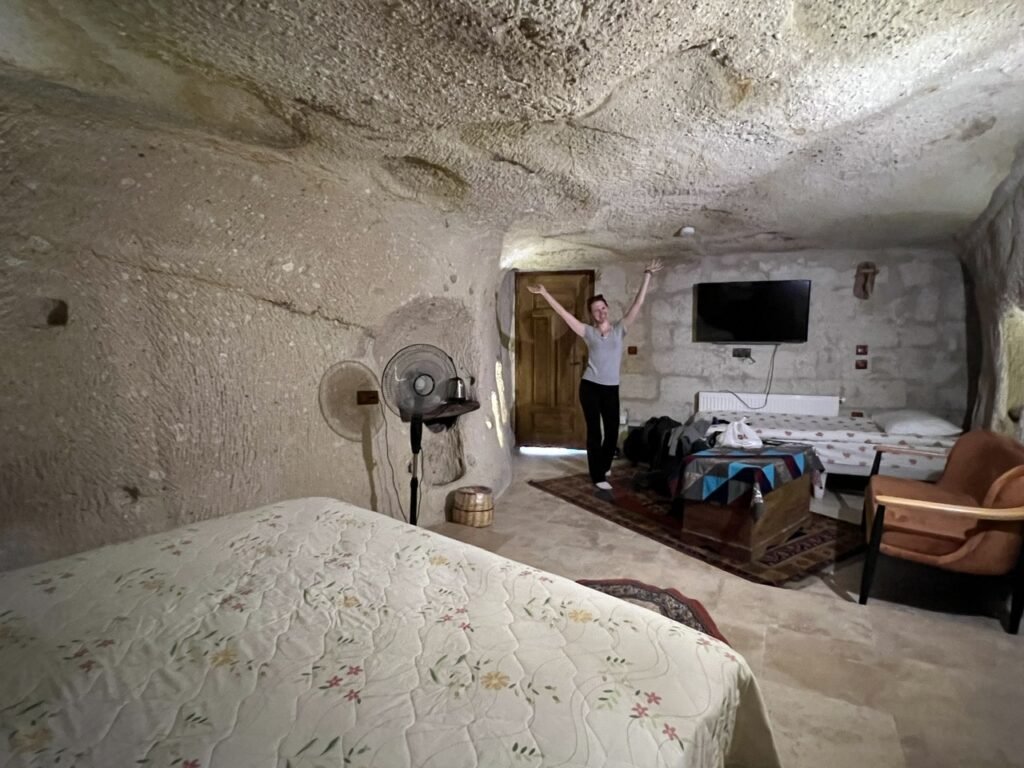
And even extra room for yoga and exercises! Bonus: with the humidity it kinda felt like being inside a gym locker!
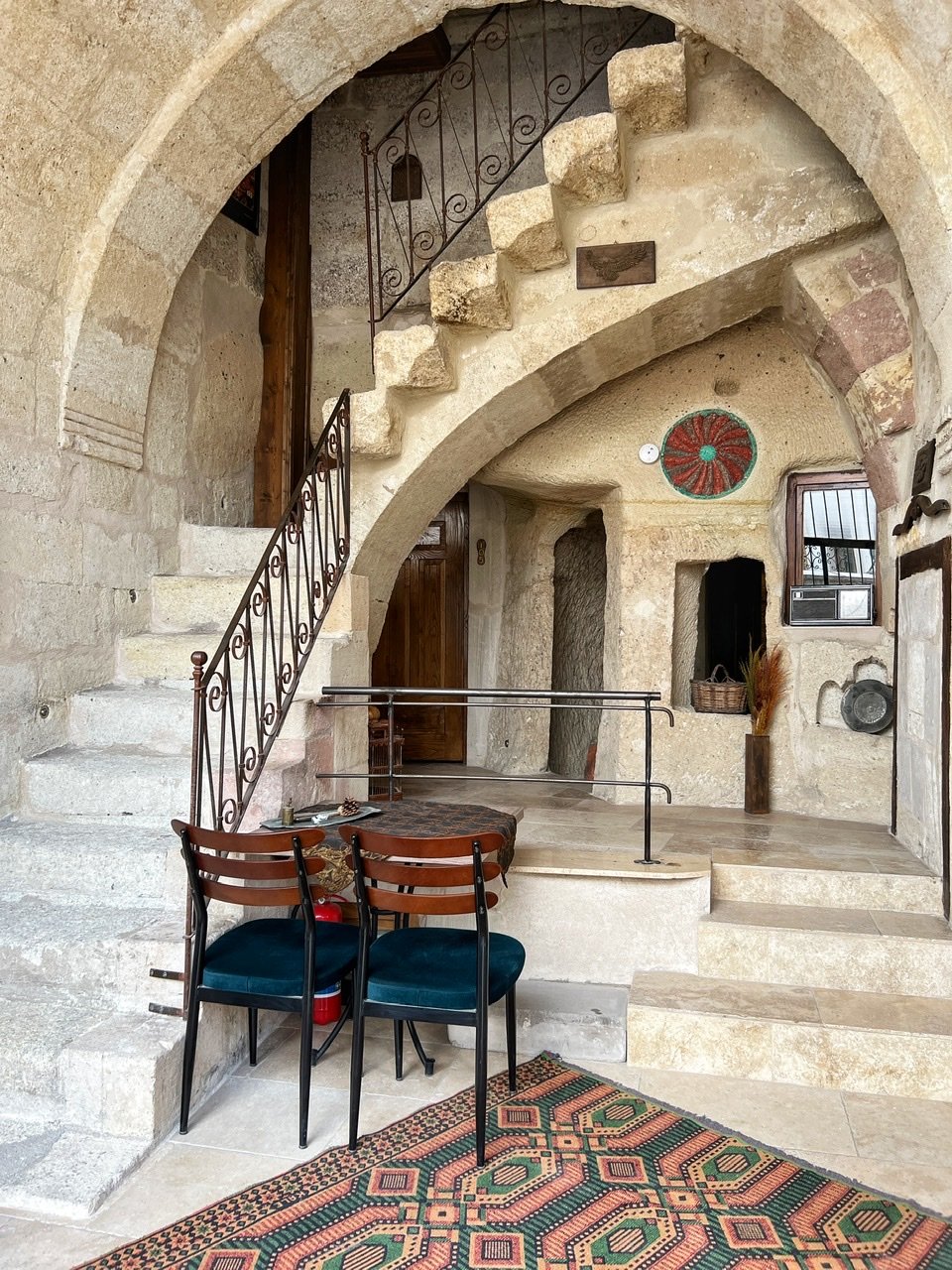

The interior and exterior entrances to our room.
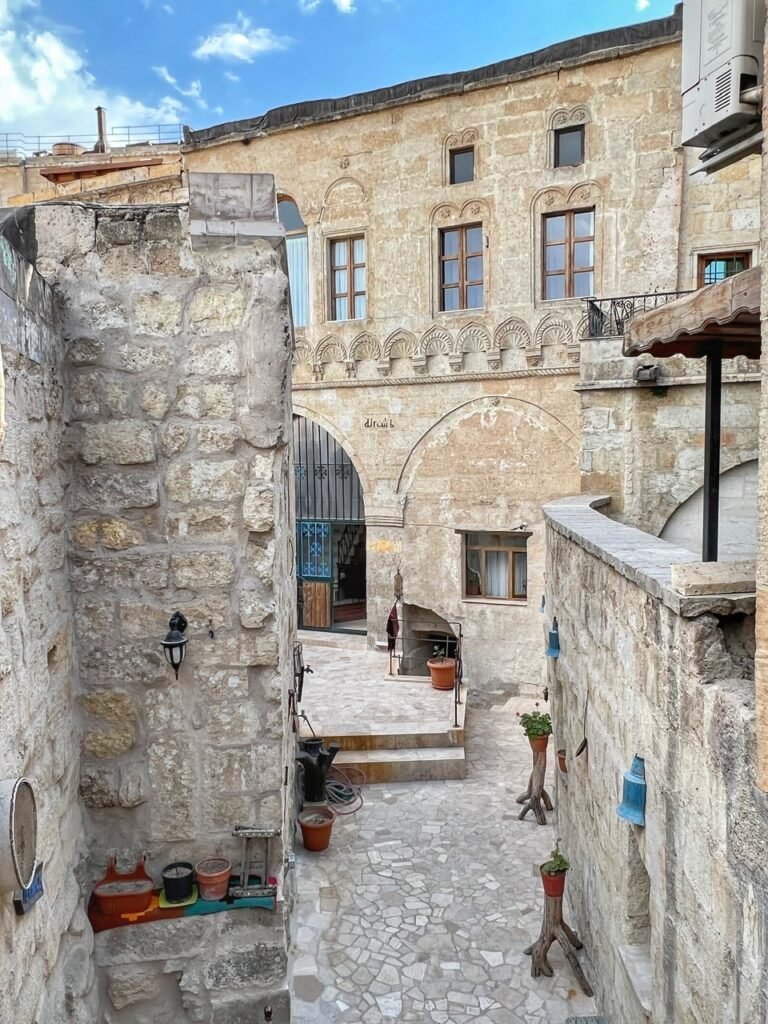
The inner courtyard area was like stepping into a movie set.

And, what a view from the terrace! Unfortunately we didn’t get to have our breakfasts here, but it was still nice to sit and appreciate.
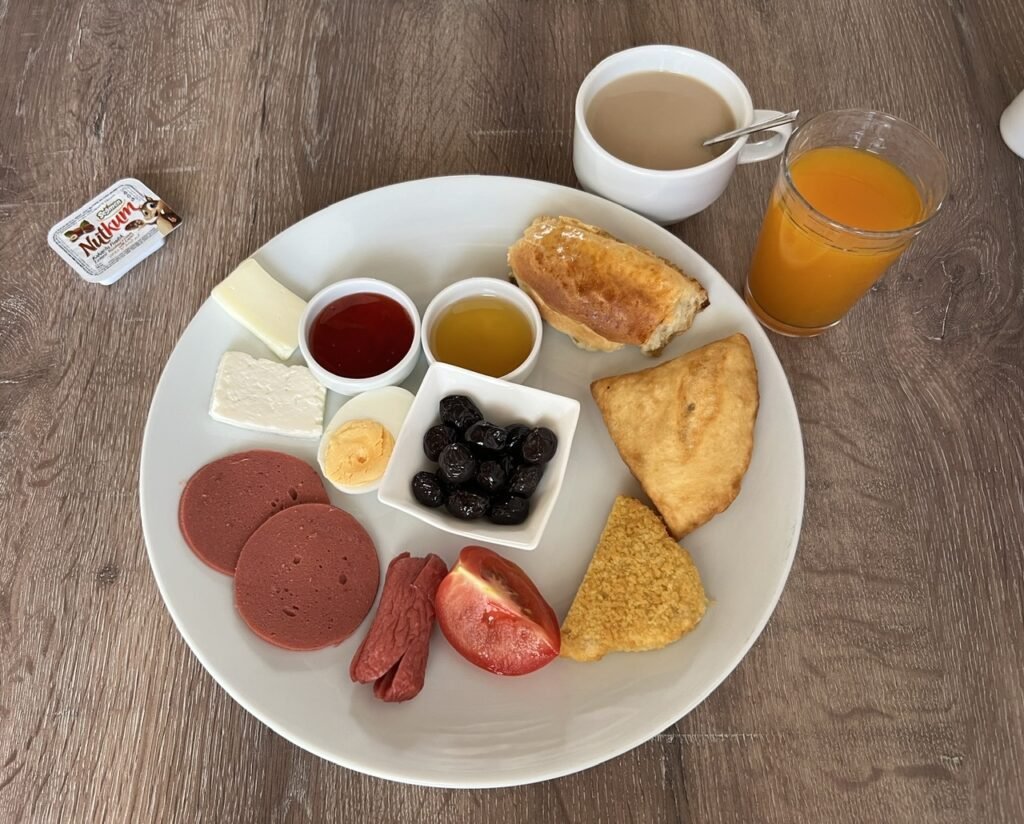
Our breakfast, held in a room below. It’s very uncommon for breakfast to not be included with your accommodation in Türkiye. Yum?
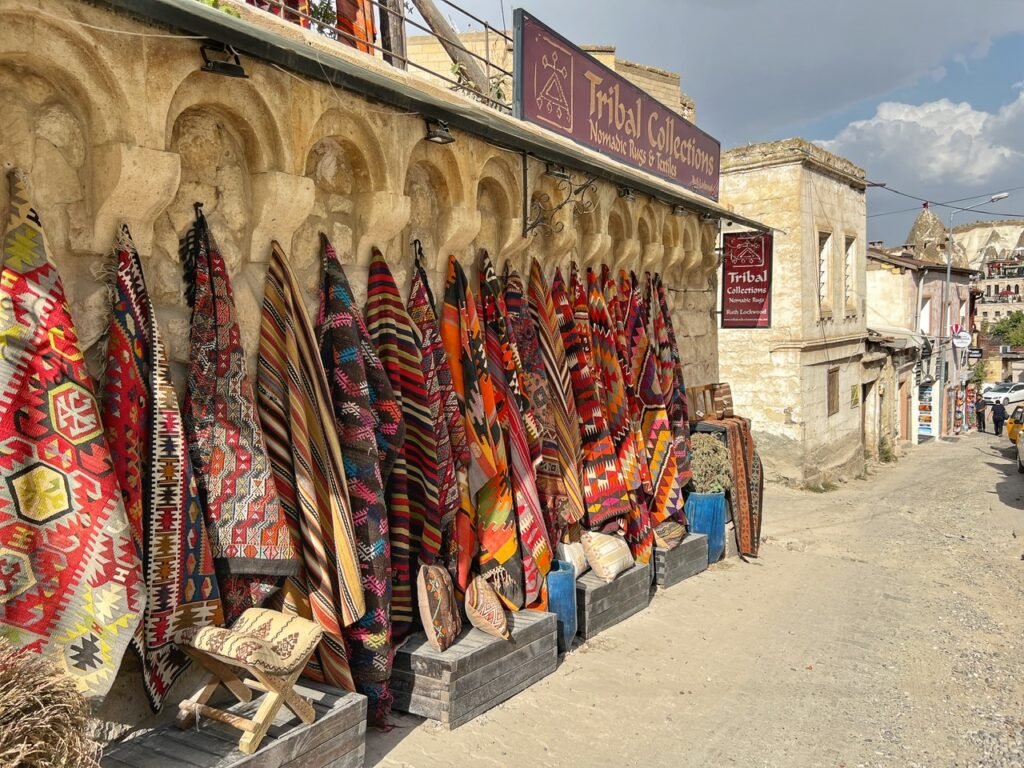
Walking around the streets near our hotel we stumbled across the “Nomad” Rug Shop. Unfortunately these nomads don’t have a place to put such beautiful displays. Turkiye is probably the most difficult country we’ve been in to turn down shopping.
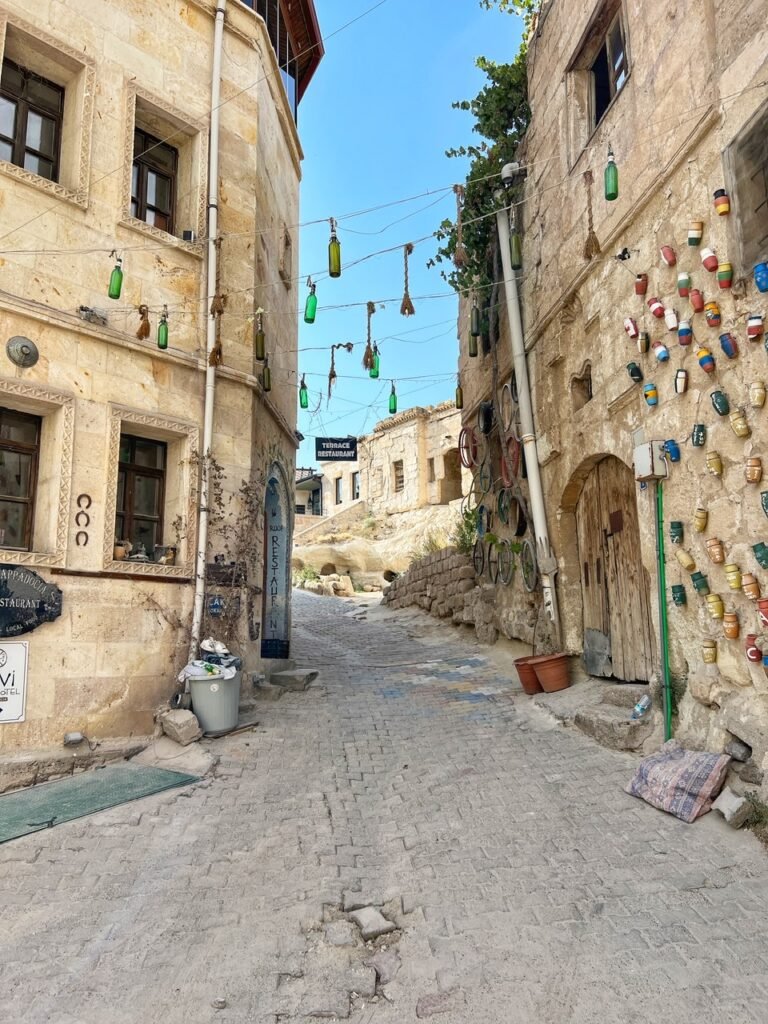
Loved how the streets were decorated
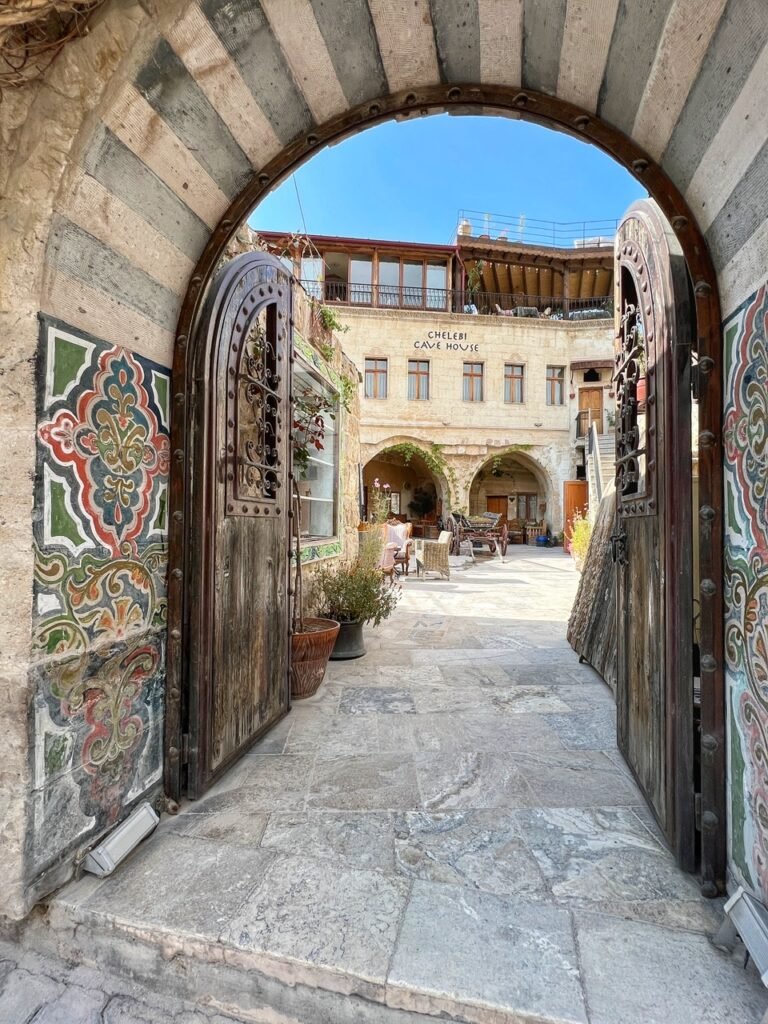
And getting a peek into even fancier hotel options. (Bet they include complimentary bathroom ventilation!)
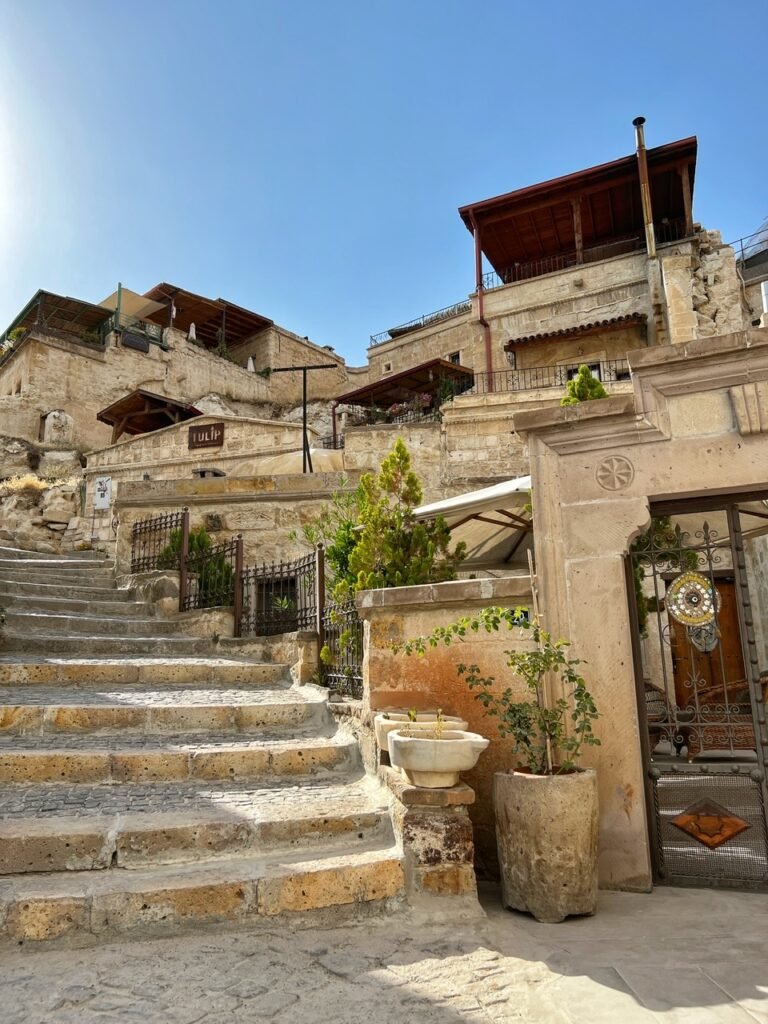
Much of Göreme is built from layers upon layers, hundreds of layers in the making.
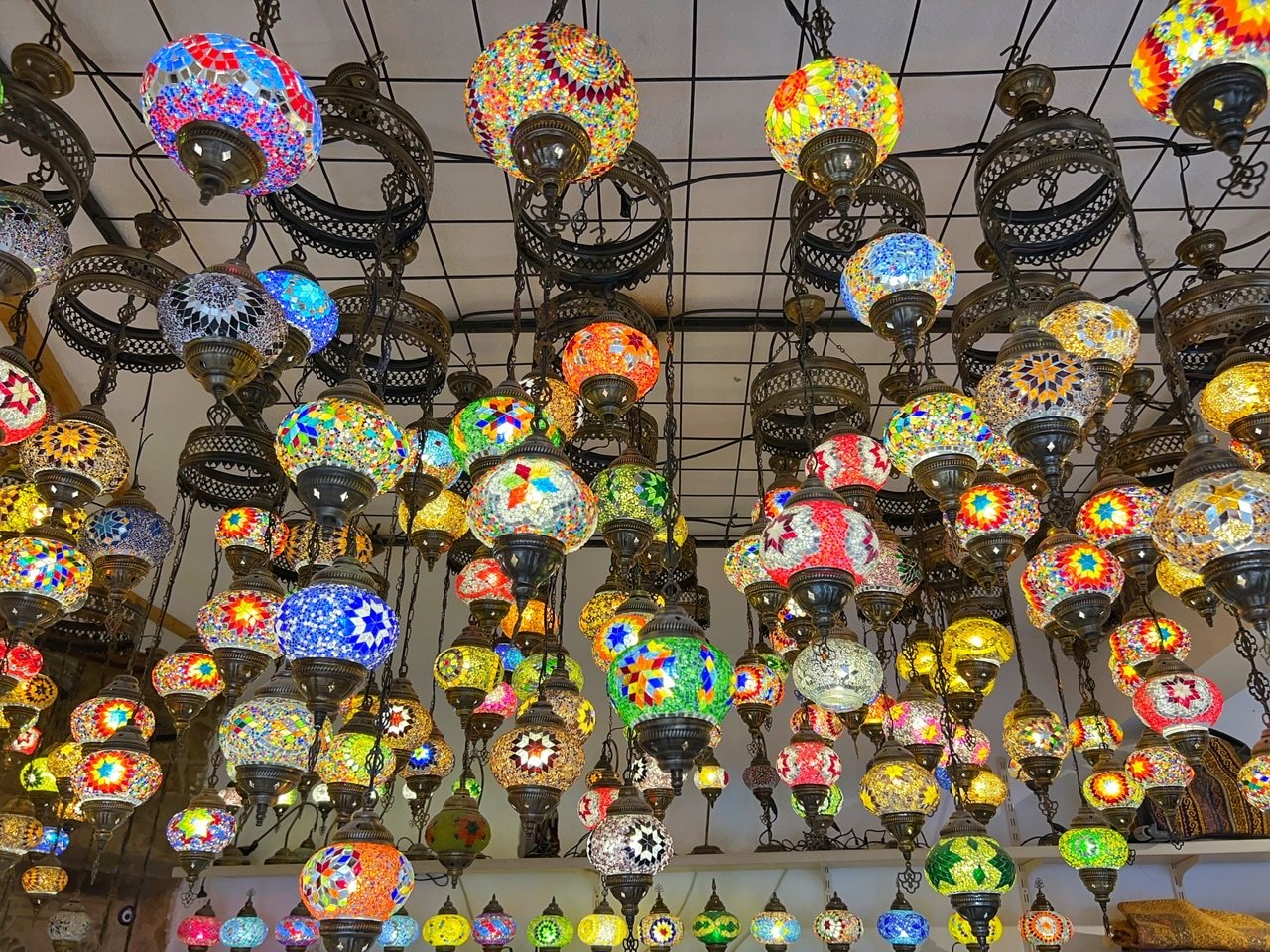

What is it about centuries old handmade Turkish lamps that are so dreamy and exotic? Can’t get over the colors or the mosaics? When we have a home, we need at least 20 of these ?

And maybe some of these too…
Hot Air Balloon Ride
Ah yes, the stereotypical Cappadocia balloon ride and a 60 by 60 item for both of us. After all, gliding over fairytale chimneys and chiseled canyons at sunrise in a hot air balloon is practically mandatory if you’re coming to this part of the world and an absolutely epic experience…
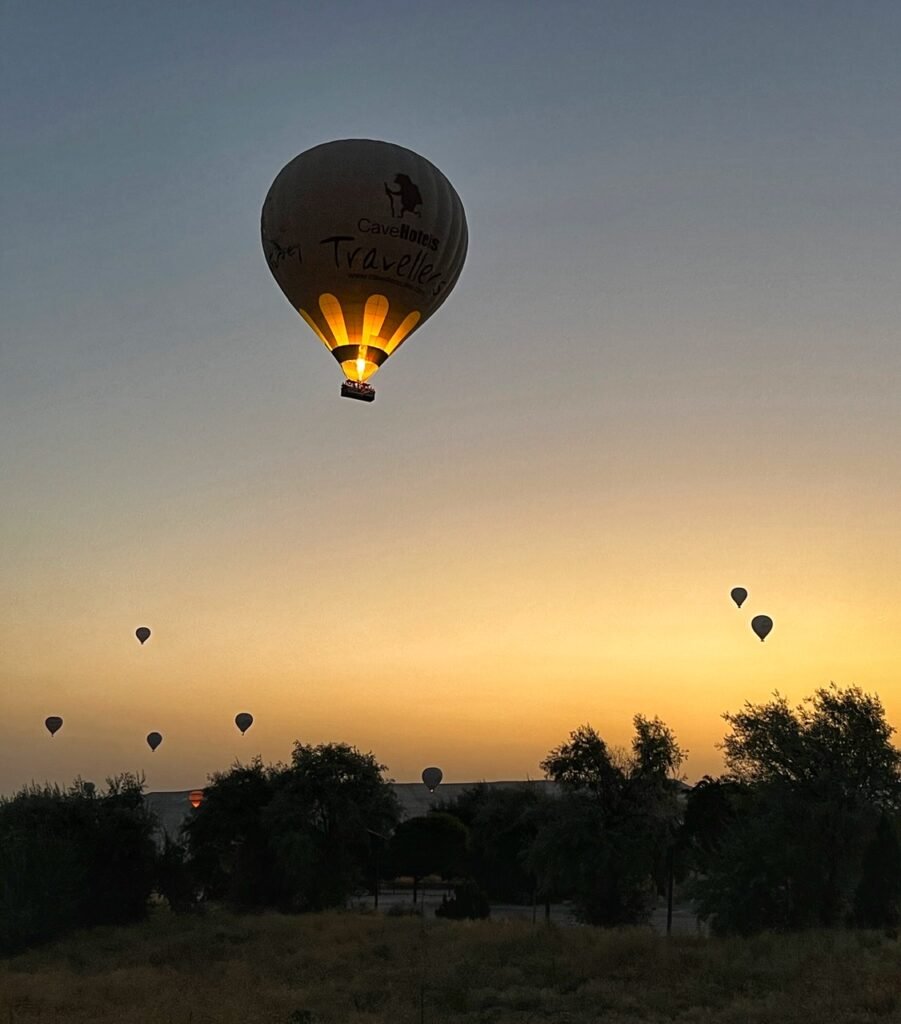
The experience began when our alarm (ugh what the hell is that?!) started humming incessantly at 4 am. 45 minutes later we were fetched from our cave, alongside a friendly British couple we got to share the experience with.
The van escorted us to the Turquaz Balloon office where we were assigned our captain, whose name was Ali Elma. Mandy immediately pointed out to the check in lady that Elma meant “apple” which she confirmed with surprise. God bless Duolingo and their first lessons in apple vocabulary. ?
We were then served a breakfast which included fruit, pastries and of course, Turkish tea.
In a very organized fashion, Turquaz sorted us into vans and drove us about 15 minutes to the balloon launch field, where we were amazed to already see balloons hovering overhead in the distance.
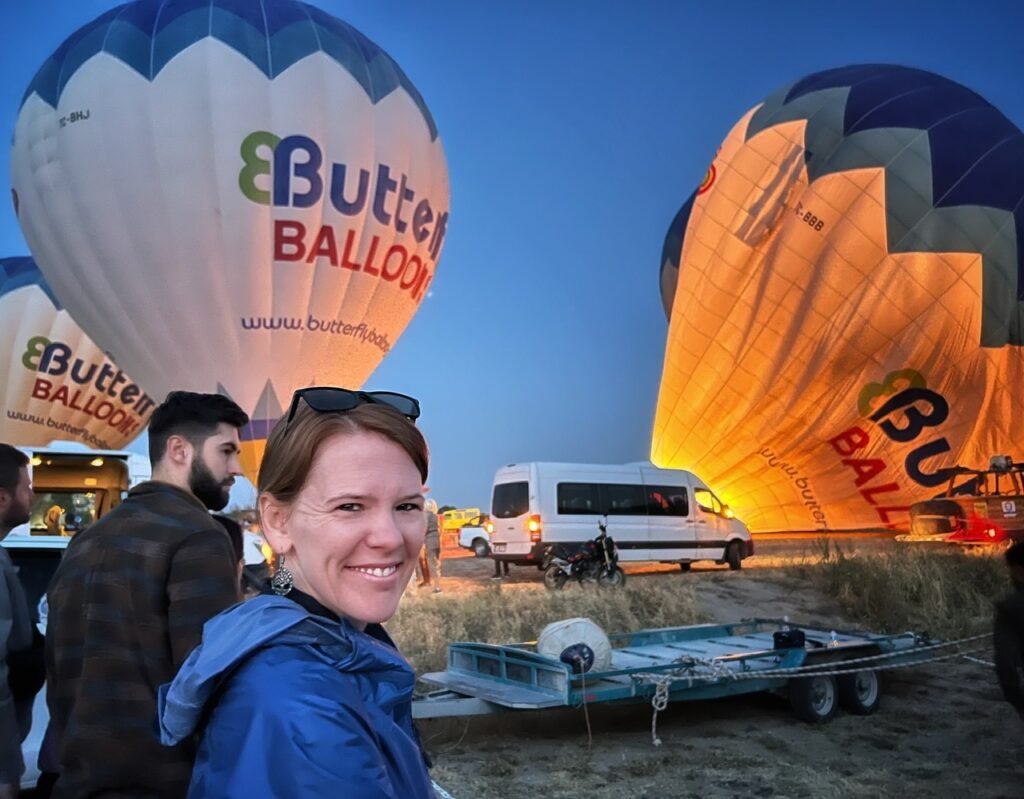
Riding in a hot air balloon was a dream that started at age four for Mandy when she first saw Dorothy hop on board in “Wizard of Oz.” Unfortunately for her, Dorothy only went to the ceiling of the munchkin dome, so it would be necessary to take it a step further.
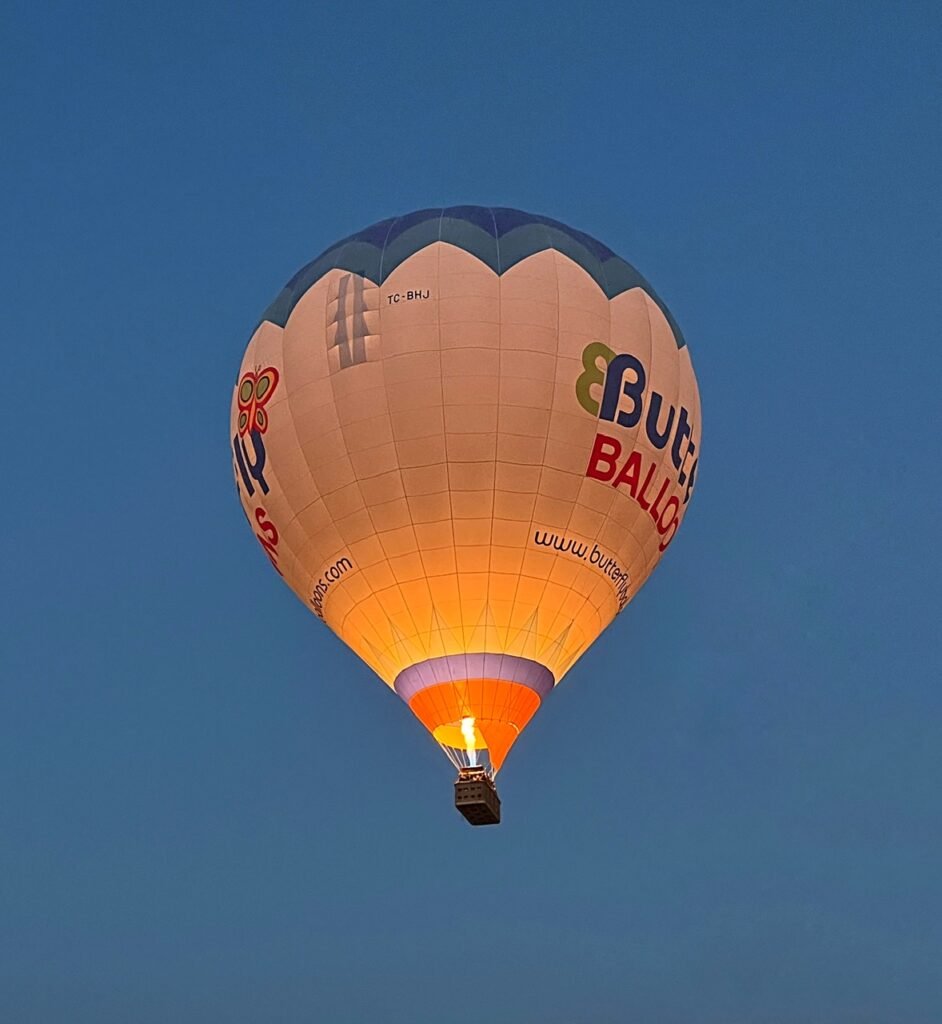
Watching our first liftoff before us actually brought tears to Mandy’s eyes.
The first liftoff ever in a hot balloon was remarkably in the year 1783 from the home of Louis XIV and Marie Antoinette in Versailles, France. The passengers included a rooster, a duck and a sheep as test subjects (who were all unharmed during and after the experiment.)
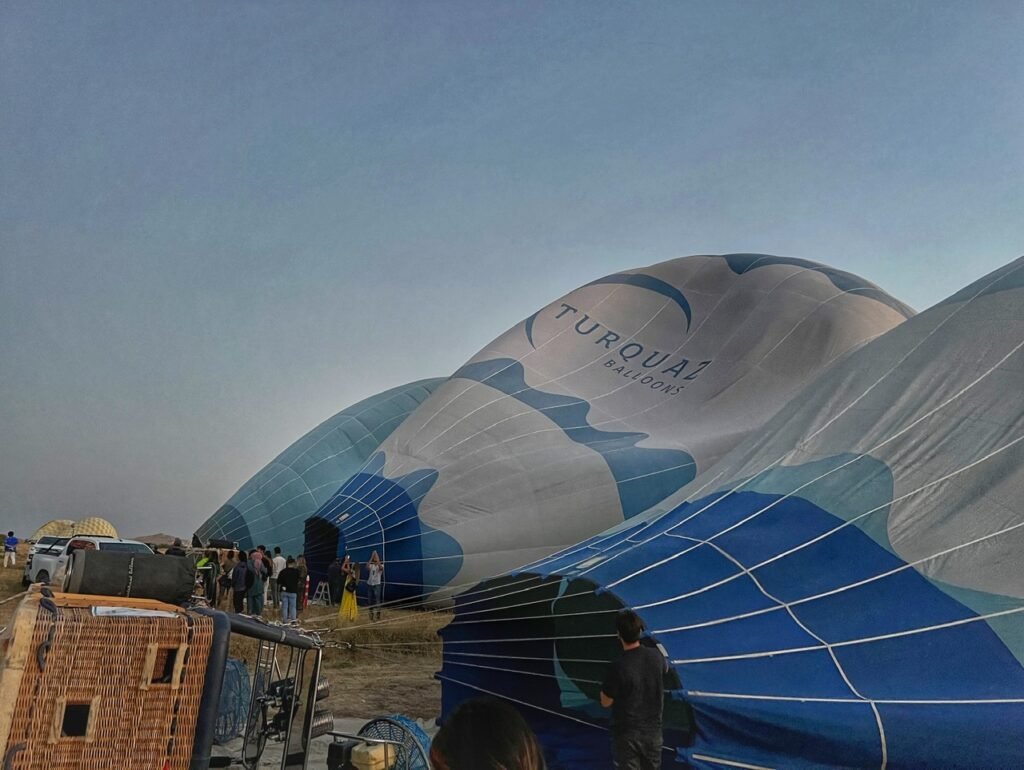
You don’t realize how massive balloons are until you stand on the ground before them. When we arrived, a team of about six men were adjusting our balloon and aiming ridiculously powerful fans inside.
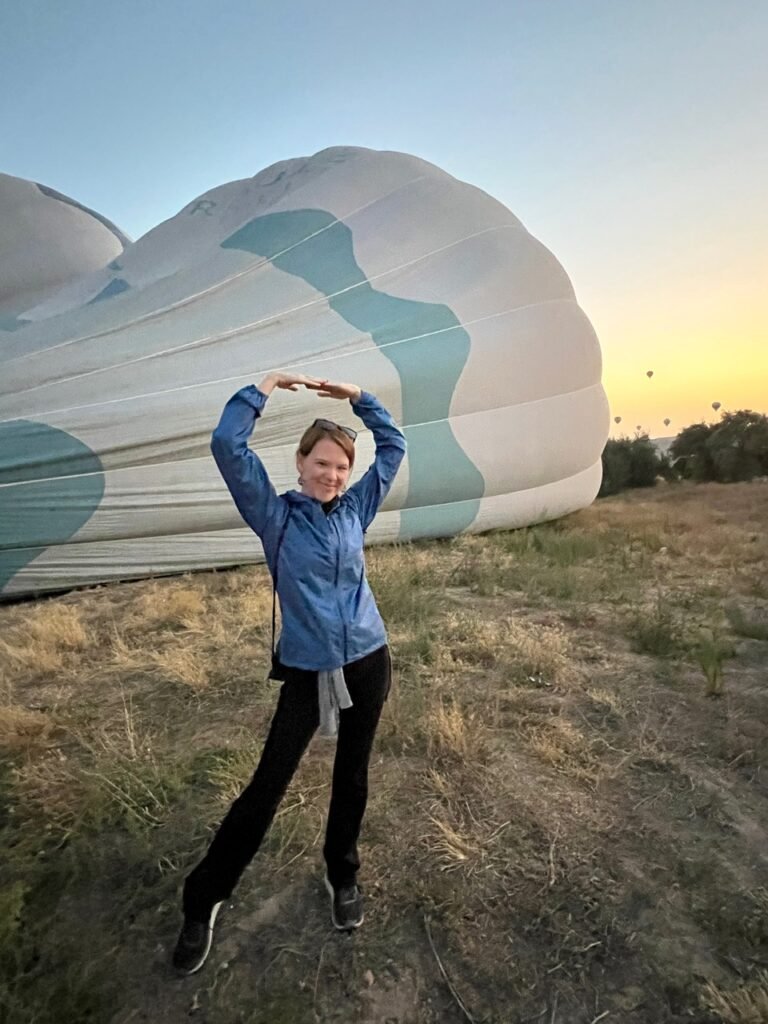
Mandy for scale, does a new signature yoga move…the “balloon pose.”
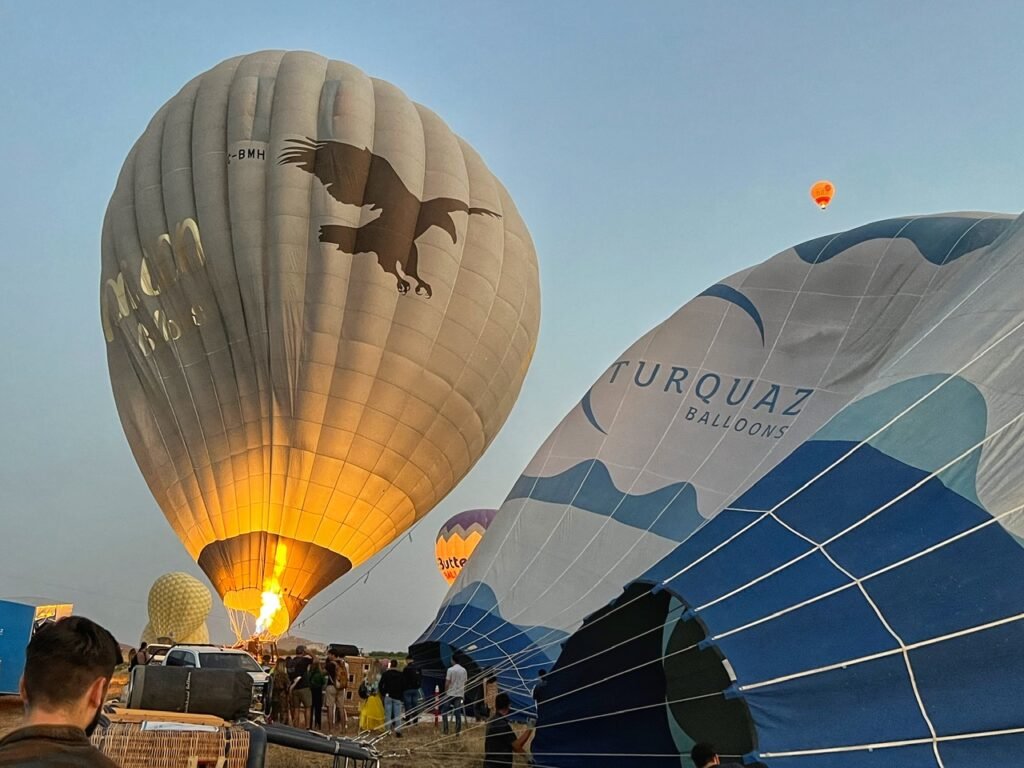
And then, the balloons nearest us started springing into action. This begins with a blaze of inferno being blasted into the balloon for a few hypnotic minutes. Then, the strong men tip up the basket and the passengers scramble aboard. It was particularly entertaining to watch the Instagirl influencers in their long flowing dresses maneuver this. ?
How many passengers, you ask? Our balloon had 16. We paid a premium to not be stuffed in like sardines up to 30 people. No, this was not a starry-eyed experience made for just Greg and Mandy. It’s possible, but that would have cost around 2500€ and we weren’t up for spending a 1/6th of our annual budget on one experience.
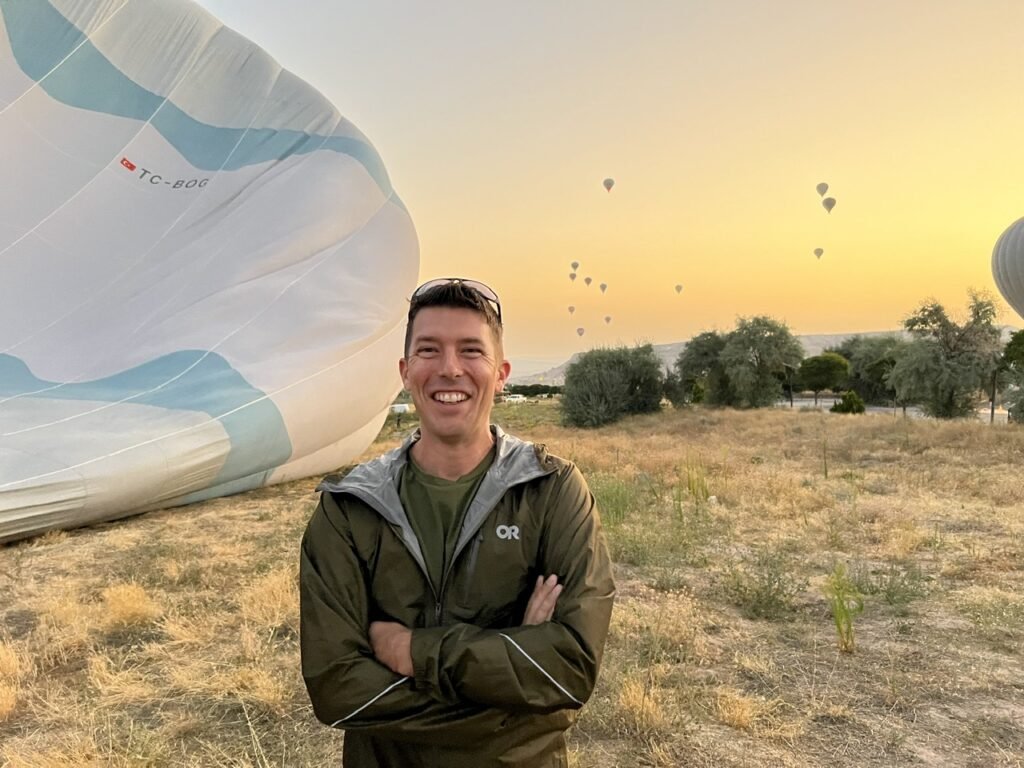
Instead, Greg happily planned on 500€ total which included the lower number of passengers, breakfast, insurance, transportation and a champagne ceremony.

It’s almost our turn!!
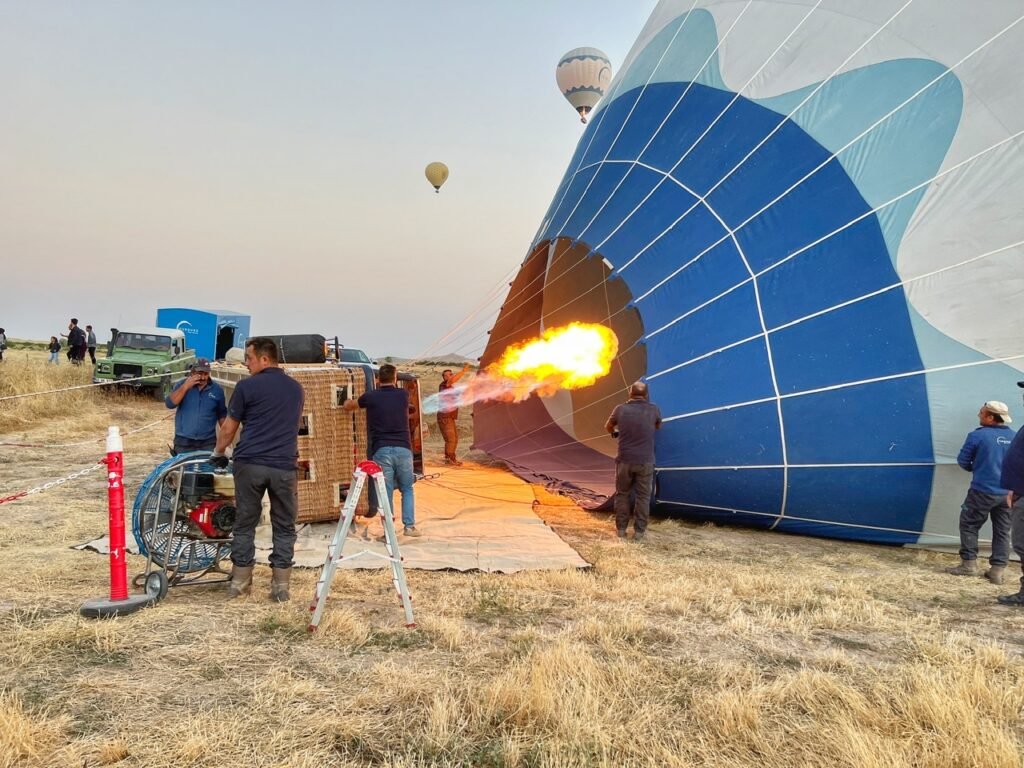
Yes!! Here comes the fire!!

The basket quickly tipped and we were kerplunked into the basket one by one. Our balloon box included the British honeymooners and a solo female from Oz. (The country, not aforementioned Wizard-land.)
Having never been in a balloon, we didn’t know to expect such heat. In fact, Mandy was ludicrously overdressed in three layers because the early morning air temperature was 60 F/ 15 C and she can’t stand being even slightly cold. It turns out, that was a wee bit unnecessary ?
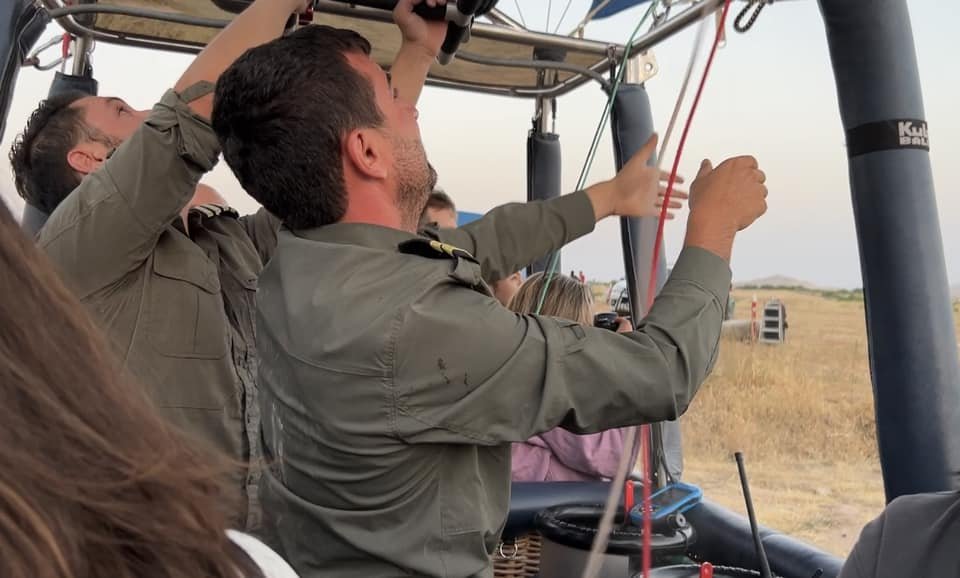
Ali Apple and Co. then gave us our safety instructions which included 1) Watch your phones and cameras 2) How to squat for launch & landing and 3) Don’t jump. Please. The insurance does not include such idiocy.
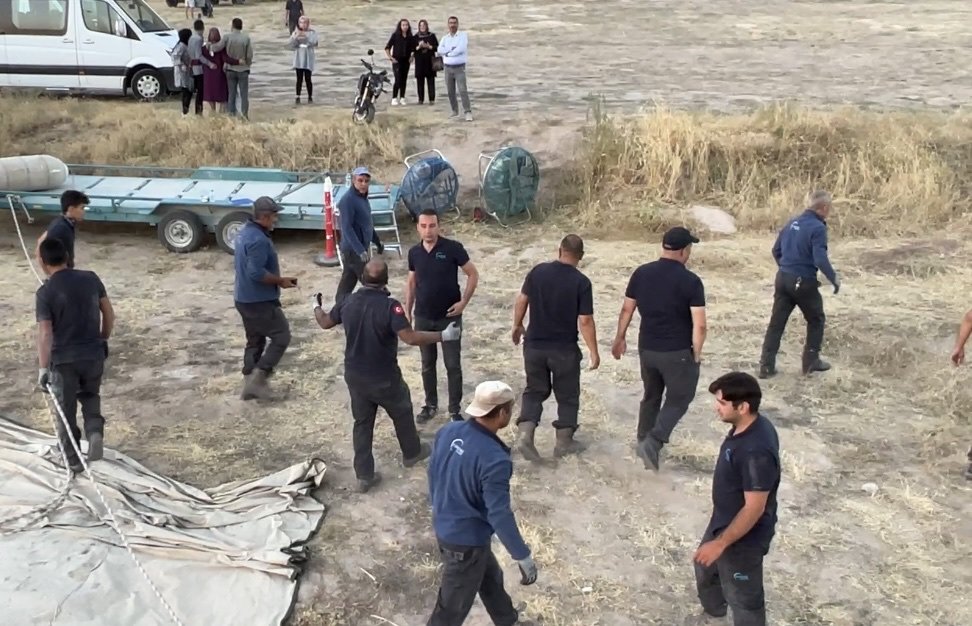
Once the balloon is fully engorged, a team of about 10 men surrounded the balloon to steady and steer us. We were instructed to squat, which is when it got pretty rocky and rolly as they navigated the takeoff. The men dispersed like ants under a footfall as soon as we lifted off the ground.
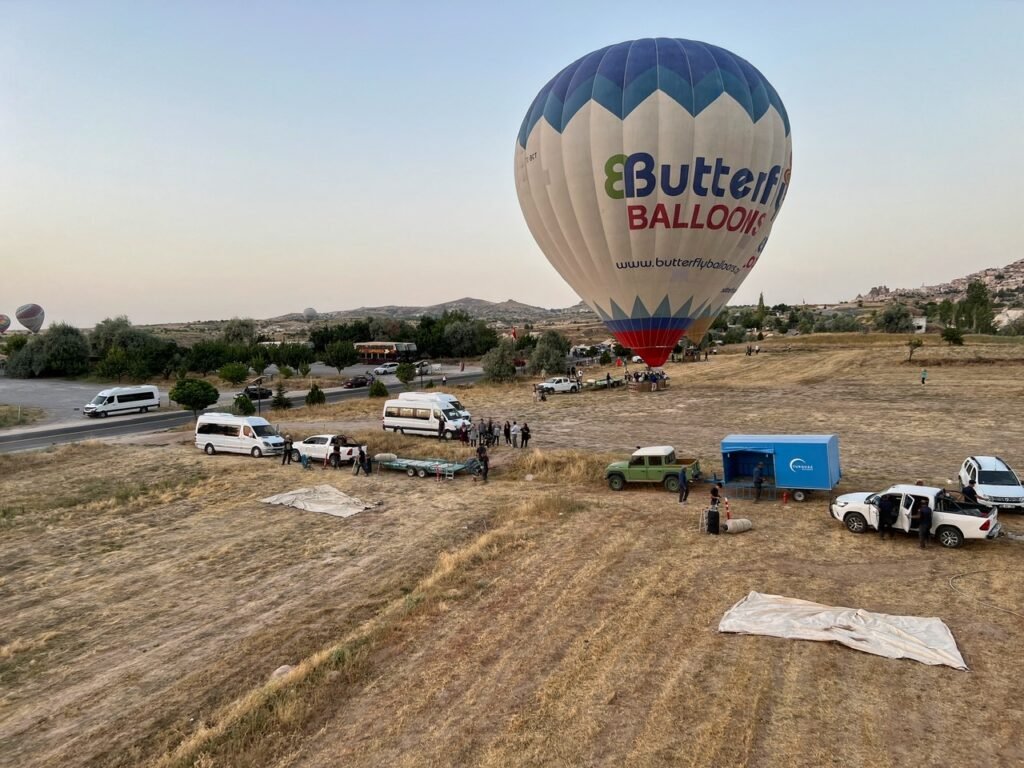
We’re floating!!! Wowza!!!!
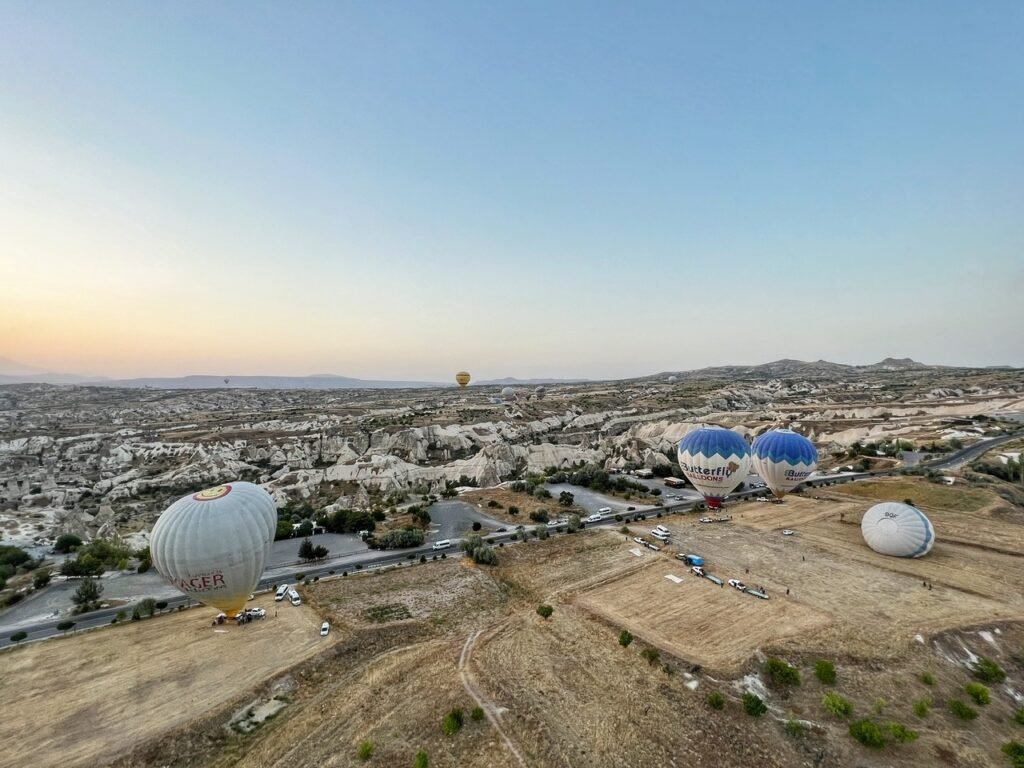
Hot air balloons naturally rotate in the wind, but the pilot cannot negotiate where it goes. He can only control it going up and down.
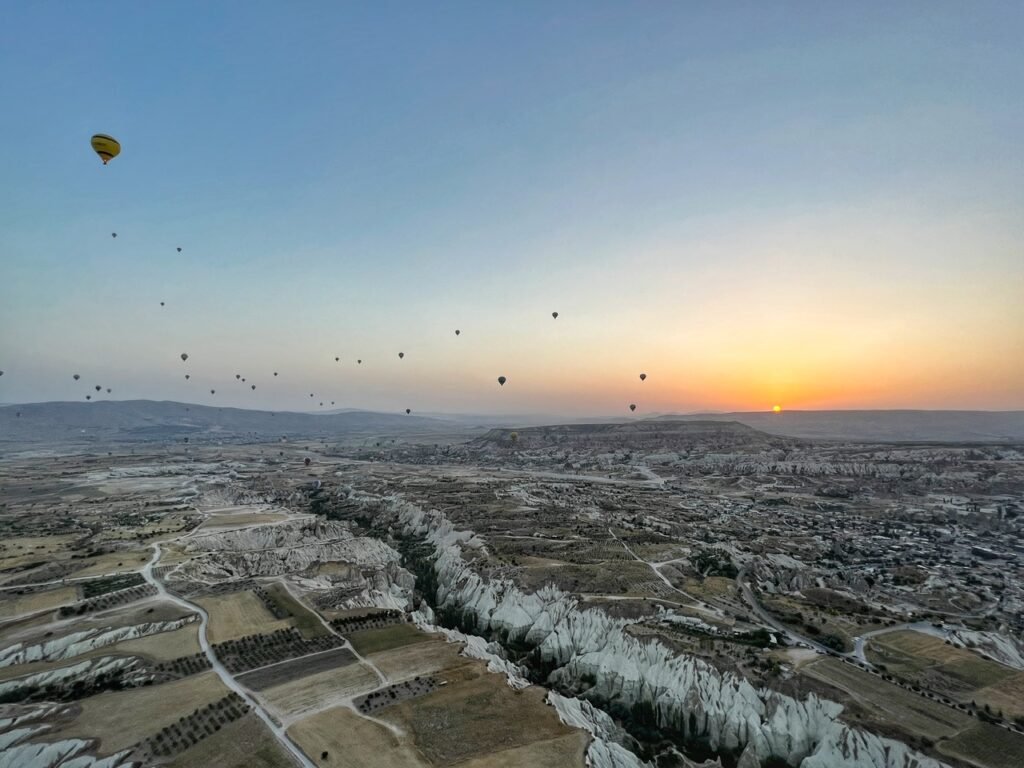
And on the next rotation, we greeted the sun in all her morning glory.
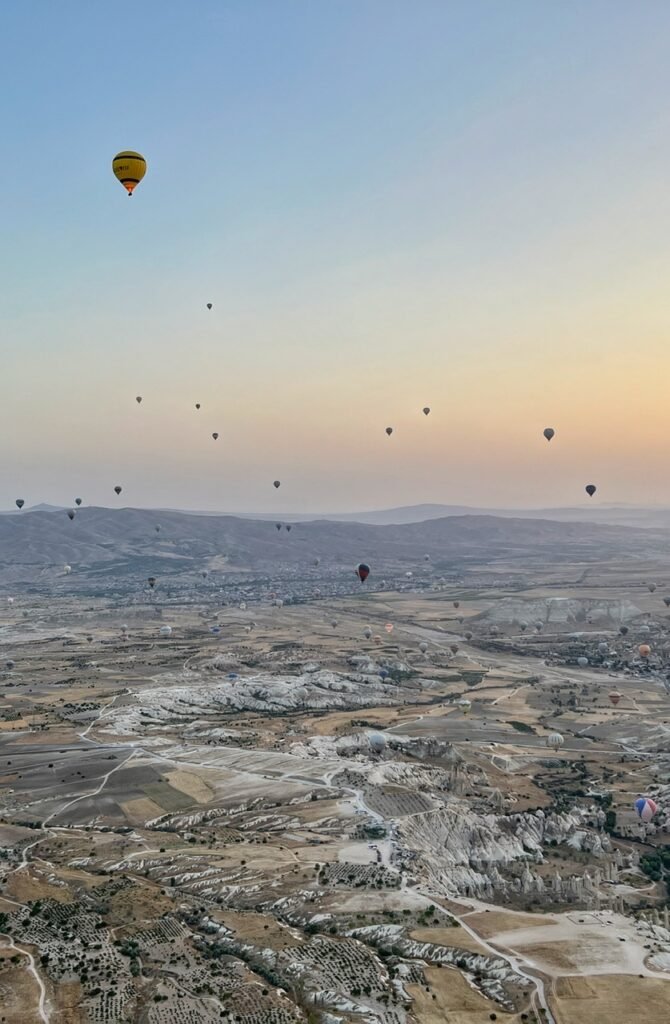
We could also see, we were far from alone.

Eventually we soared to an altitude of 950 meters or 3100 feet.
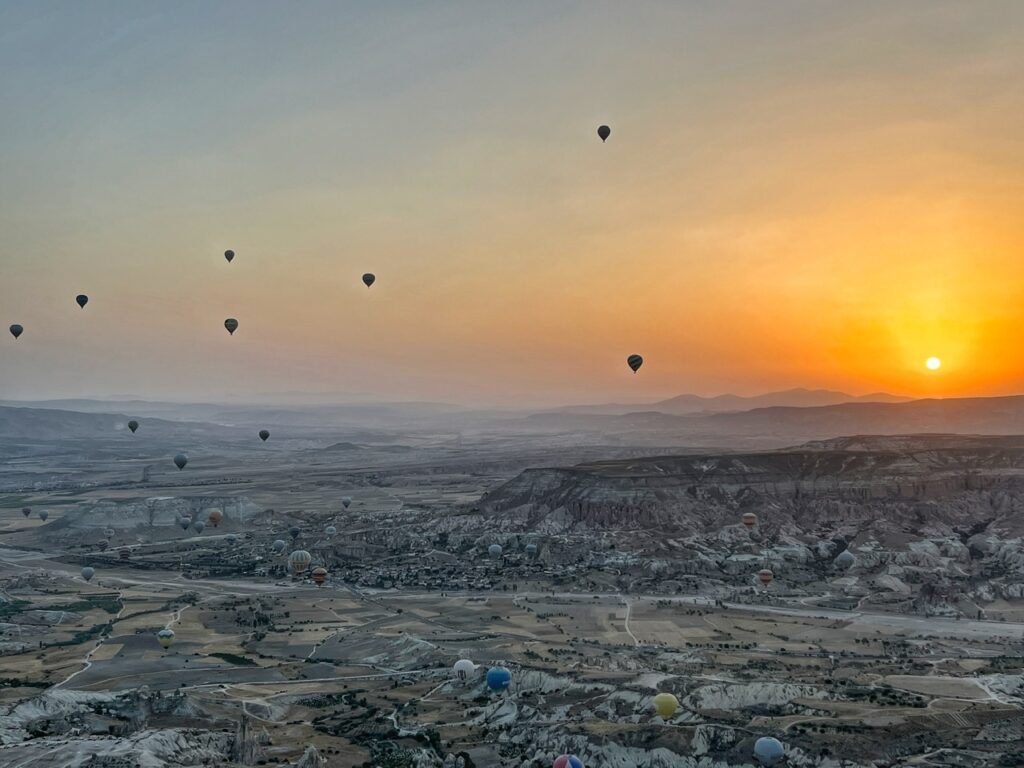
Truly indescribable.

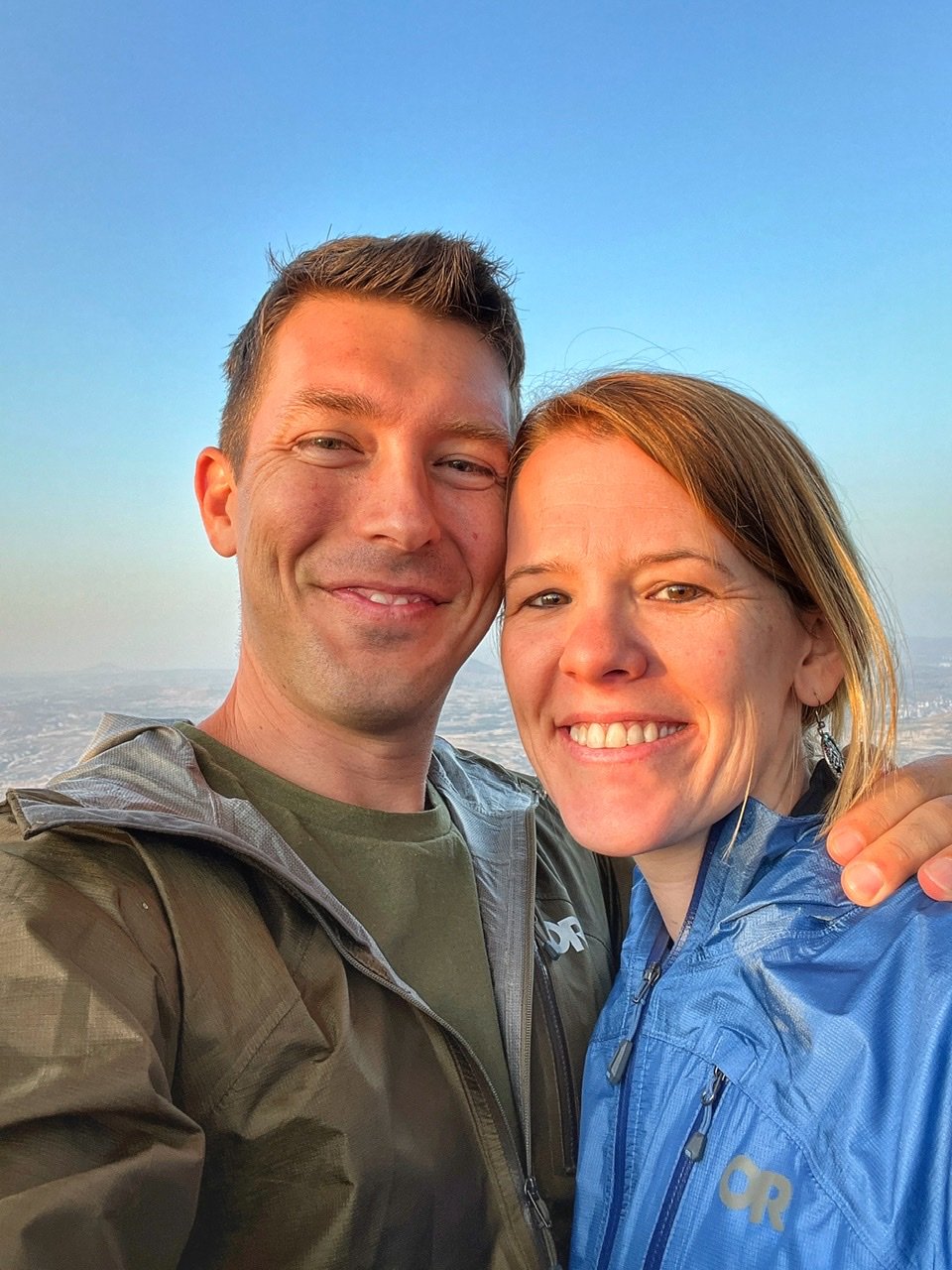

And it appears that we’re all alone. We weren’t. ?

Peering down…
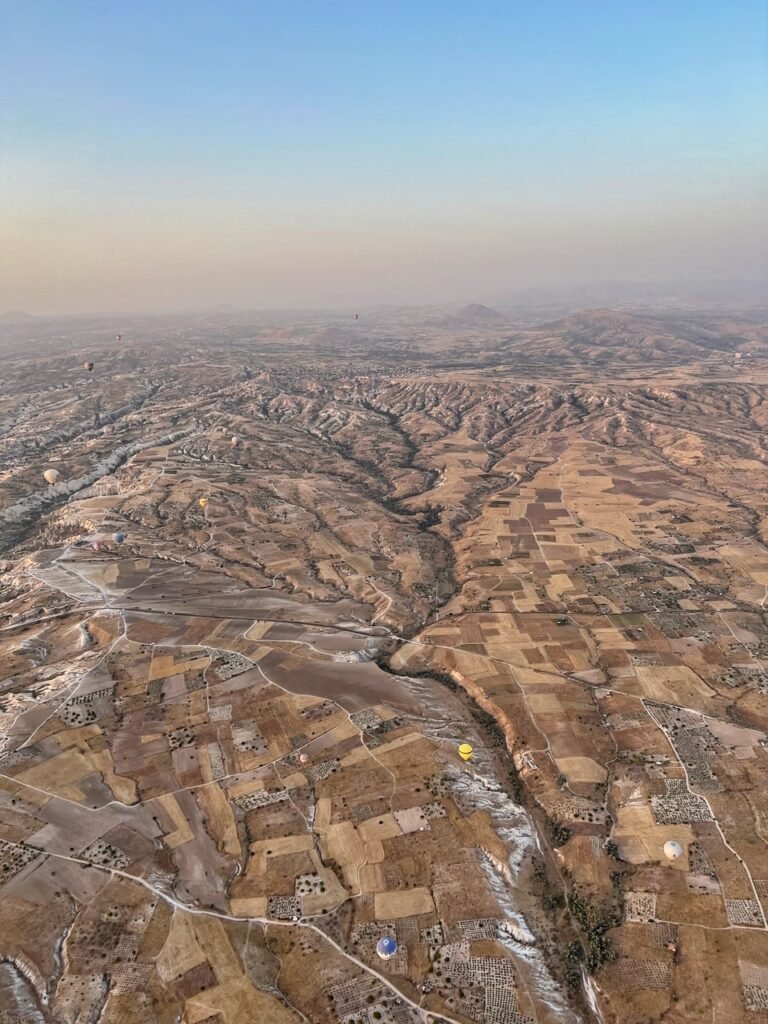
…the landscape is simply magnificent. Craggy canyons collide with organized farmland and rock towers.

For some reason it was even more dreamy gazing down at other balloons below us.
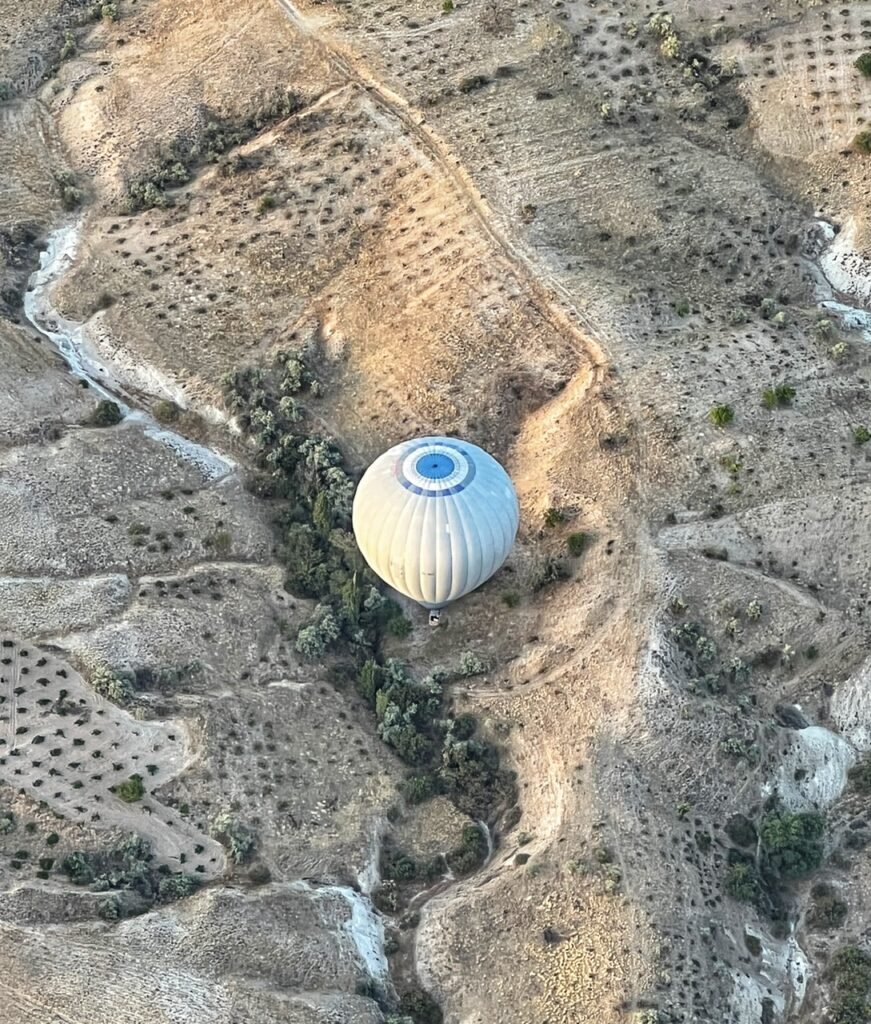
Especially this one. The Turkish Eye sitting atop this balloon couldn’t have fit the backdrop any better. This talisman, (with its own emoji ?) is said to protect against the evil eye. The evil eye is a curse or legend believed to be cast by a malevolent glare, usually given to a person when they are unaware. Many cultures believe that receiving the evil eye will cause misfortune or injury. (Thanks Wikipedia)

Mandy soaking it all in.

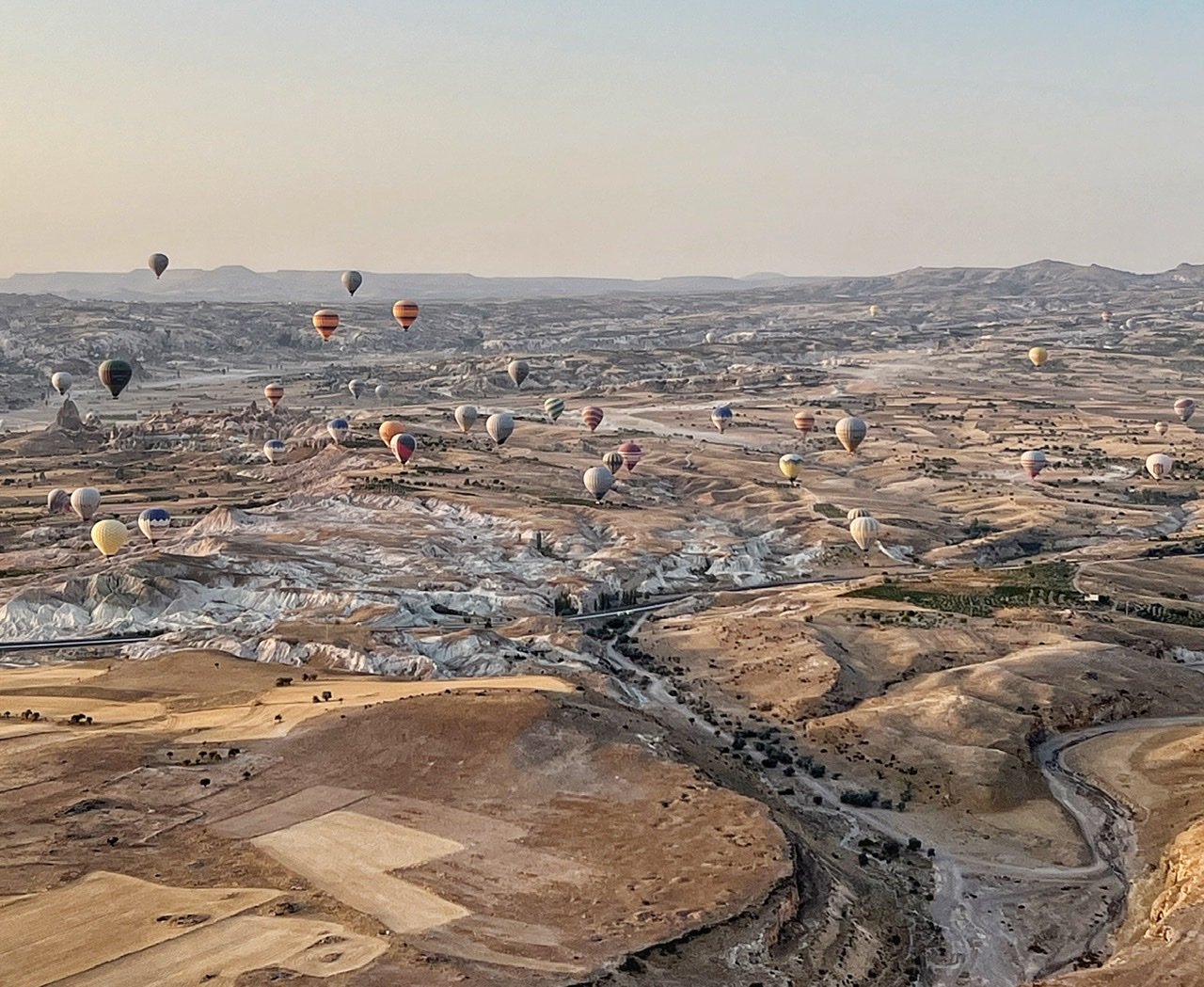
Coming in for a landing about 45 minutes later. That said, every balloon lands pretty much where it desires, according to the wind. The vans shadow the pilot and are ready to navigate seemingly any rough landscape to welcome us. We were again instructed to get in squat position and brace for landing which was a bit bouncy, and sounded like grinding metal as the mighty basket cage sloppily kissed the harsh and rocky terrain. Whew! We made it ?
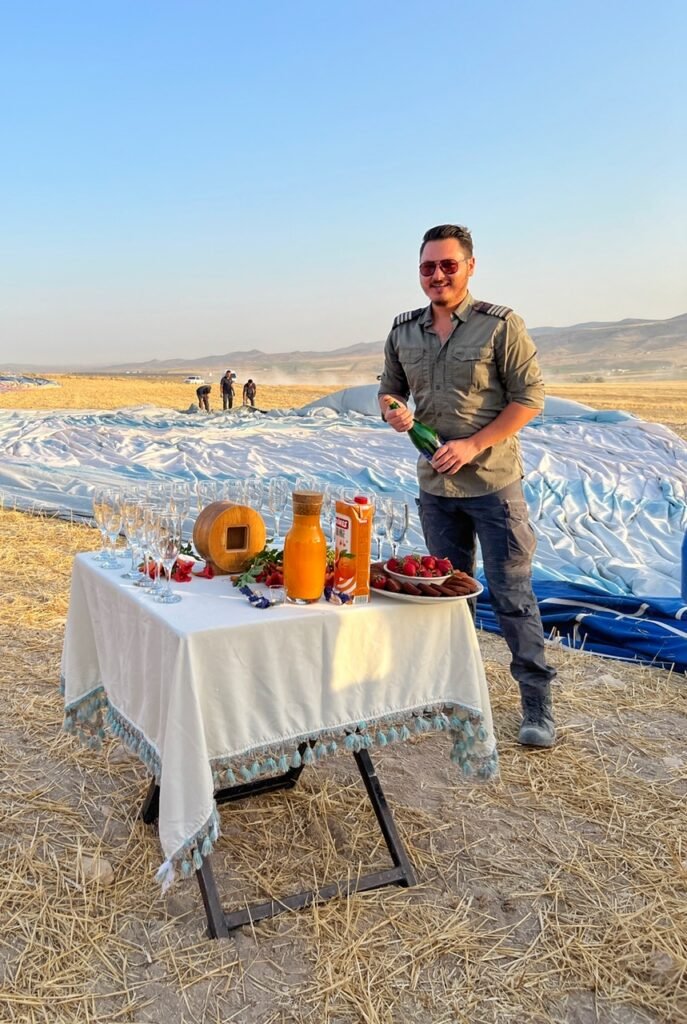
We toppled out of the basket with less swiftness than coming in, our legs feeling a little jello-y. We were immediately greeted by Ali Elma Apple, who had just completed his 1700th flight. He said “Hoşgeldiniz!” (welcome) and was ready to kick off a strawberry, chocolate treats and a champagne toast.

Apparently this champagne toast was not just a way to charge us more. There was actually a historical reason for such pomp and circumstance. According to Mental Floss, “as hot air balloons became a fad, French aristocracy soon learned that local farmers didn’t much like rich people setting balloons down on their land. The aristocracy said the peasants were afraid because they thought the balloons looked like dragons, but while the smoke that powered early balloons may have appeared dragon-like, it seems more likely that the farmers didn’t want hot air balloons crushing their crops. In any case, champagne smoothed things over (ahh, France!) and a tradition was born.”
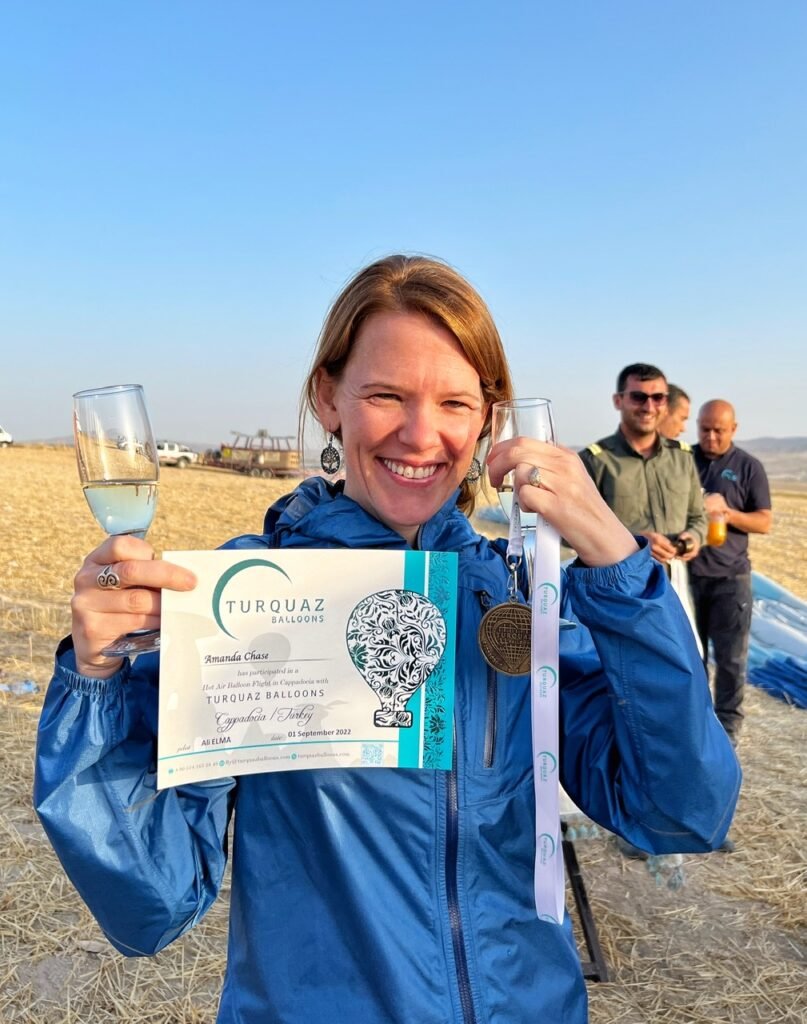
What we don’t believe they had in 18th Century France was a participation medal and award. This was just for 21st Century Millenials.
Göreme Open Air Museum
Here’s the church, where’s the steeple, open the doors and there’s a lot of tourist people.

The Göreme Open Air Museum, a 20 minute walk from the town, is one of Cappadocia’s UNESCO sites which showcases a complex of incredibly ancient churches with frescoes dating from 2nd Century. This area was one of the first to embrace Christianity and the monks of Cappadocia can take immense credit for spreading the word of Jesus to the rest of the world.
It costs 100 Lira or $5.50/enter and is best visited at the beginning or end of the day to avoid the bus loads of aforementioned people. It is, after all, Cappadocia’s number one tourist site. In hindsight after seeing many more stunning features in Cappadocia’s Red Valley and other places for free, we would have probably skipped this. Ah well.
Anyhow, this place is proof that worship doesn’t need to be elaborate. Some of the world’s first churches, which obviously look nothing like modern day churches, were carved into volcanic rock. By the end of 2nd Century, a large Christian community had formed here.
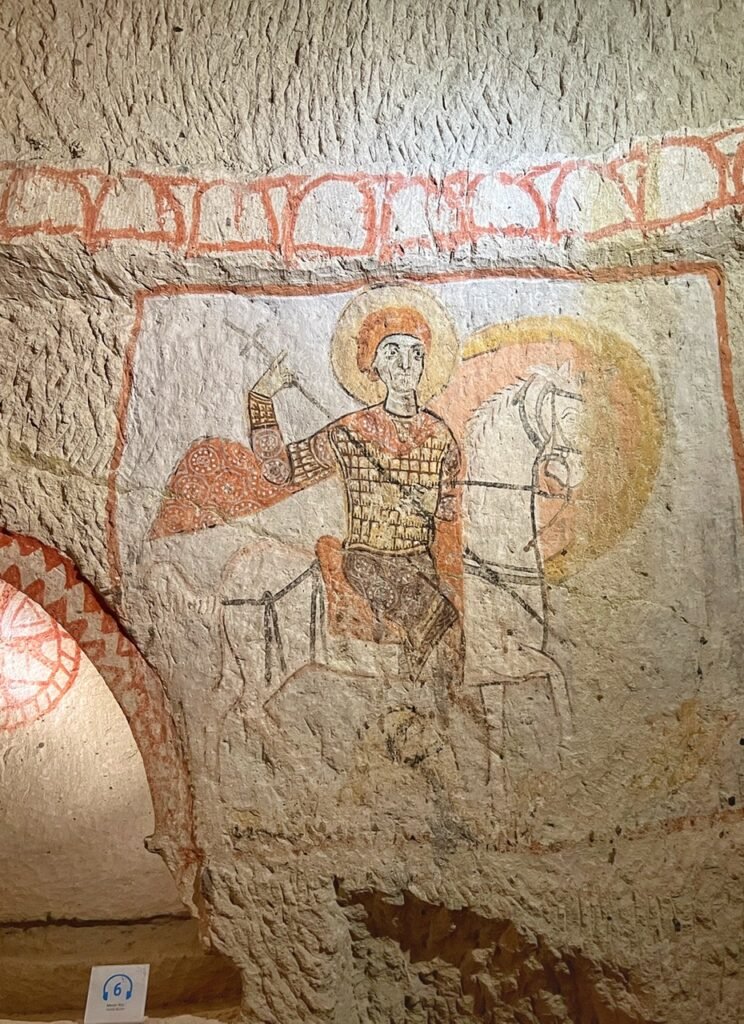
There are frescoes everywhere of saints, some dating even further back into 3rd Century BC.
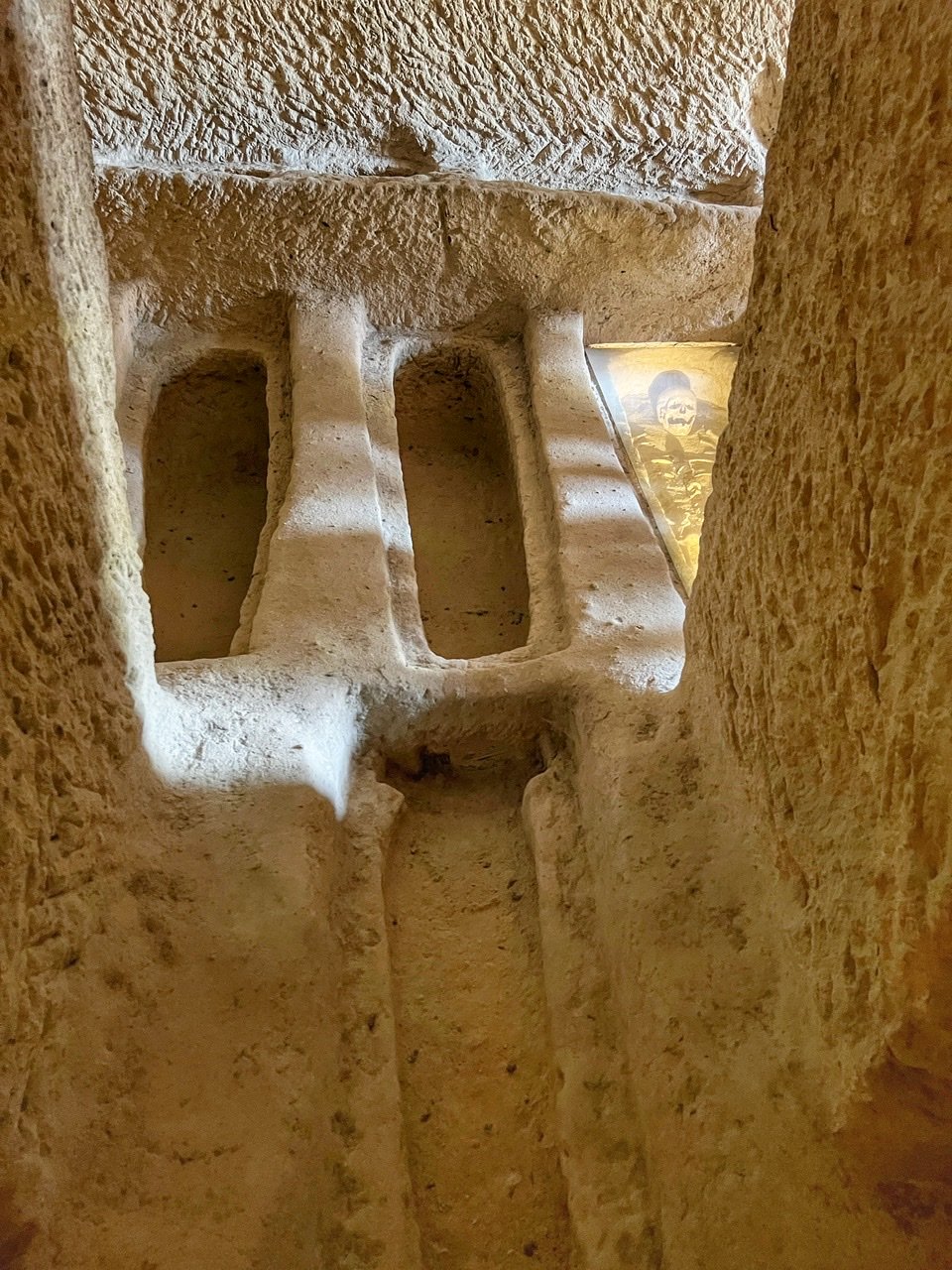
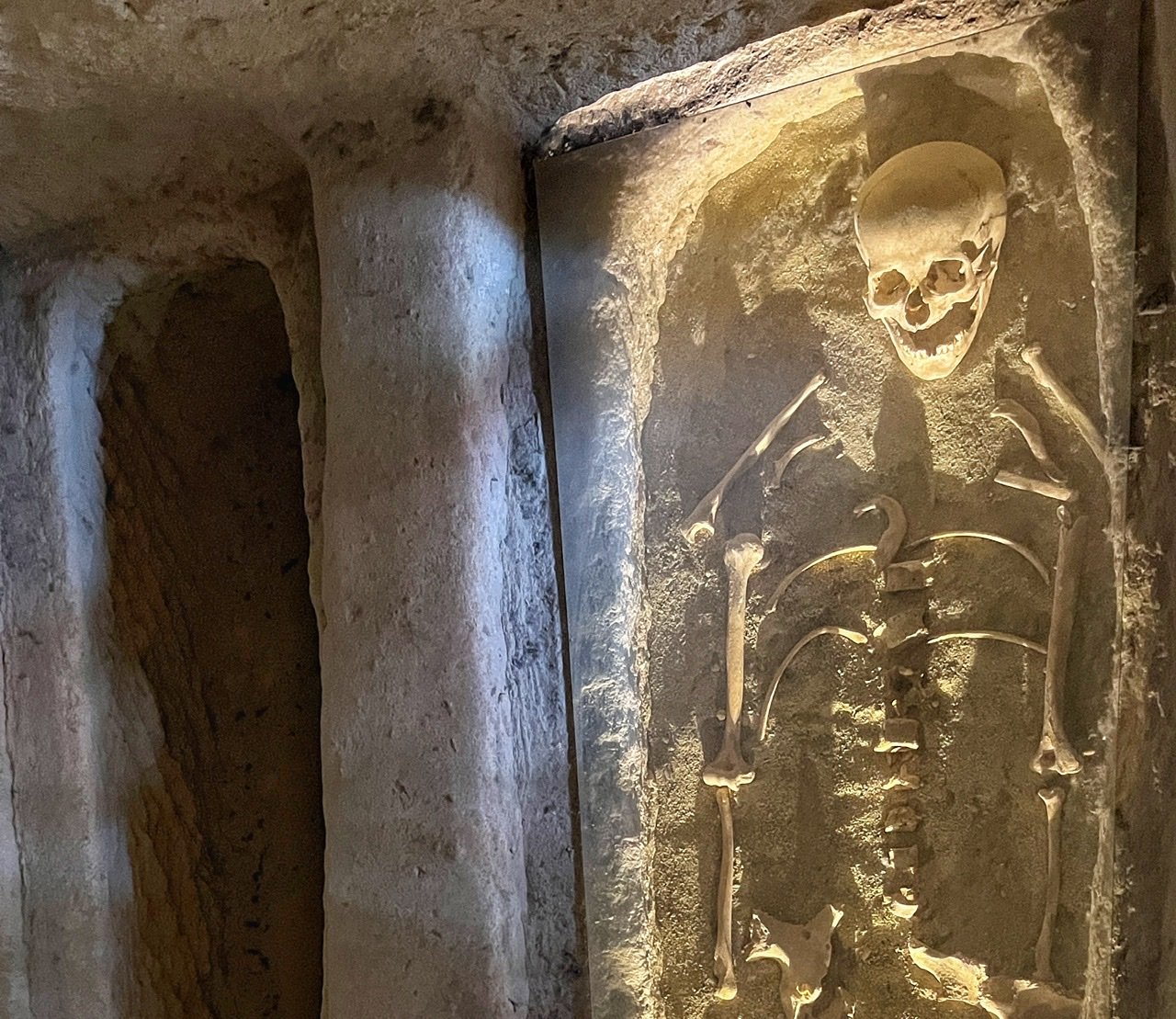
In St. Basil Chapel, you’ll find many of them were also used as crypts, which presumably belong to the people and their relatives who had contributed to the building’s 11th Century construction. At least this guy looks happy to be dead!
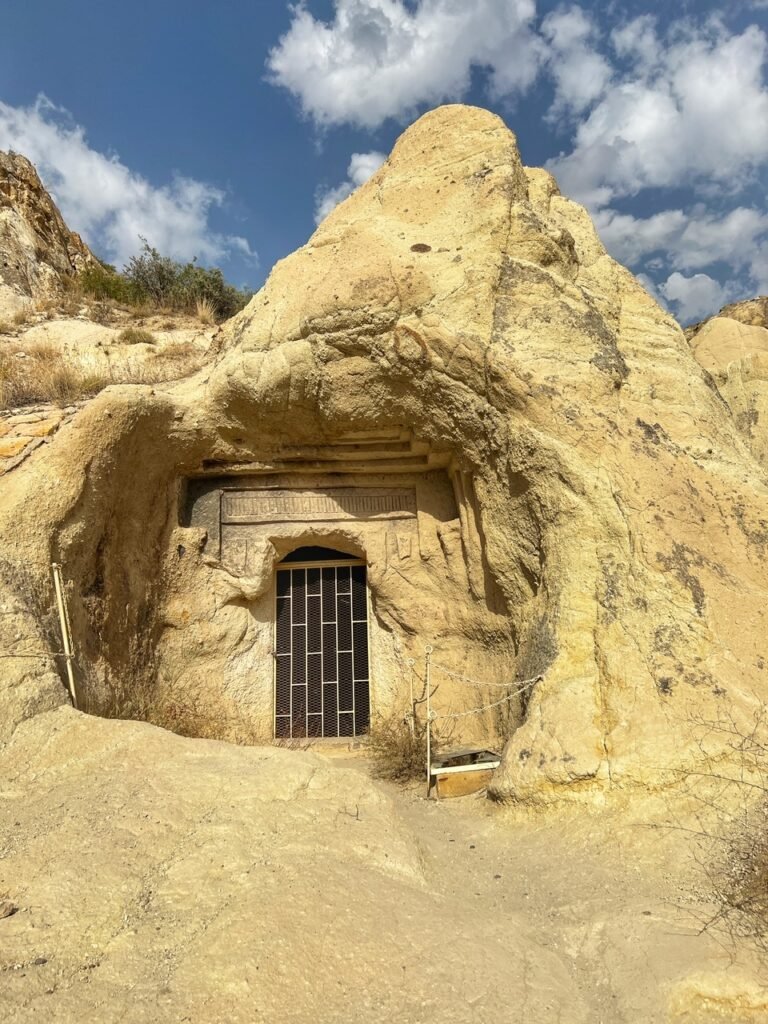
There are dozens of churches and chapels within the complex.
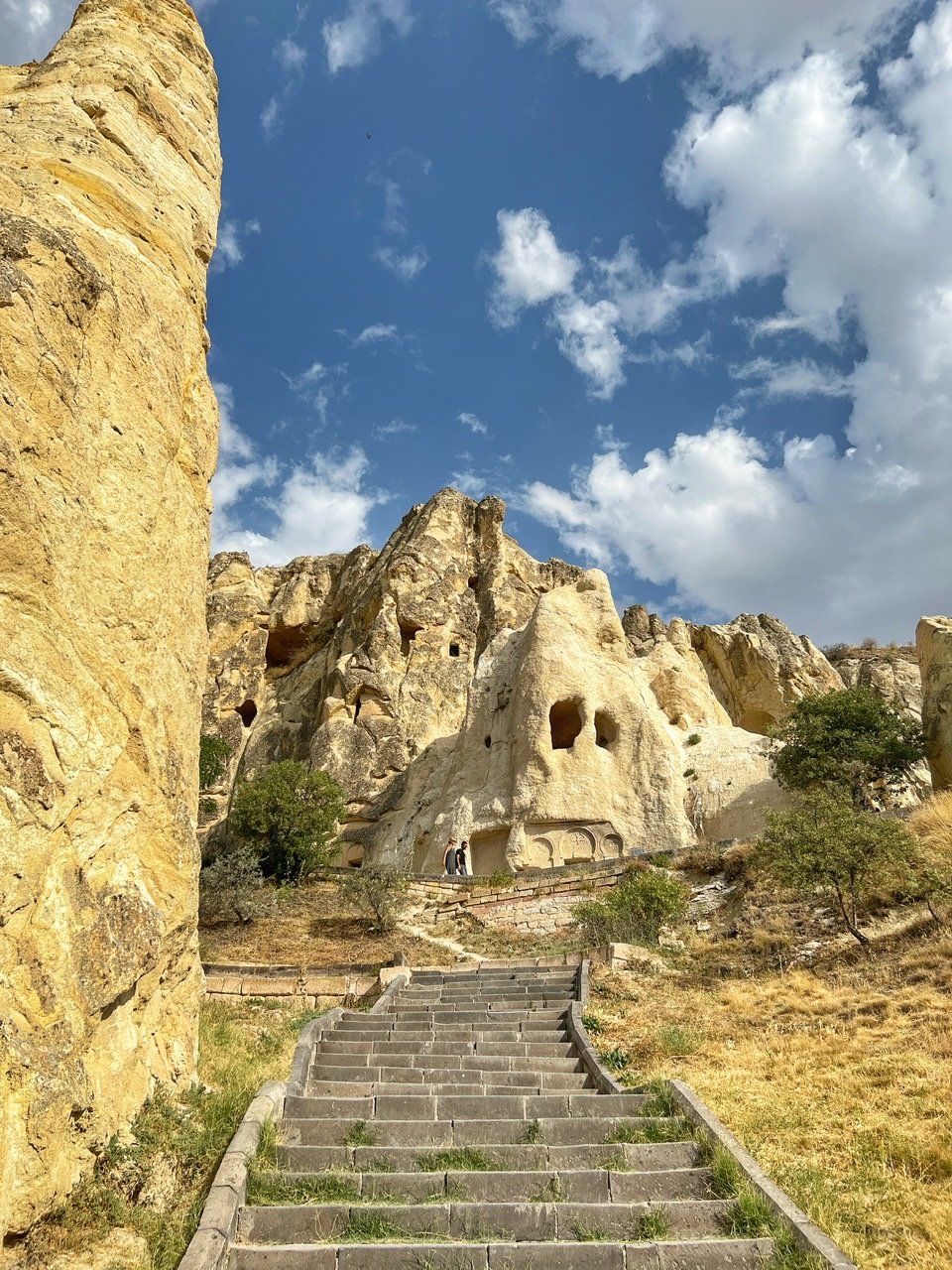
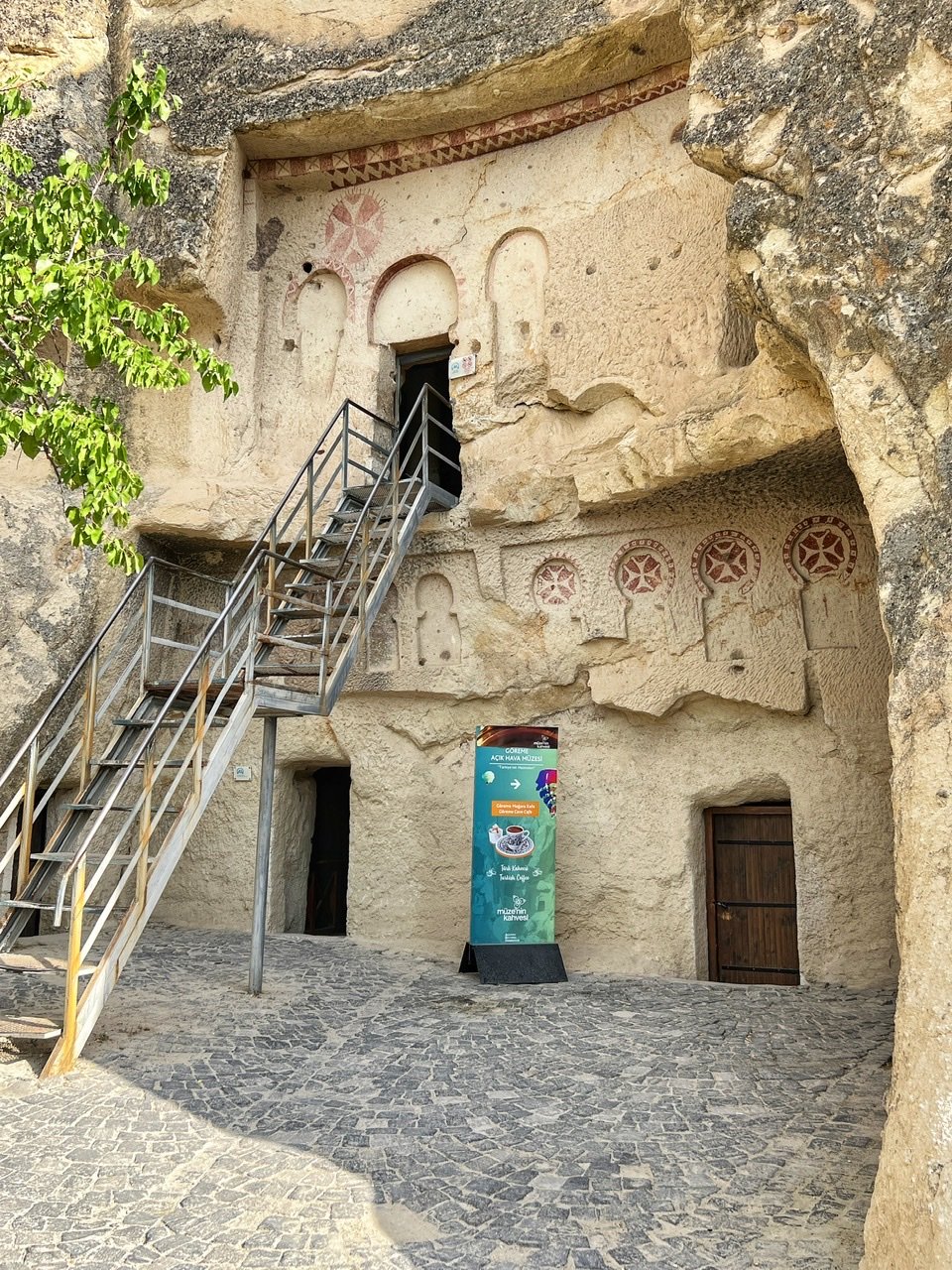
We got there late in the day and it wasn’t too busy.
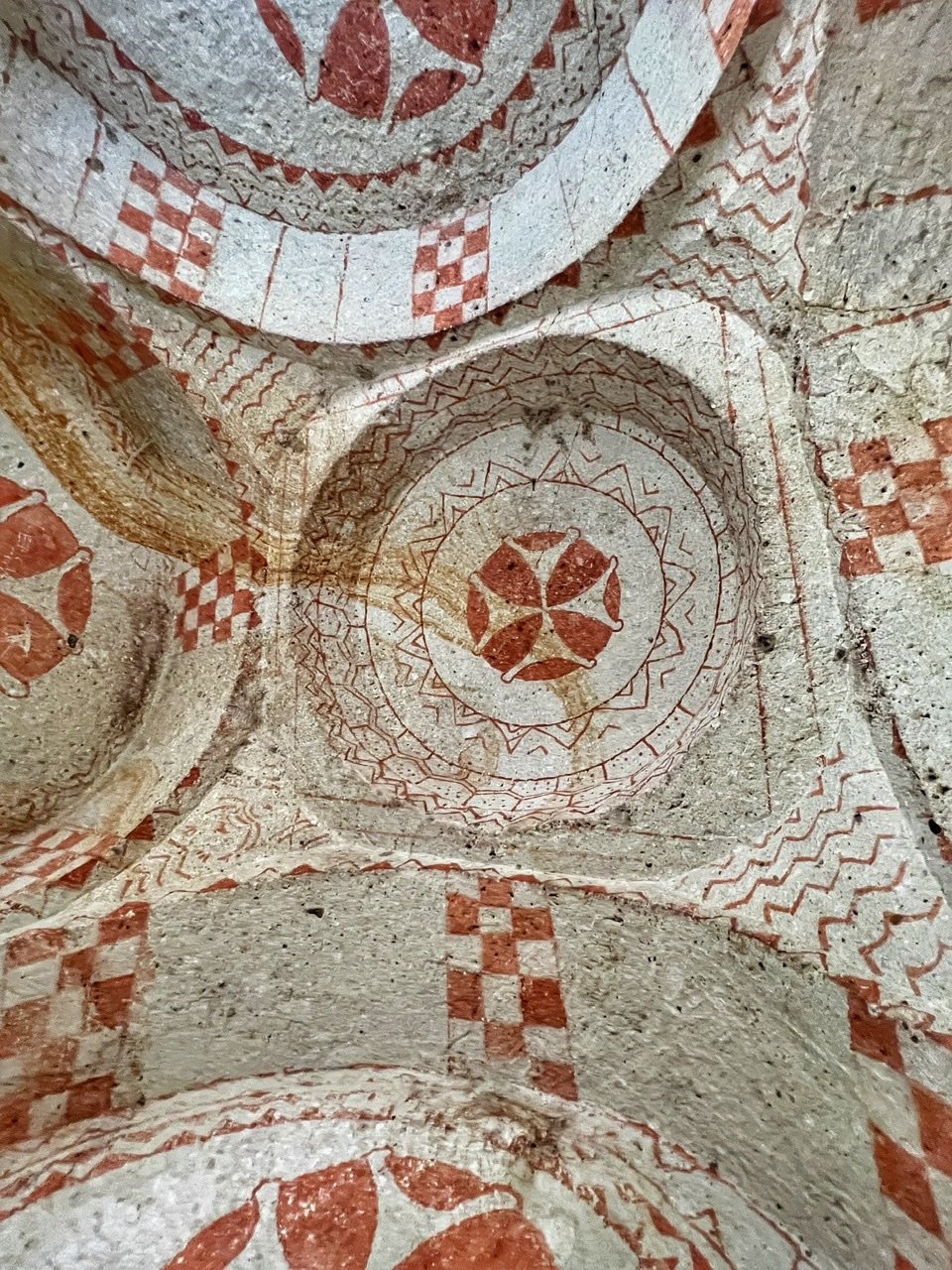
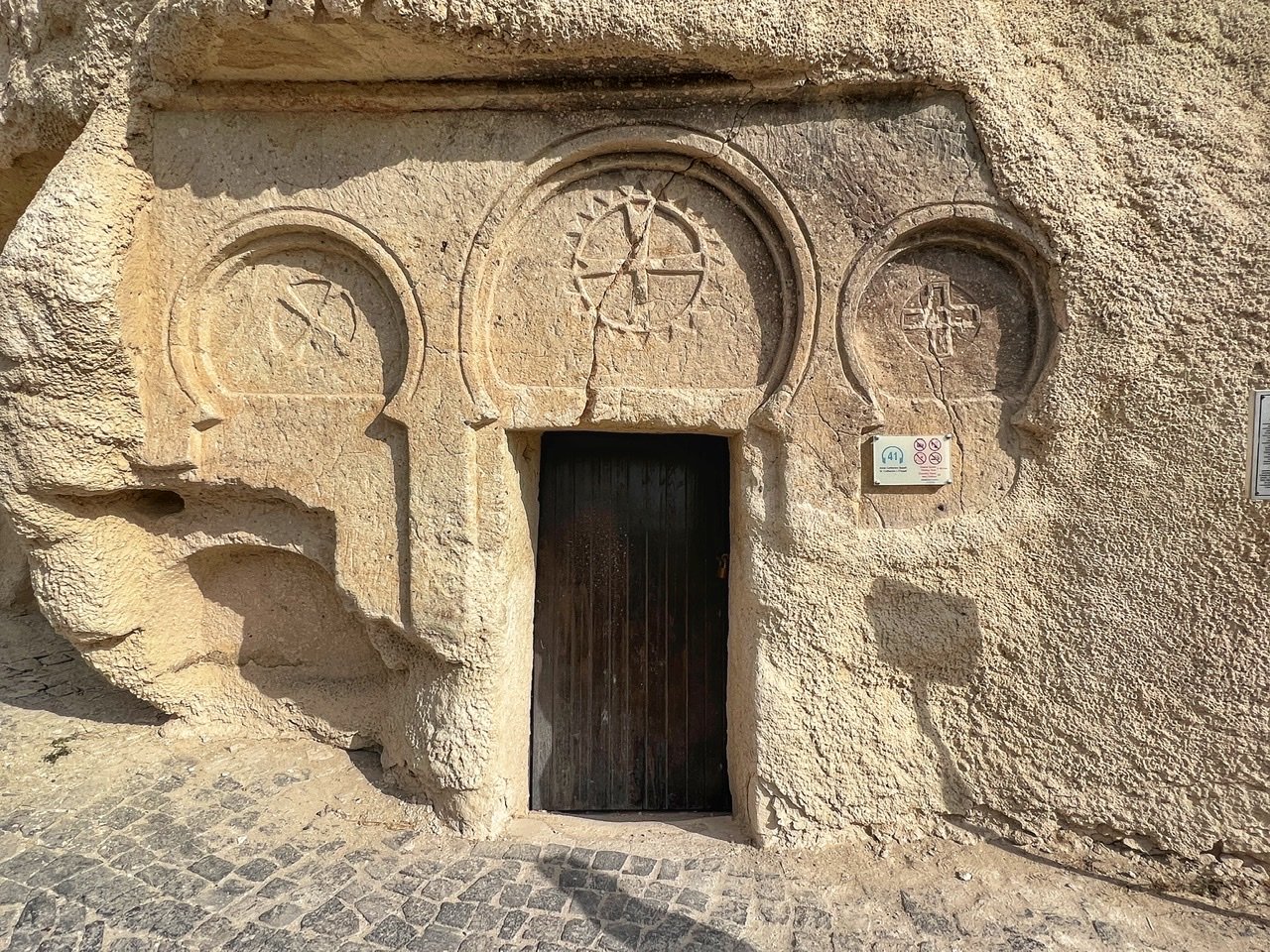
The Greek Cross adorns many of the churches, as well as the Chapel of St. Katherine
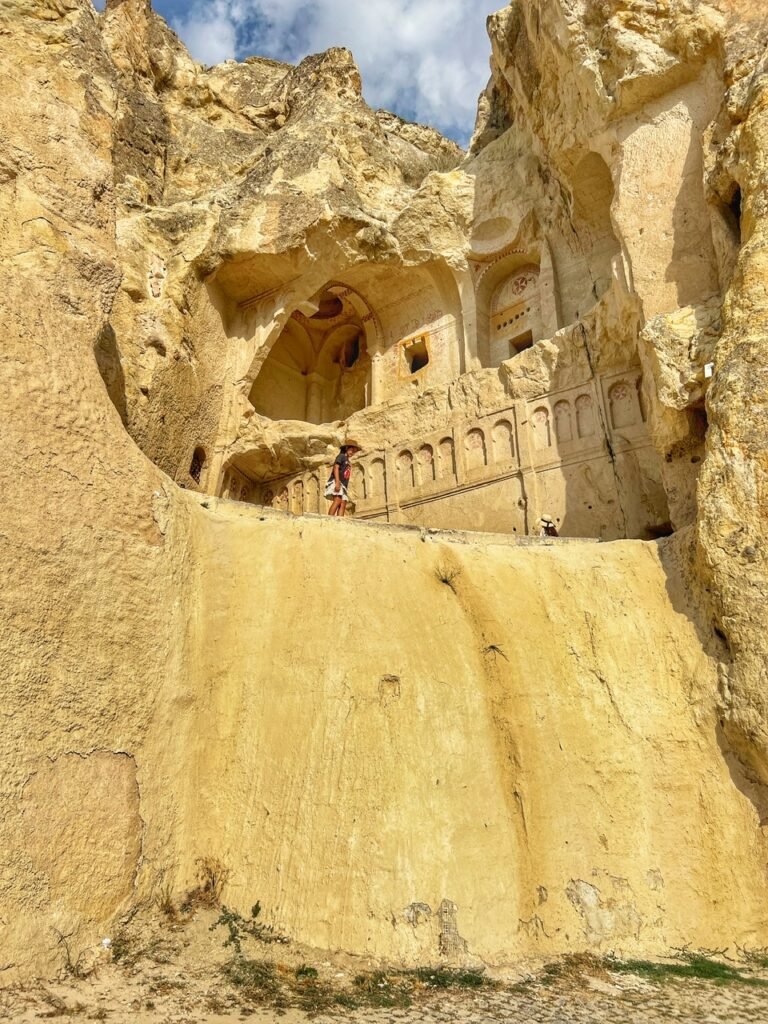
Some churches in their design felt a bit Petra-esque. One of the most notable was the Dark Church which houses gorgeous blue frescoes all over its ceiling and walls. In a further attempt to make back Liras lost during the pandemic, it costs an extra 50 Lira ($2.70) and then they won’t let you take pictures inside. While we understand this rule when cameras had flashes and could damage the frescoes, it does not really make sense these days and a bit frustrating when you pay an entrance fee. But, inside it is worth the fee and inside was truly astounding.
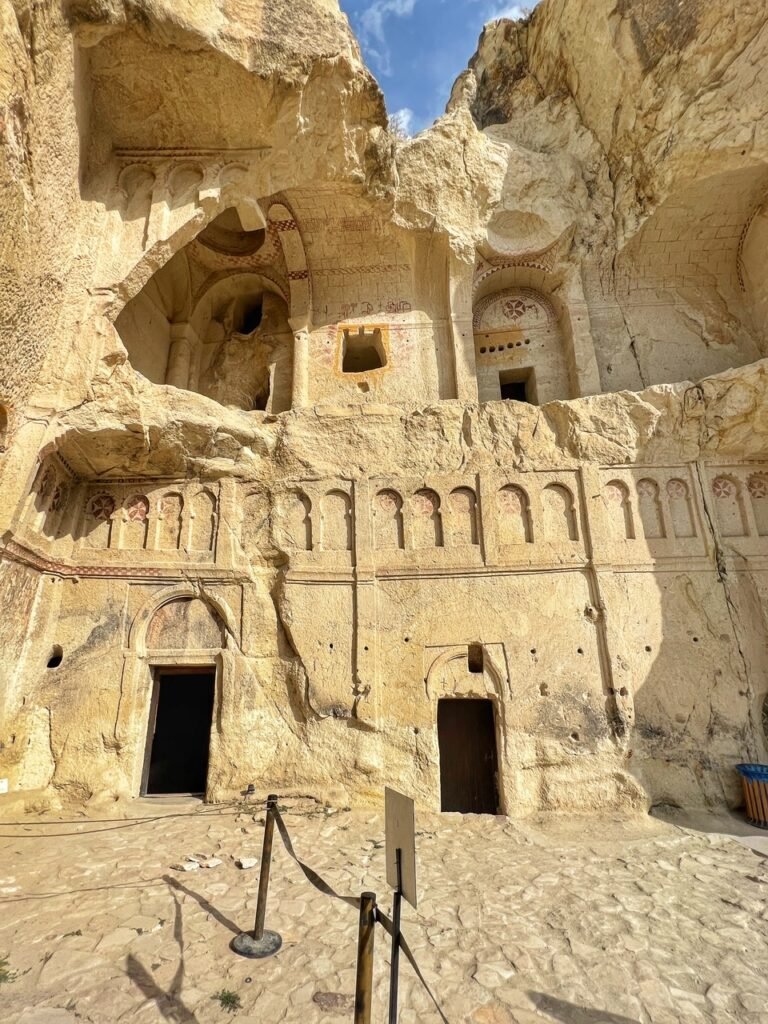
Entrances to the Dark Church.
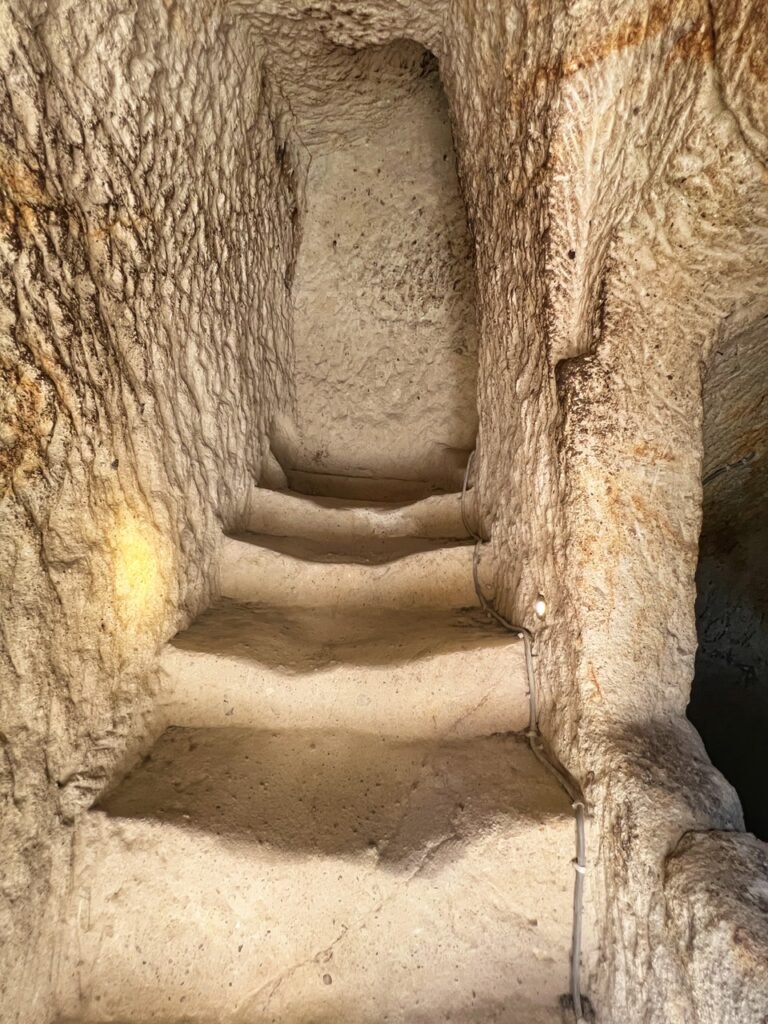
Climbing our way inside (before the guard pointed gruffly to the “no photo” sign.)

Inside Saint Barbara Church you could find something we’ve never seen. A long table with stone seats on its perimeter, said to represent the Last Supper. They didn’t feed us again, however.
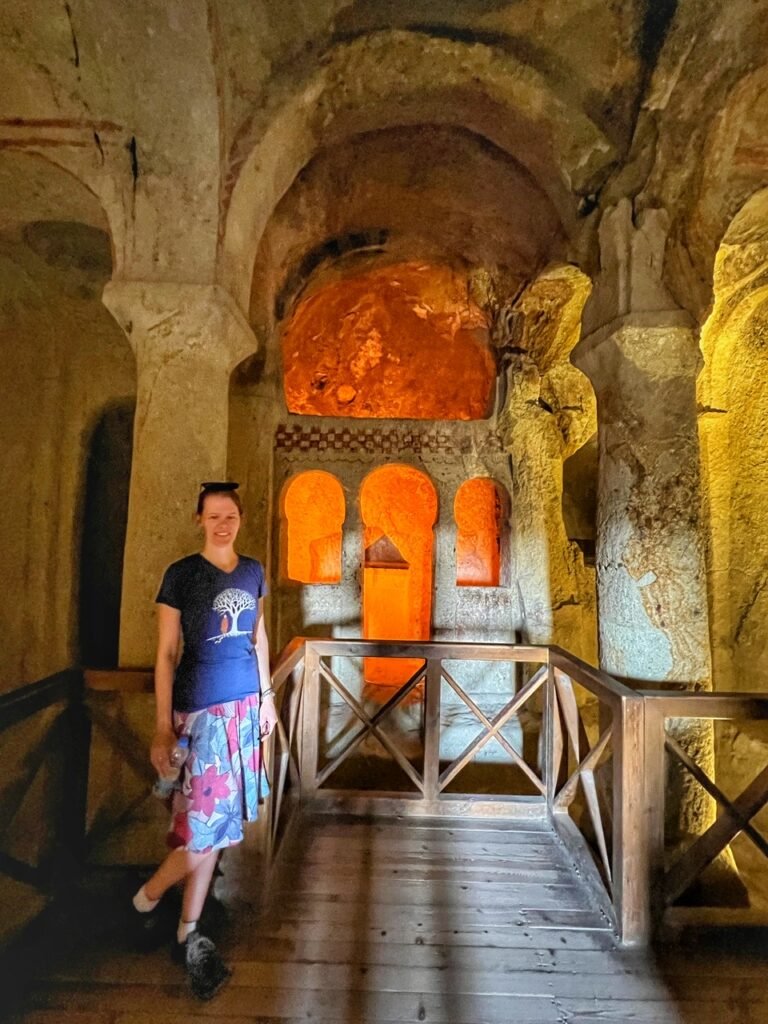
Inside Saint Barbara. As you can see, the churches are quite small. Can’t imagine how unpleasant this would be jammed with tourists.
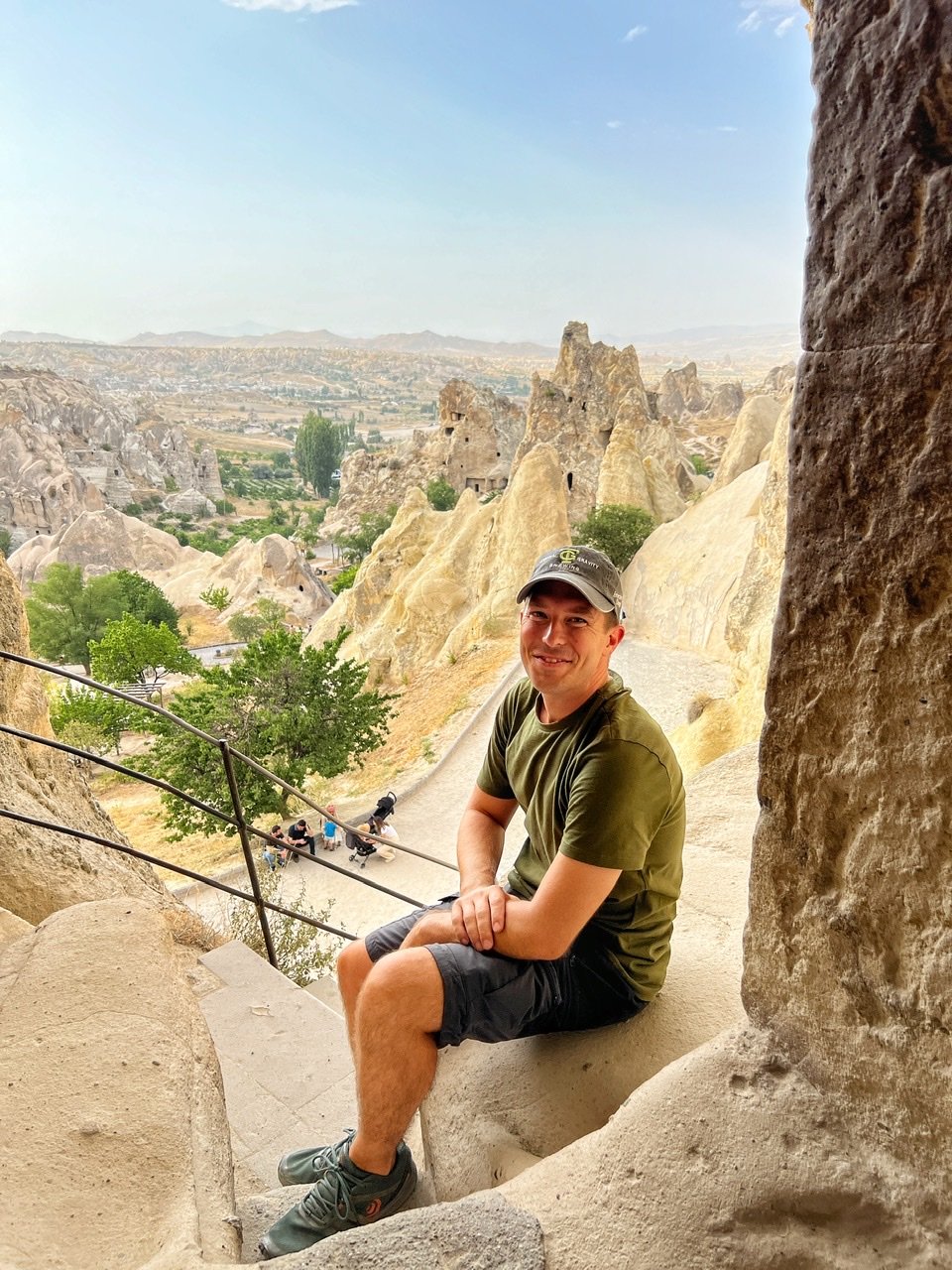
Greg taking a breather. It takes about two hours to walk through the complex.

All of these churches were connected by interior passageways.
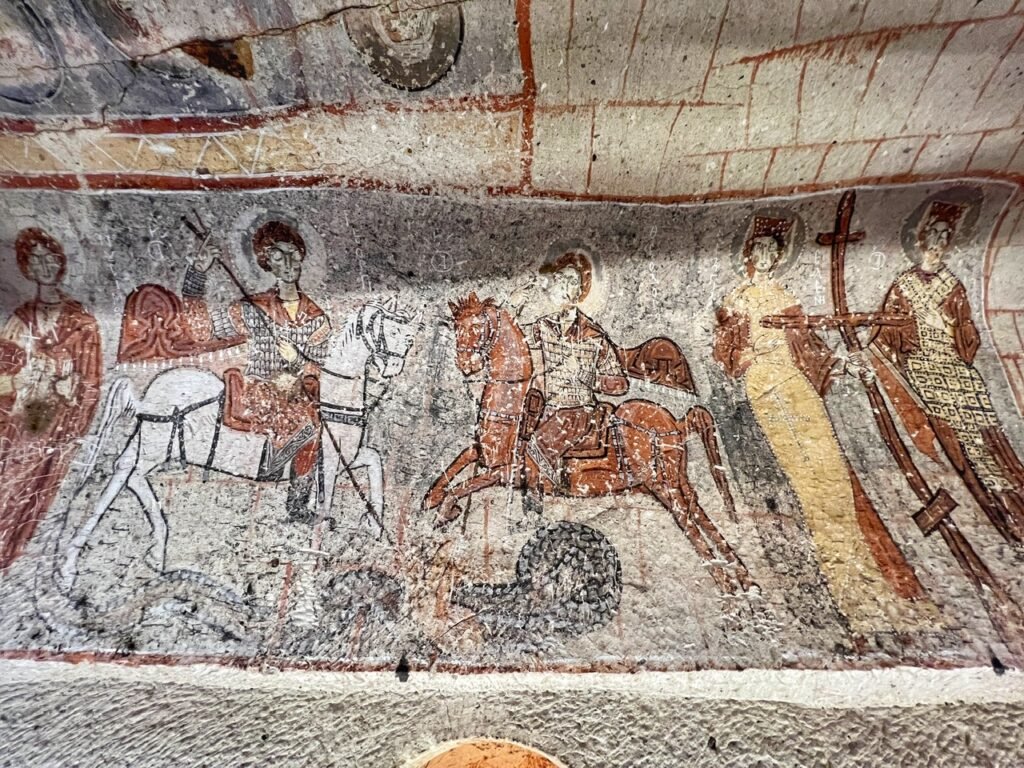
Snake Church got its name by the serpent running the length of the church, which was actually supposed to be a dragon. However, the artist must not have been a crack shot because the locals swore it was a snake. And dragons are mythical, so there’s that…

The frescoes are still quite vivid. This includes the hermaphrodite Saint Onuphrius who is depicted on the right modeling a genitalia covered palm leaf. Fun!
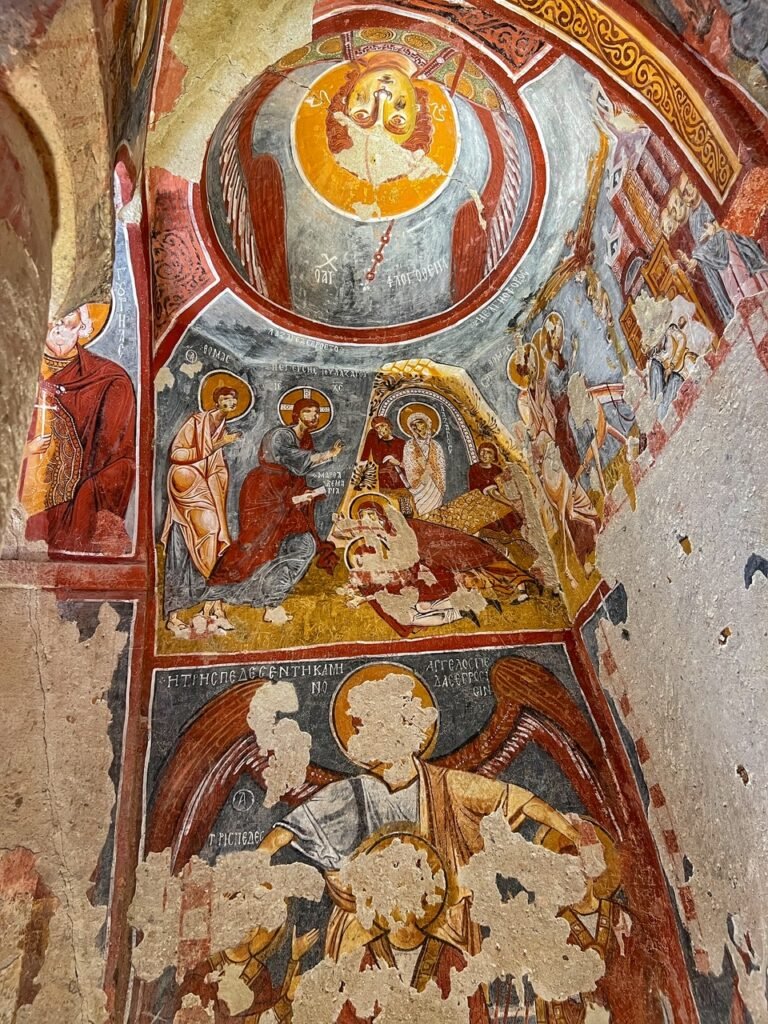
We managed to snag a photo in the 12th Century Elma Church, (another apple) which had relatively well preserved colorful frescoes. The frescoes are narrating scenes from the Bible and the life of Christ. No Adam and Eve apples were surprisingly present, but we learned that the church actually derives its name from the apple orchard which collapsed a long time ago, in front of the main entrance. (Göreme.info) Side note: Adam means “man” in Turkish.
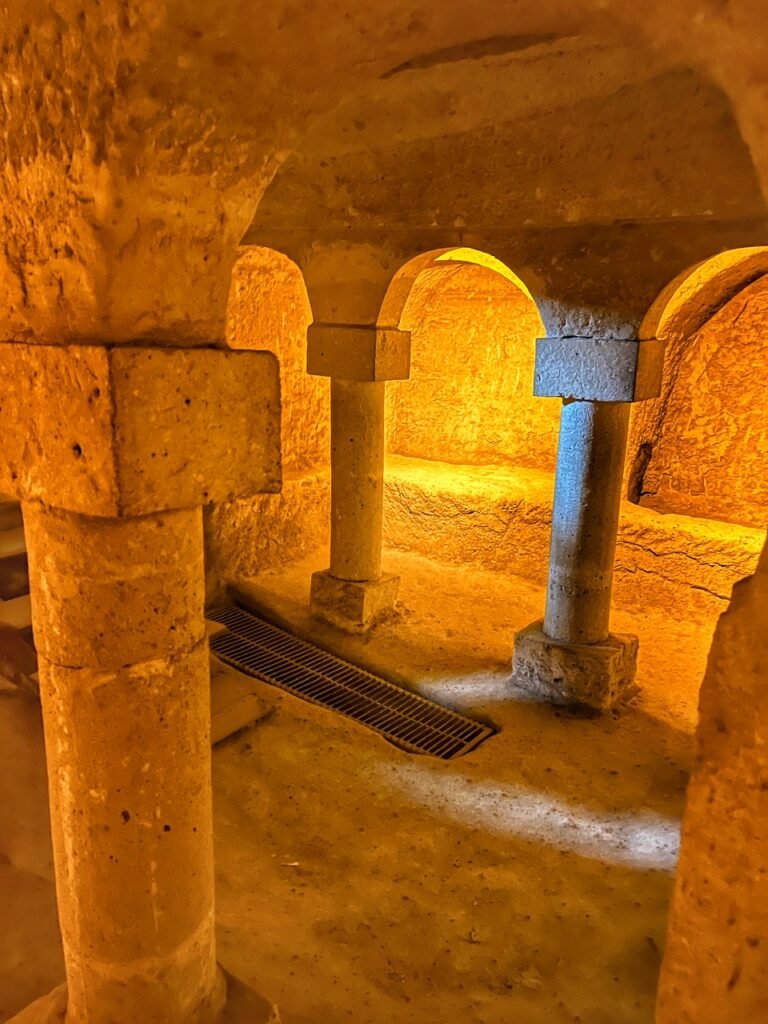
The architecture has truly stood the test of time.
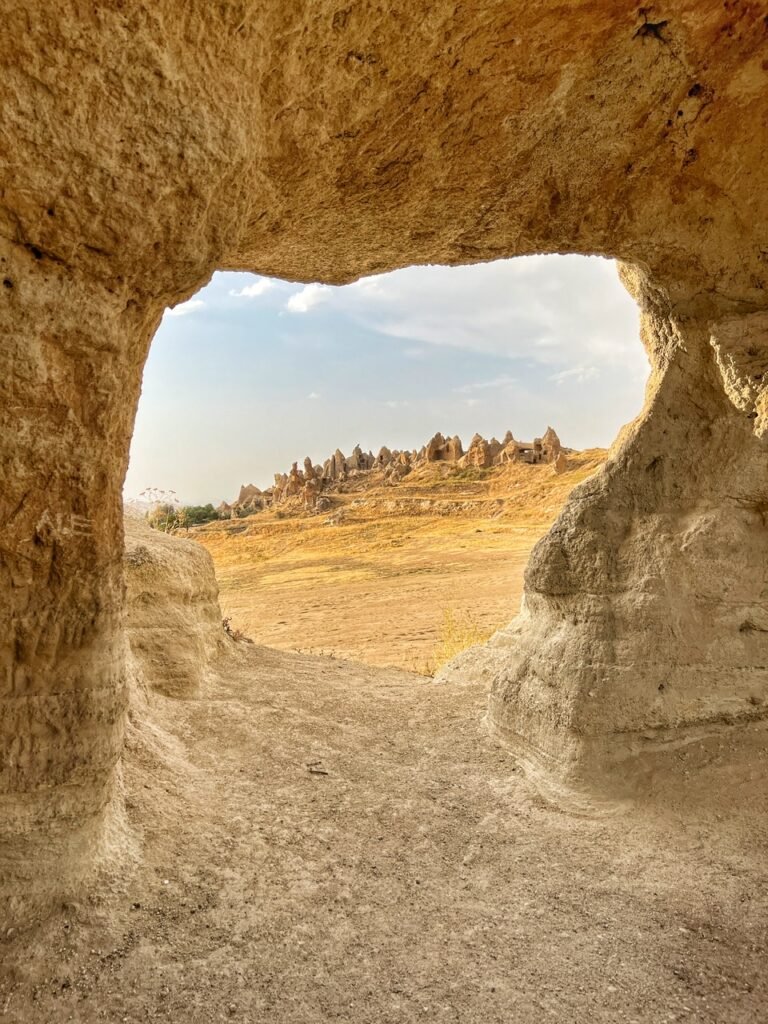
Heading back to Göreme, we wandered past many more interesting things to look at.
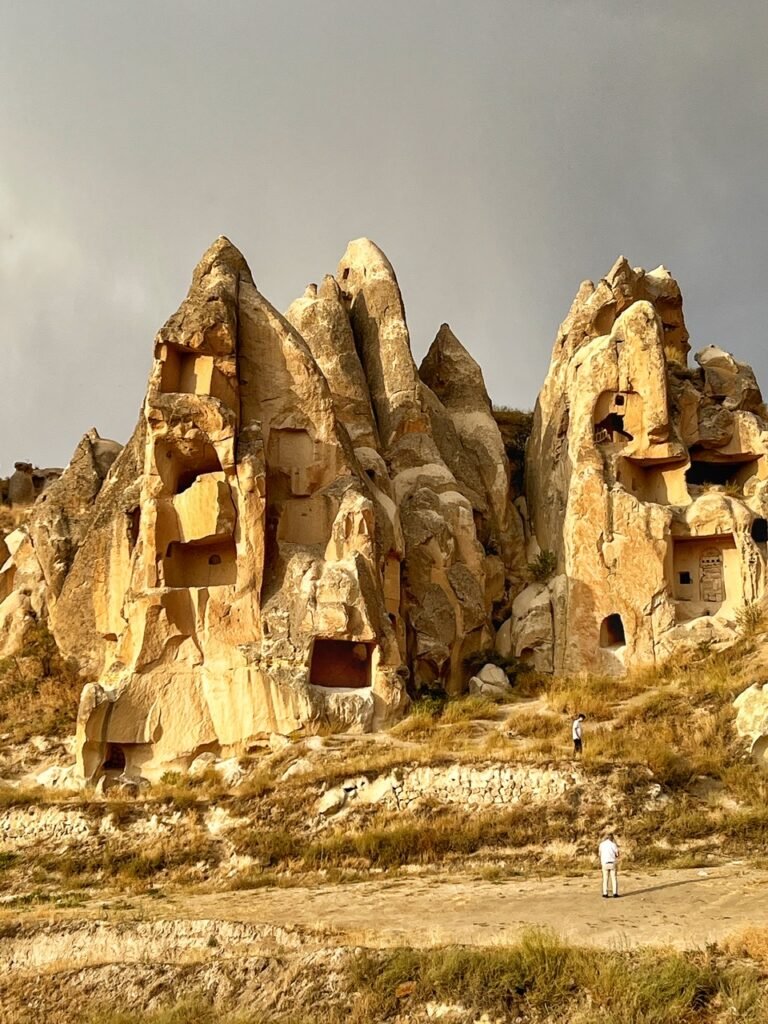
This included more whimsical gnome domes.
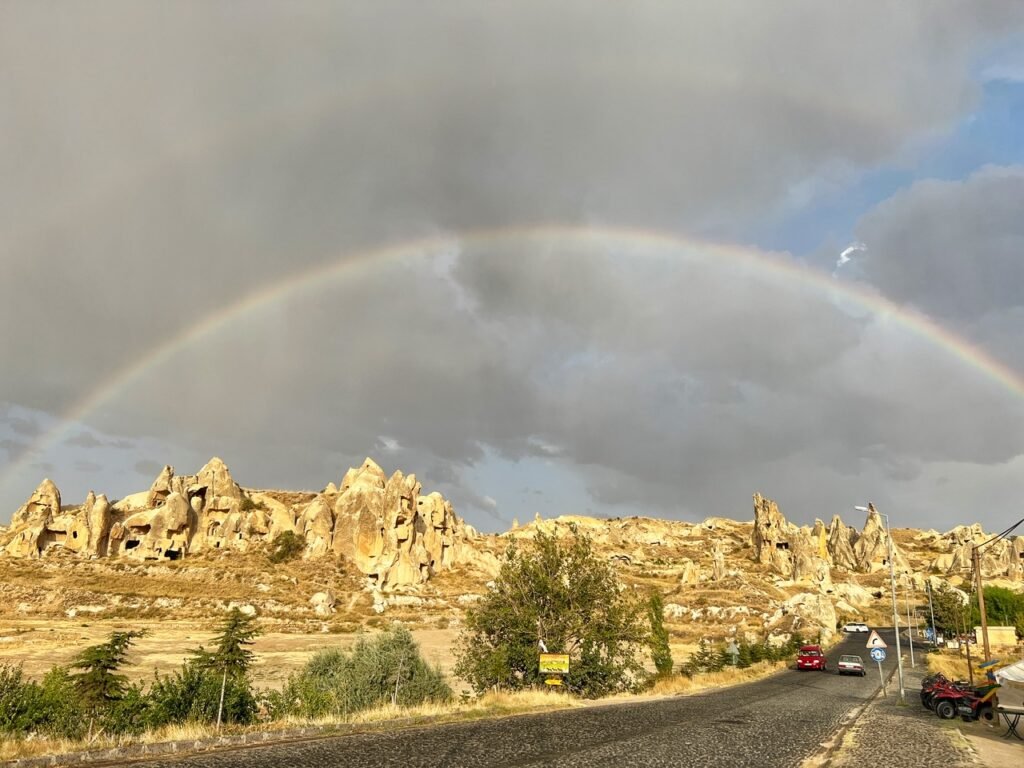
Oh, and surprisingly we also got caught in a lot of afternoon rain, which resulted in this stunner.
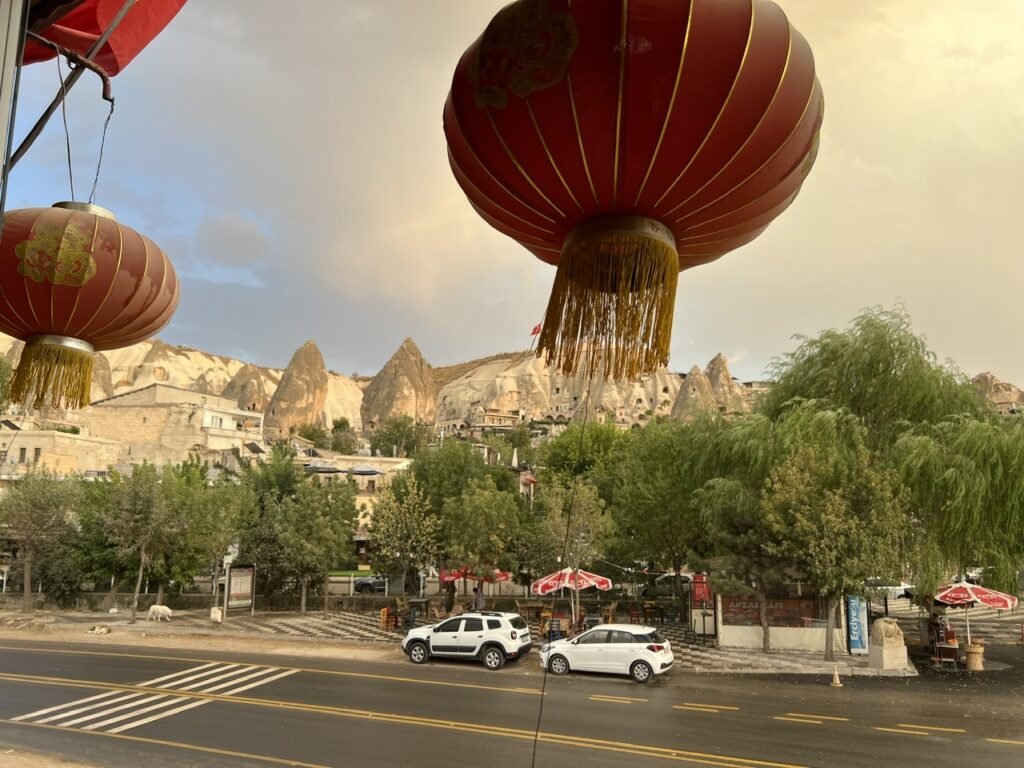
What at first looks like another hot air balloon is actually a lantern, and a great representation of east meets west on the Silk Road. Where did we find this? Back in Göreme, now hungry, we followed a trail of Asian people into a restaurant called Peking Chinese Restaurant. We needed a break from Turkish and it certainly did the trick for about $20.
Kaymakli & Derinkuyu Underground Cities
While in Cappadocia, we were reunited with our friends, Feriha and Robin, a Turkish/British couple we met in Antalya during our 2019 Lycian Way adventure. Because they arrived with wheels in the form of a fun-size Suzuki Jimmy jeepette, exploration life got even more interesting.
As mentioned, everyone loves visiting the mystical fairy chimneys and gazing at the balloons, but we were even more elated to learn of a gargantuan underworld of epic proportions lurking beneath the crumbling surface. Here’s a trailer starring Mandy and Greg, and guest star Robin, before the blog meat:
So, we chugged 20k south of Göreme to Kaymakli and Derinkuyu, by far the most elaborate and enthralling underground cave cities we’ve ever seen. This tangle of underworld tunnels and dwellings, up to 17 levels deep, was designed to allow up to 20,000 people and their livestock to live their lives in total secrecy and protect themselves from Muslim Arabs during the Arab-Byzantine Wars between 780 and 1180.
It continued to protect citizens as late as the 14th century when Christians needed a safe haven from the threat of the Mongolians, and once again during the Ottoman era, when protection was needed from the Turkish Muslim powers. It was not until 1923 that the caves were completely abandoned and it was rediscovered in 1963. Apparently people from nearby homes are still finding gateways to the upside down. What history! (Culture Trip)
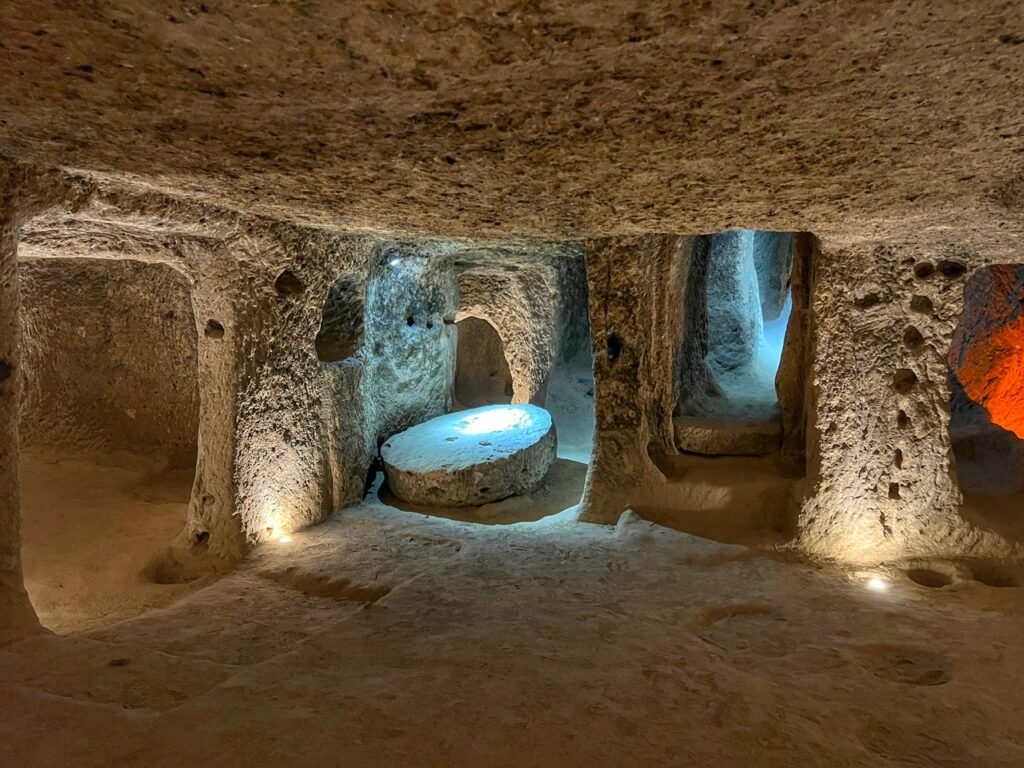
We first visited Kaymakli, seemingly the favorite of the tour groups. Although there were a ton of people, it was quite easy to get off the beaten path and do a little exploration of your own. You might guess, however, this is not the best place for those with claustrophobic tendencies. Each city cost 100 Lira ($5.40) to enter. There are a whopping 300 underground cities in Cappadocia but only two are popular tourist attractions.
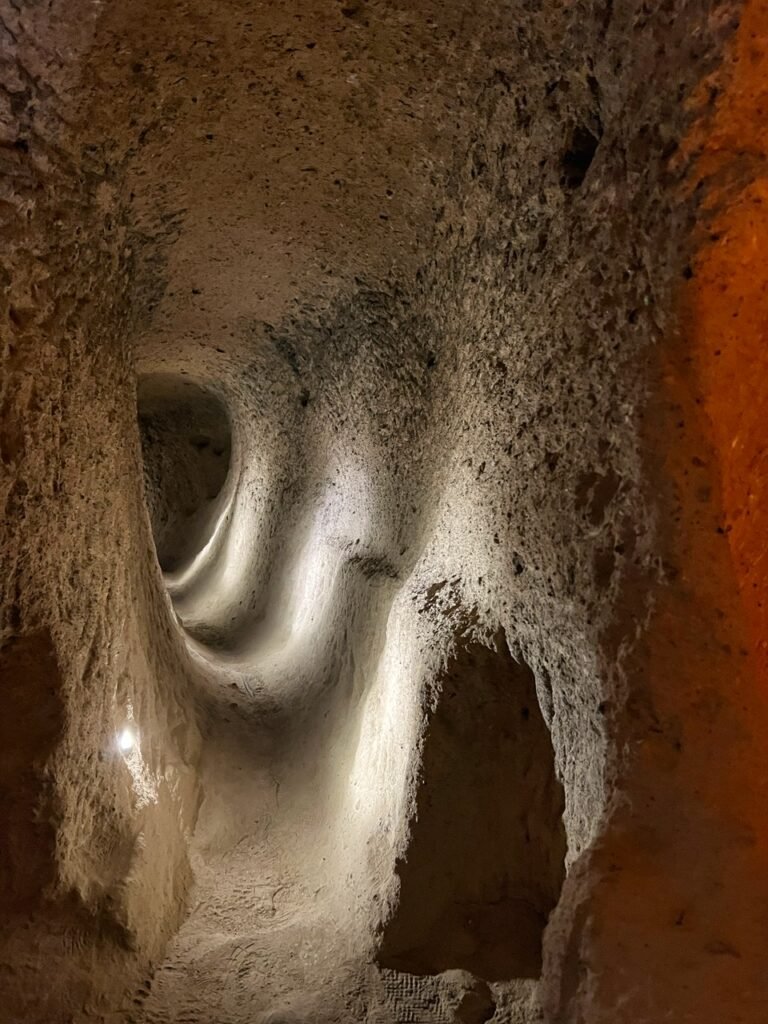
Some people lived in these fully functioning cities from birth until death. It seems a common cause of death inevitably must have been Vitamin D deficiency. Crazy.
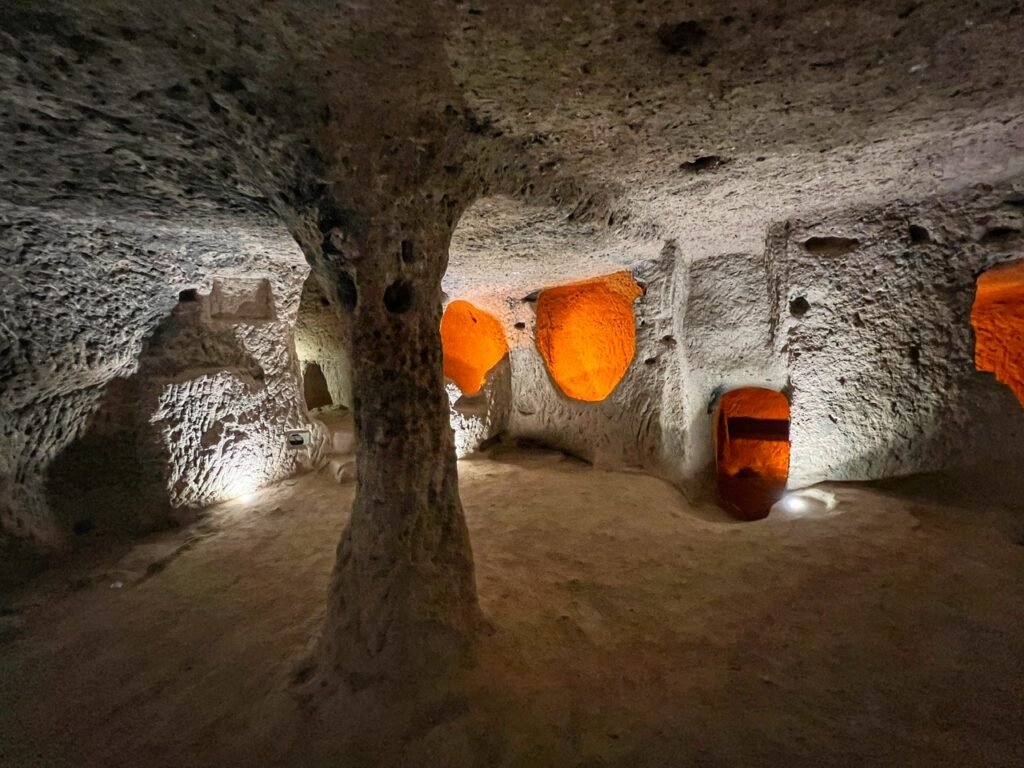
It is believed that the underground cities were initially built by the Phrygians during the 8th through 7th centuries BC who carved their living spaces into the region’s soft volcanic rock. (Culture Trip.)

Apparently only about 5% of the city is currently available for us to see, which really puts in perspective how colossal they are considering it took us nearly 1 1/2 hours to venture through Kaymakli. Most places were well lit, but some tunnels delightfully led into complete darkness which we ventured into a bit. Can’t imagine the liability on doing this in the States ?
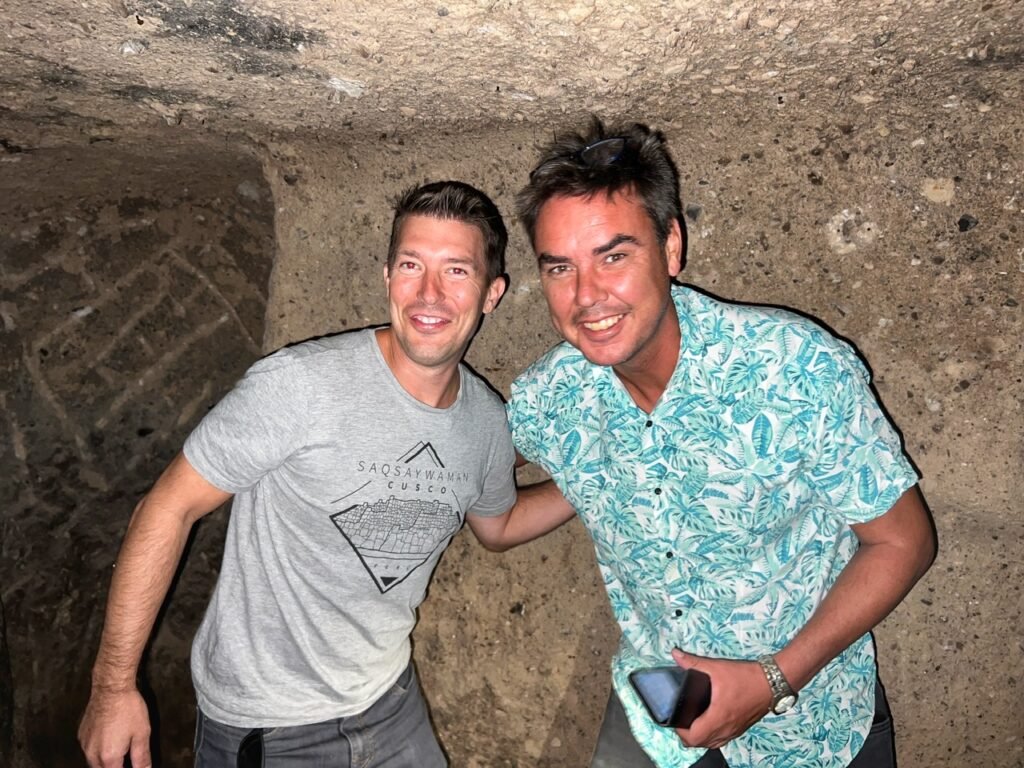
We were fair game, but Robin was a bit more hesitant at first. Eventually we peer pressured him into hopping our explorer wagon.
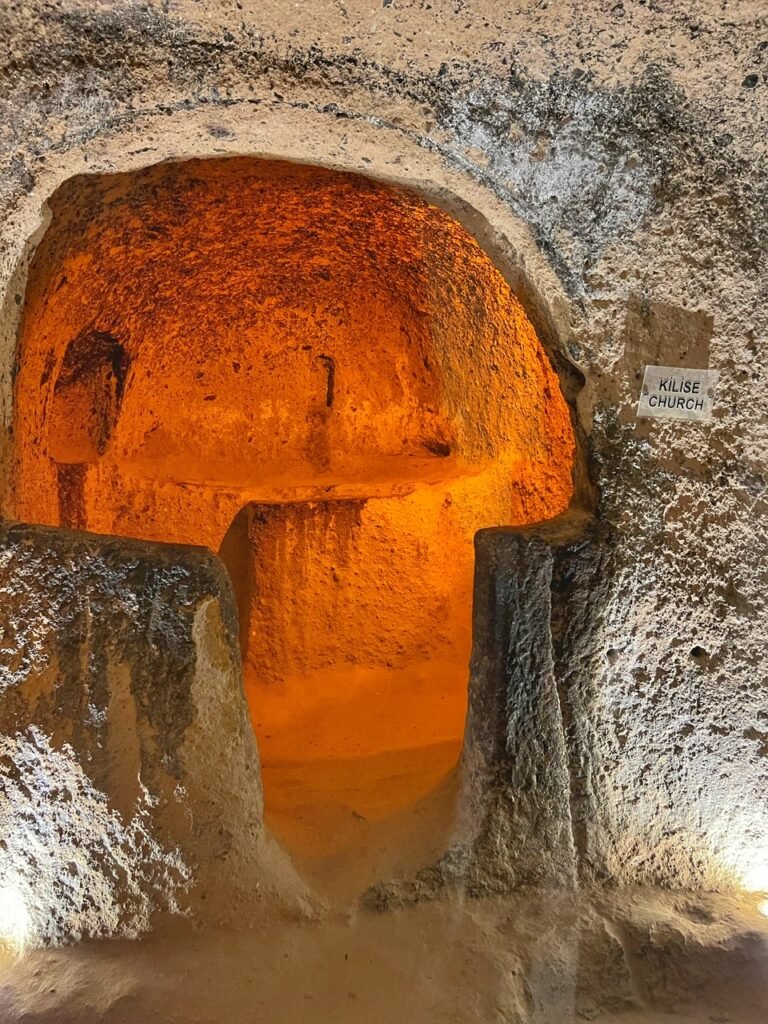
Throughout the city you could find multiple churches, which perplexedly hold a congregation of about 10.
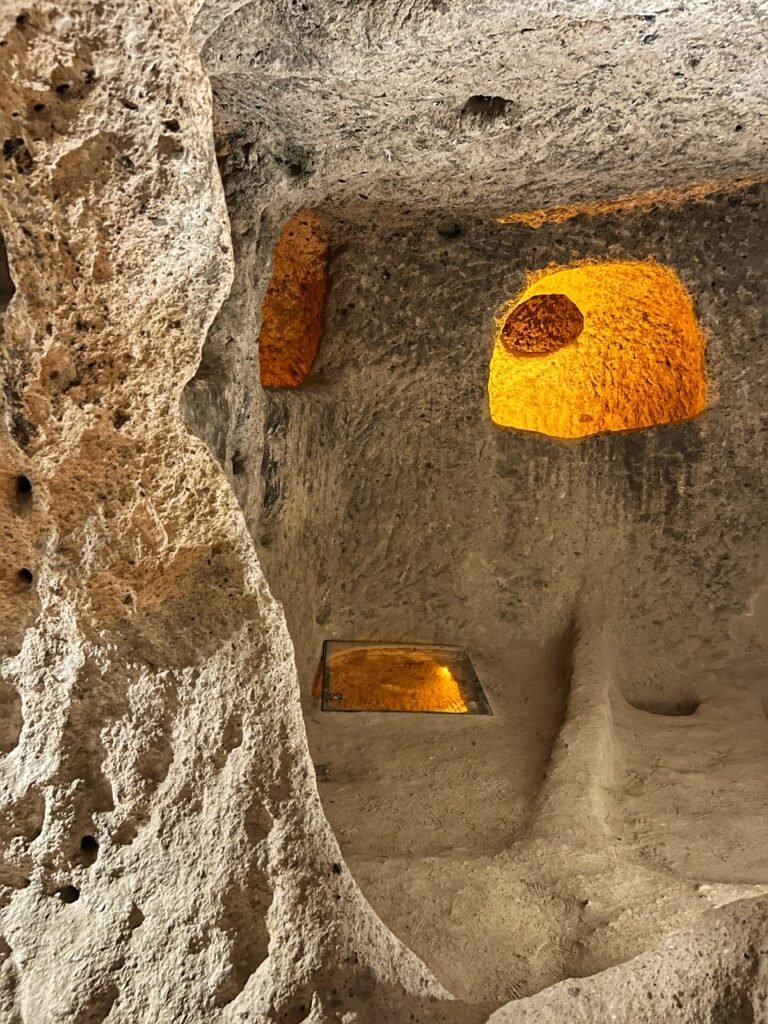
There were loads of glass panels in the floors so you could view the tunnels and oftentimes, passing people underfoot.

All he needs is a token Hollywood hat made popular by a certain character.
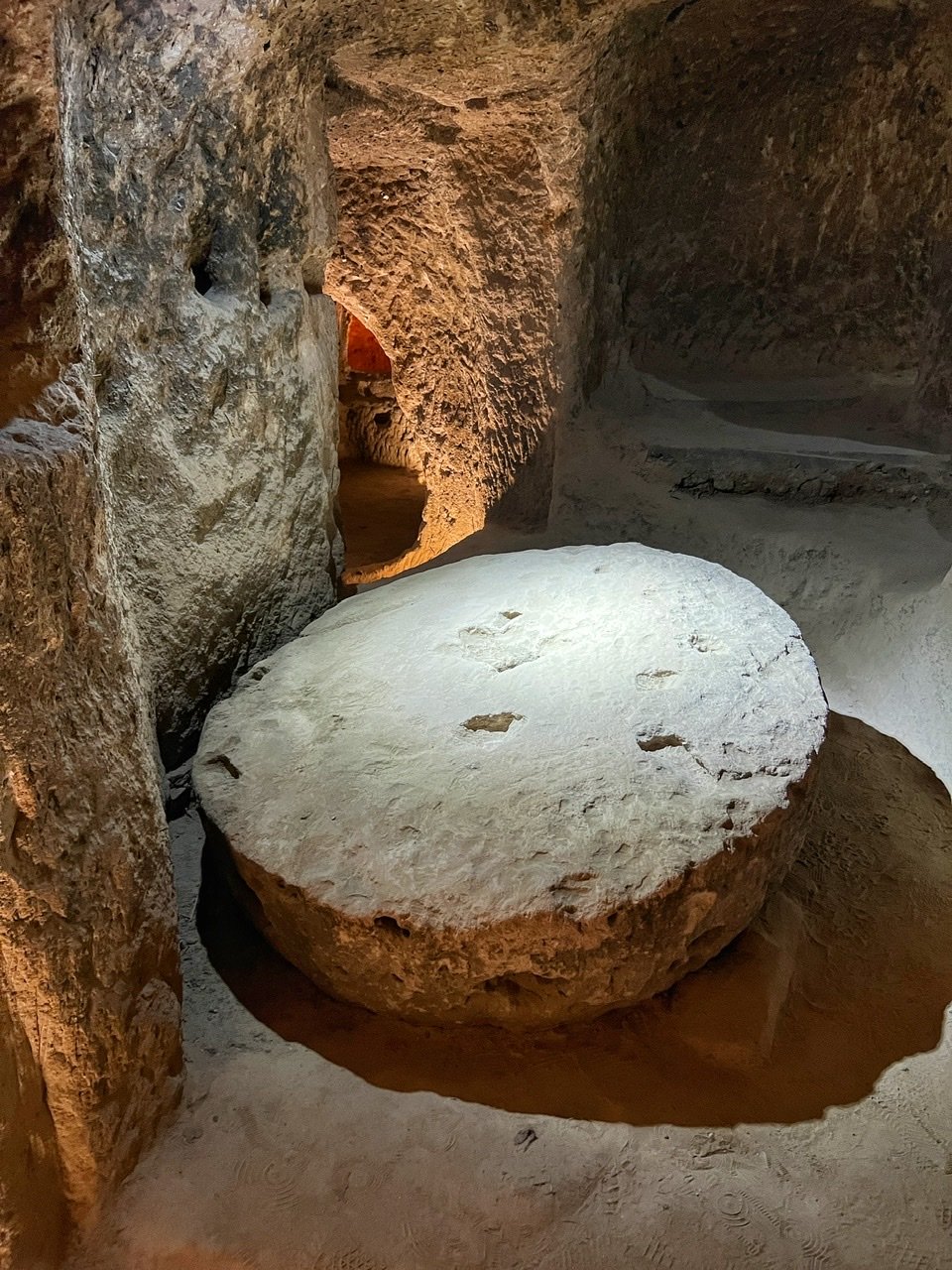

Speaking of Indiana Jones, Spielberg had to be inspired by a place like this. Look familiar? These half-ton boulders could be rolled in place to close off the tunnels in times of invasion.
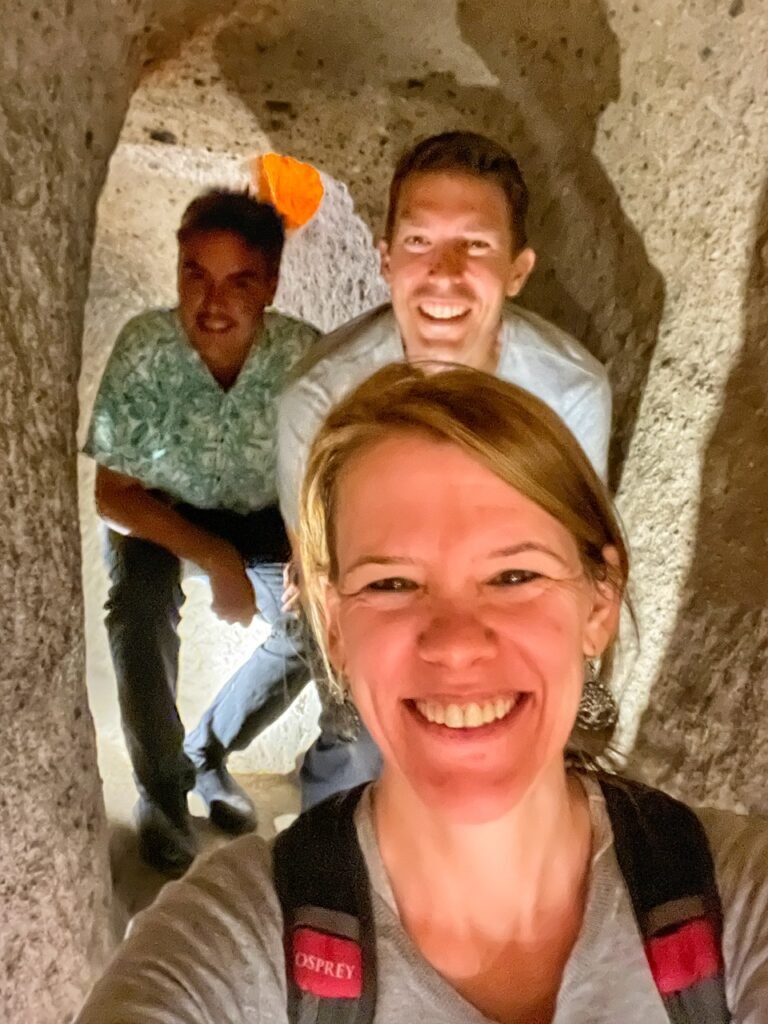
Navigating through the labyrinth of tunnels.

More than 50 ventilation shafts were scattered throughout and allowed for natural airflow between the city’s many dwellings and hallways. It’s likely how archeologists discovered exactly how deep the tunnels are as well (~85 meters or 279 feet). They also served as wells. Wondering about sewage? We were. We later learned from BBC Travel that the “residents relieved themselves in sealed clay jars, lived by torchlight and disposed of dead bodies in designated areas.”
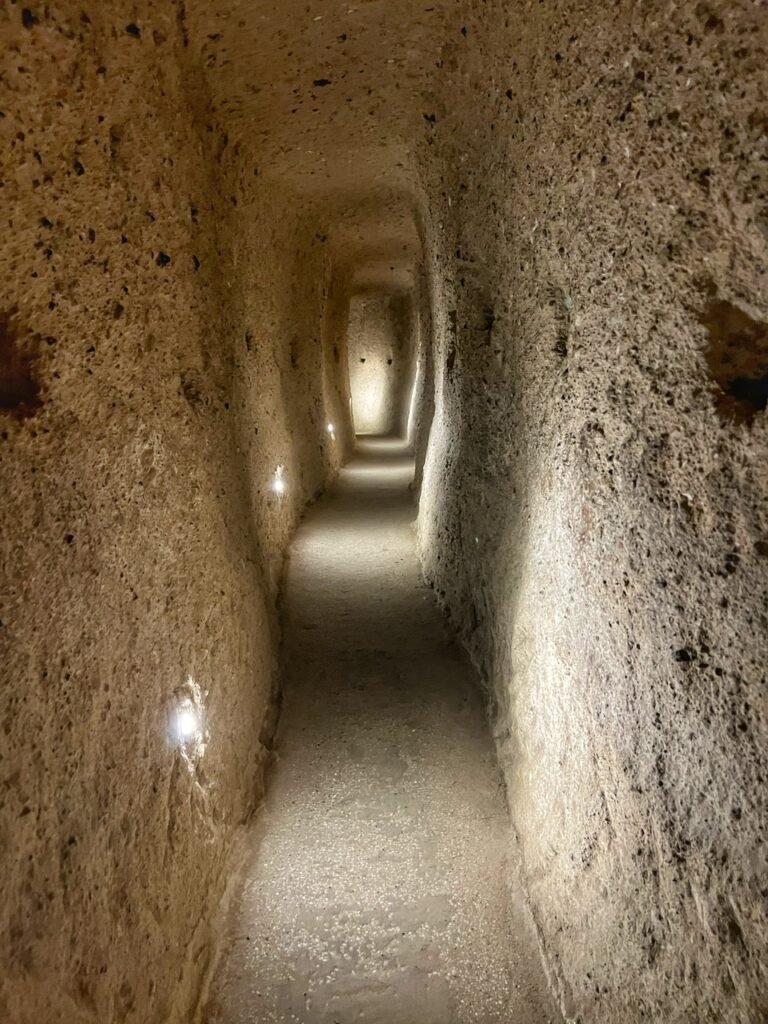
It was added to the UNESCO world heritage list in 1985 and is arguably one of our favorites we’ve seen.
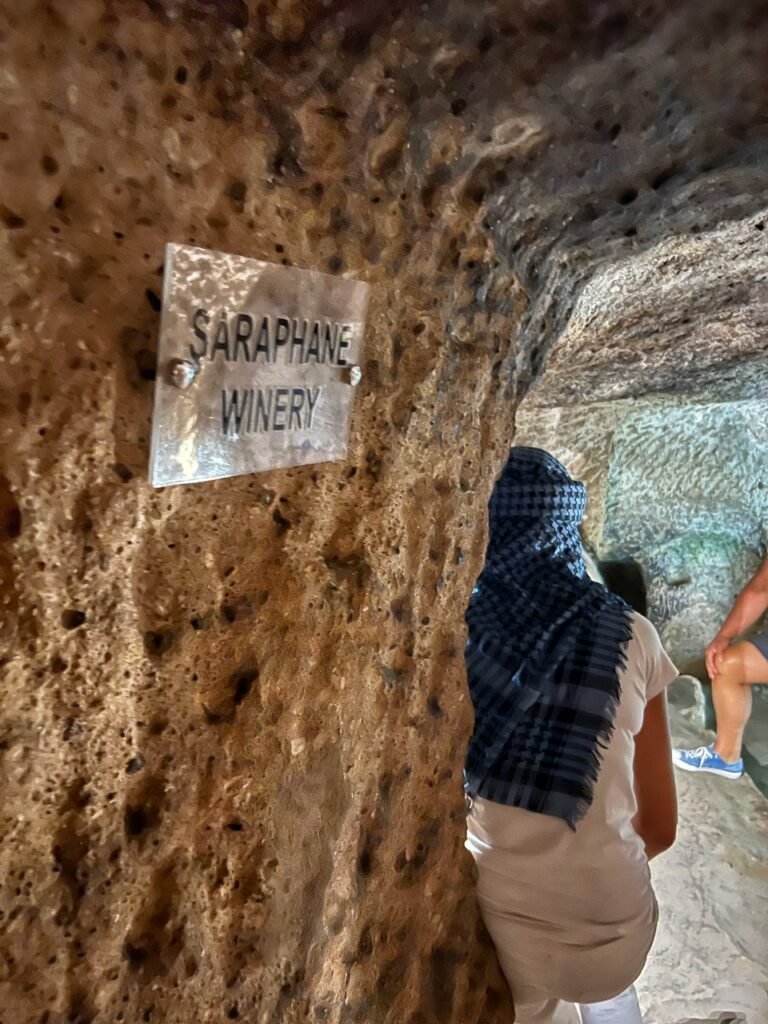
Beneath the surface even lies a winery. Ummmm…yeah, good idea. We’d be drinking if we were living as cave people. Evidence for winemaking is grounded in the presence of cellars and vats.
(Side note: we have yet to see one local wearing a ridiculous Arabic headdress that they sell like hotcakes to such tourists ?)
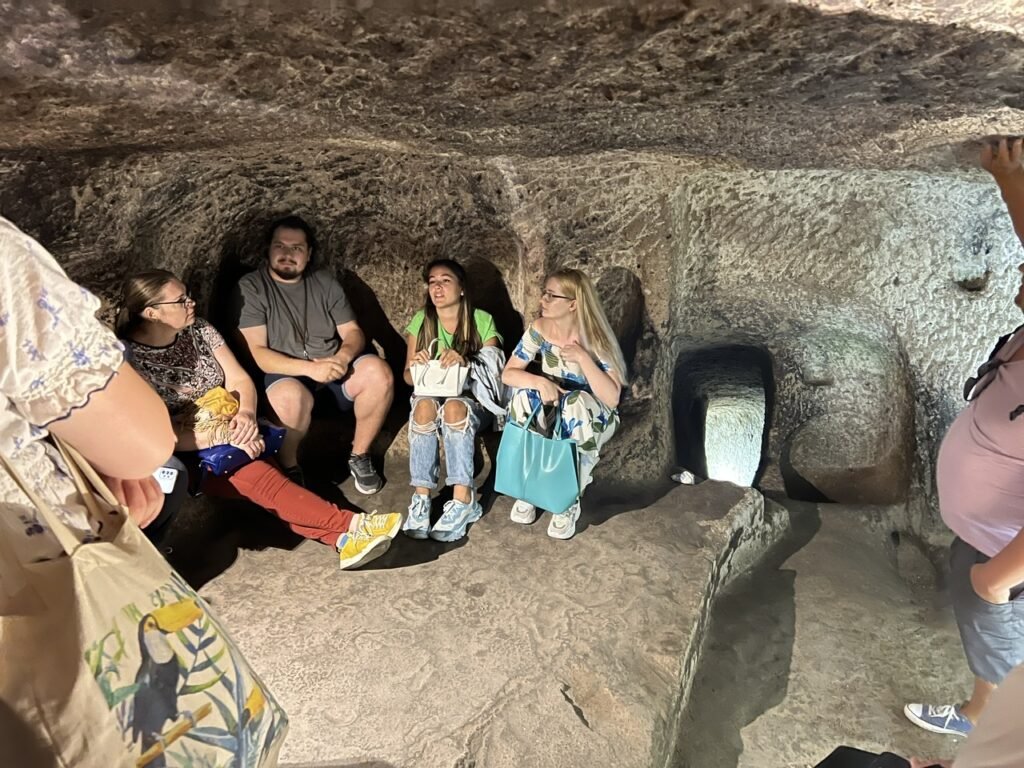
Tourism reality check. No we weren’t alone.
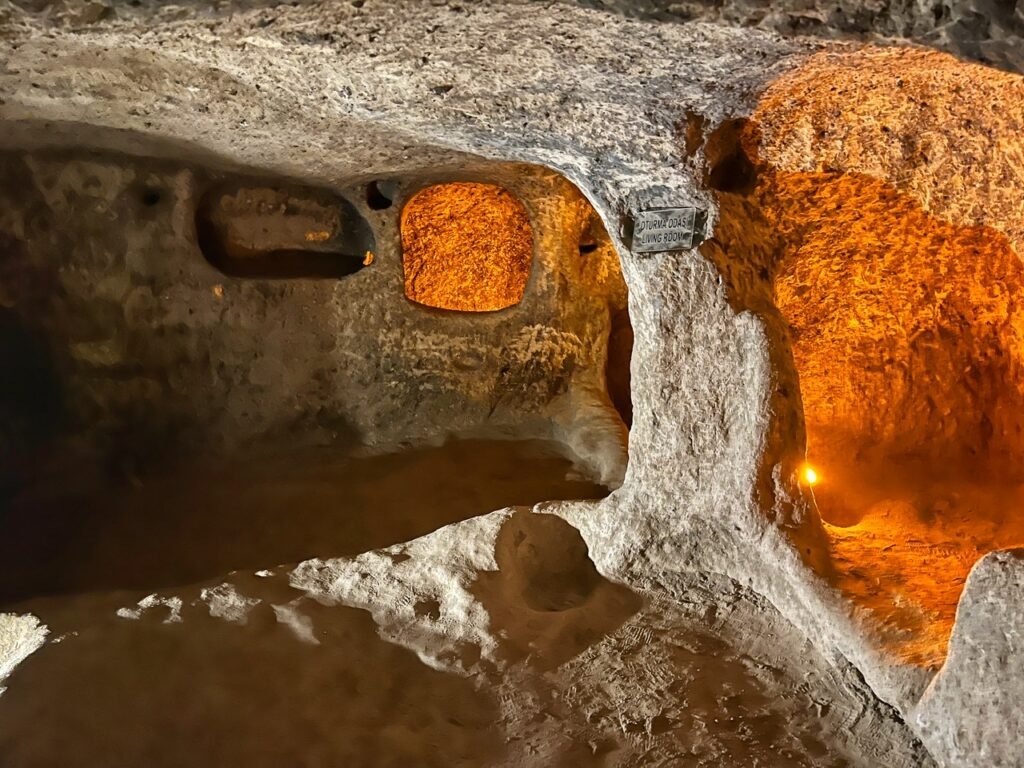
One of the many “living rooms” sprinkled through the Kaymakli.

This rock was found in one of the many kitchens, as evidenced by the soot covered ceilings. Archeologists originally thought the holes were used for mortar and pestle, but later evidence suggests they were used for sorting.
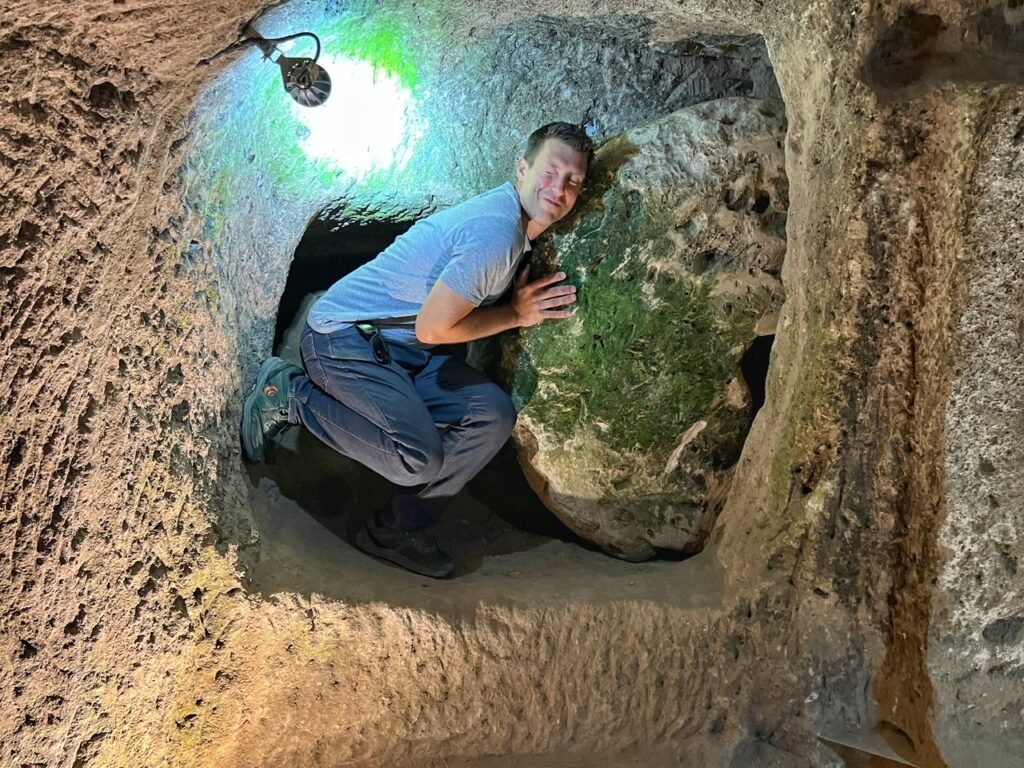
Man, these rolling rock doors are a wee bit cumbersome.

We headed next to the town of Derinkuyu.

Guess the ancient inhabitants who had high blood pressure, asthma and heart problems were screwed. Oh yeah, they didn’t have highly processed food back then…probably wasn’t an issue.
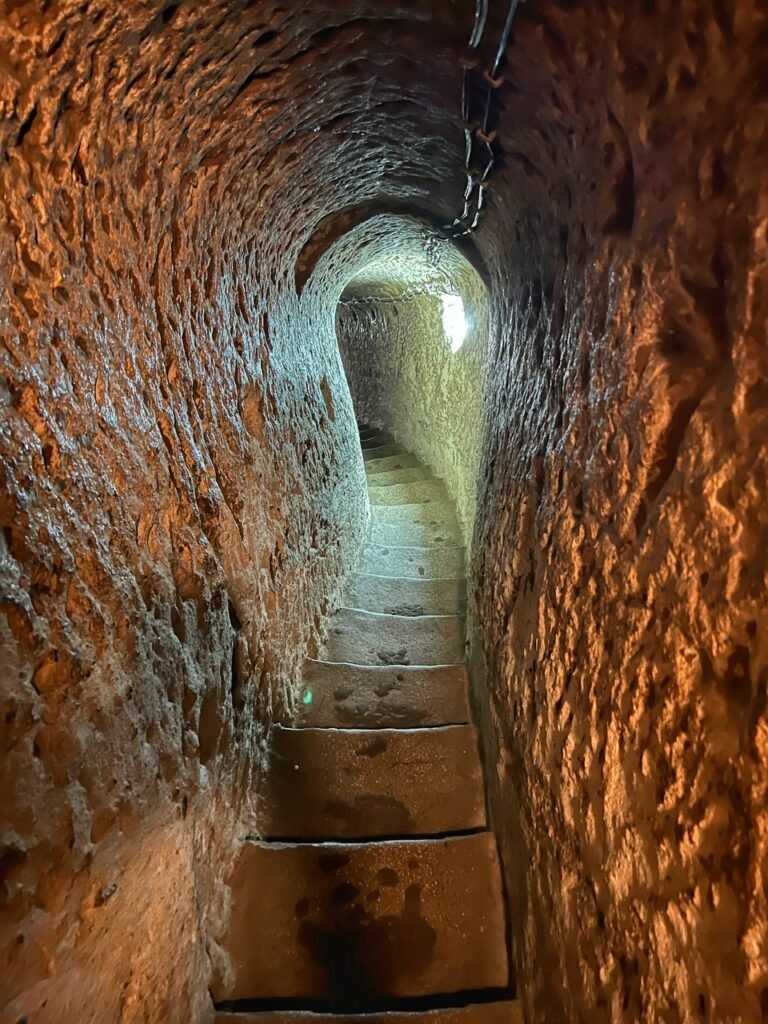
Eight floors (of 17) down we go!
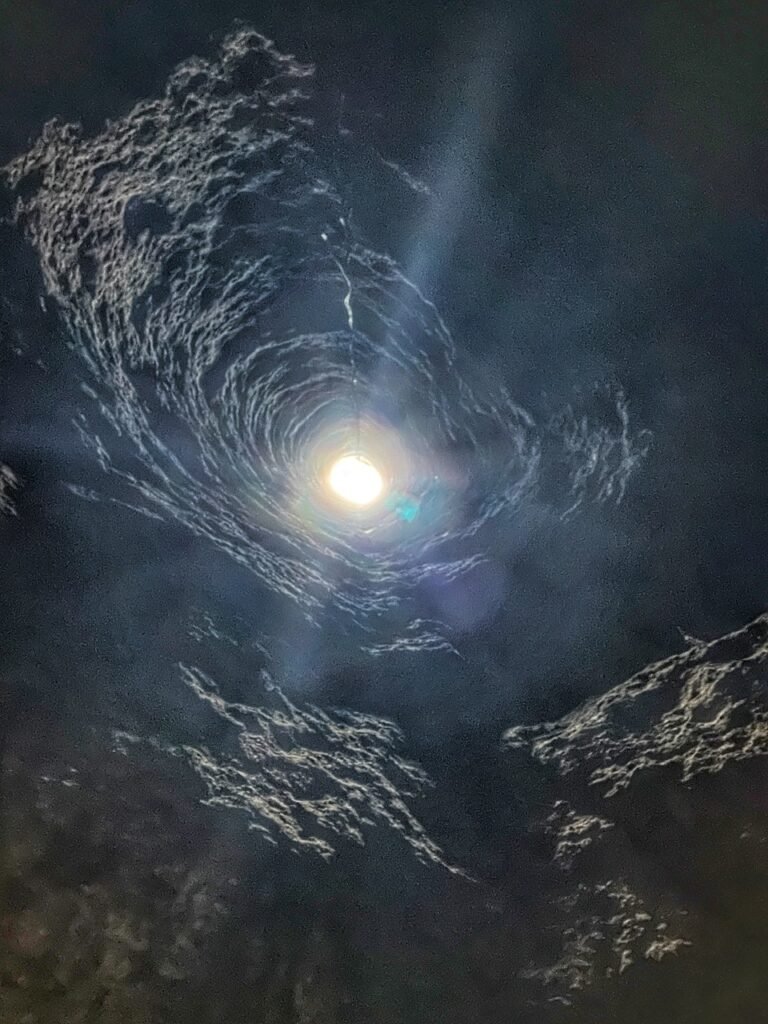
A ventilation shaft looking up is like gazing into a celestial body.

One of Derinkuyu’s most dramatic spaces is a grand room with vaulted ceilings. This room is believed to have been a religious school.

Despite the fact there were more tour groups, of the two cities we visited, we surprisingly preferred Kaymakli.
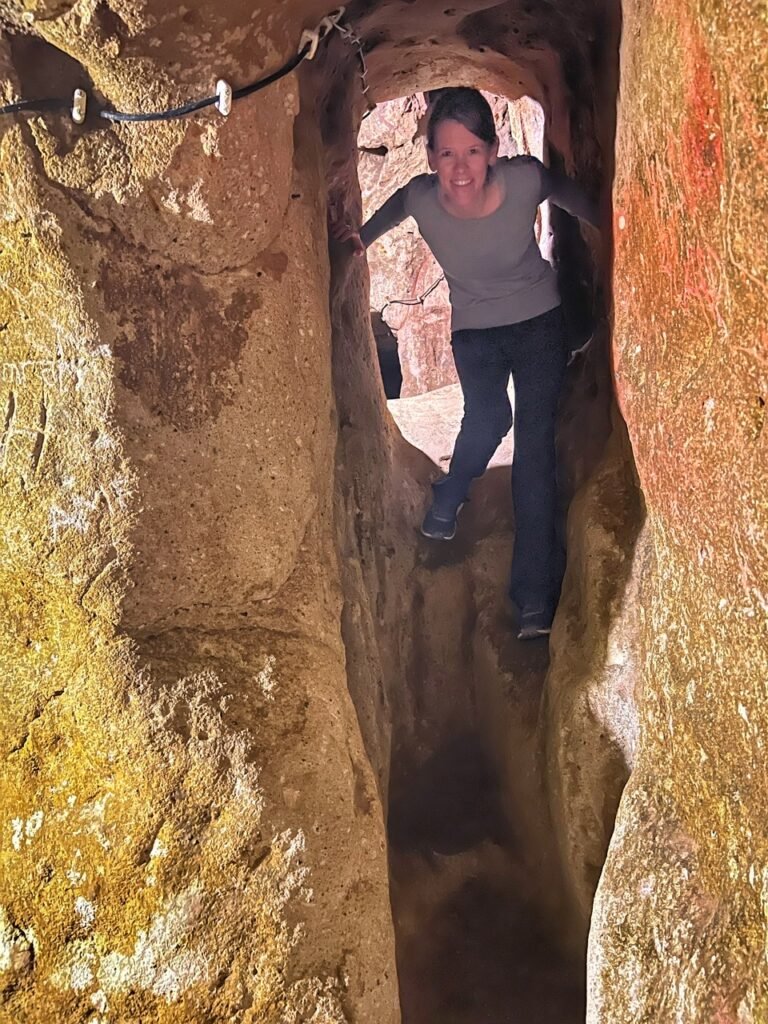
We’d recommend both to get a complete picture. A guide is possible, but certainly not required. Personally we had more fun gallivanting without ?
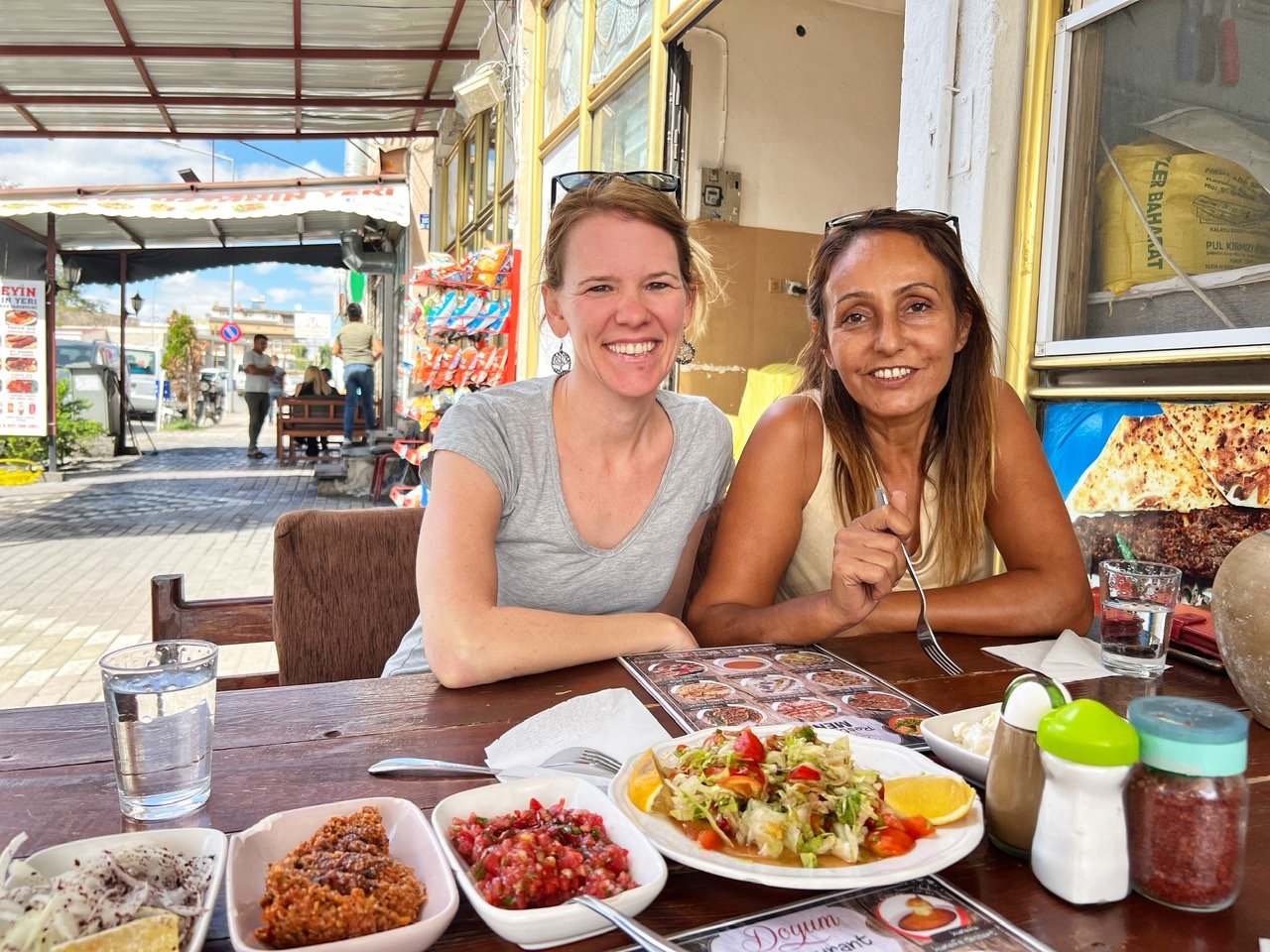
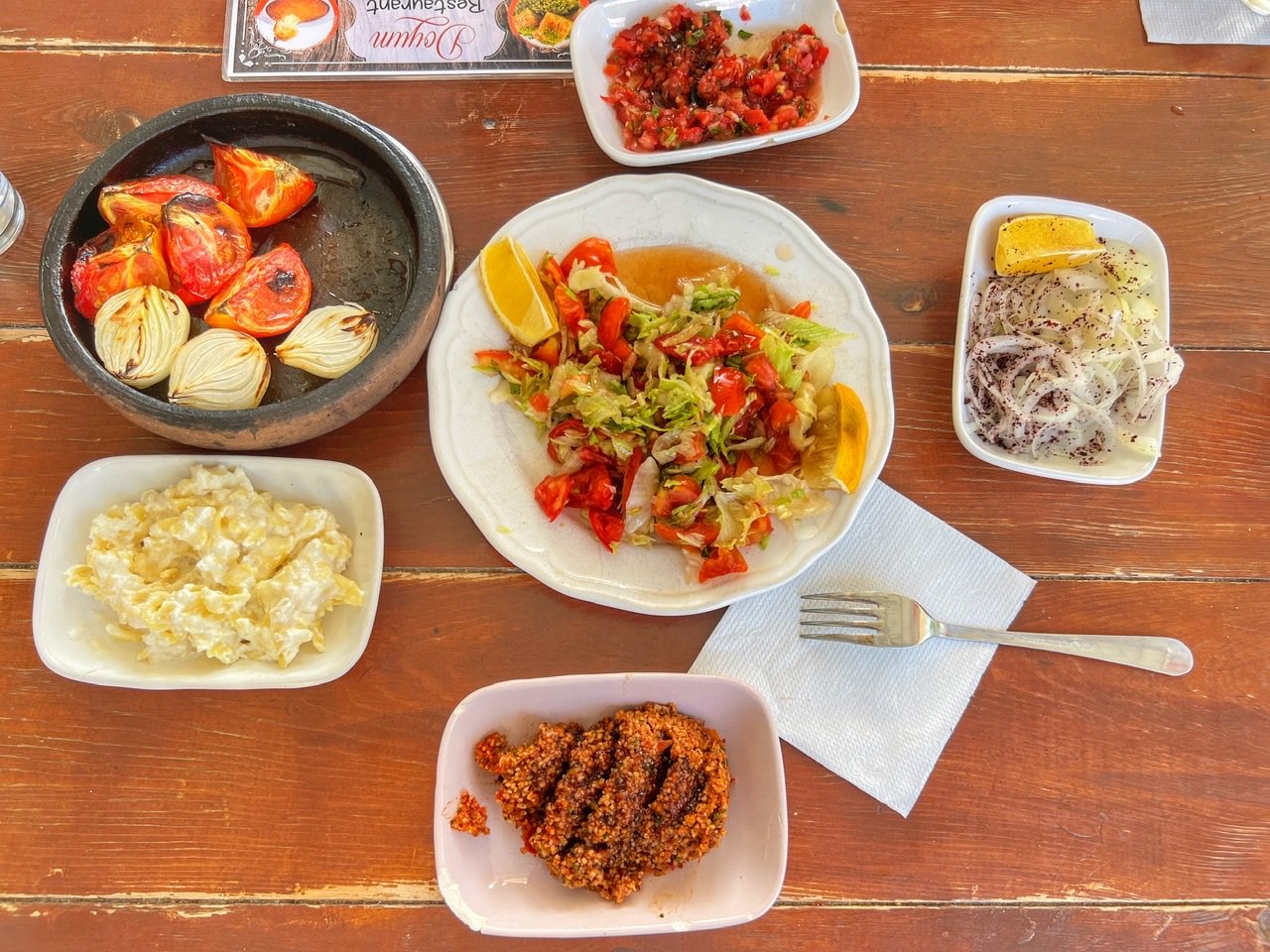
Mandy and Feriha at lunch. Feriha opted to breathe air freely above ground while we were in subterranean territory. Typically appetizers are included with your meal in Türkiye. We got all of this, four main courses and four teas for 200 Lira ($11.)
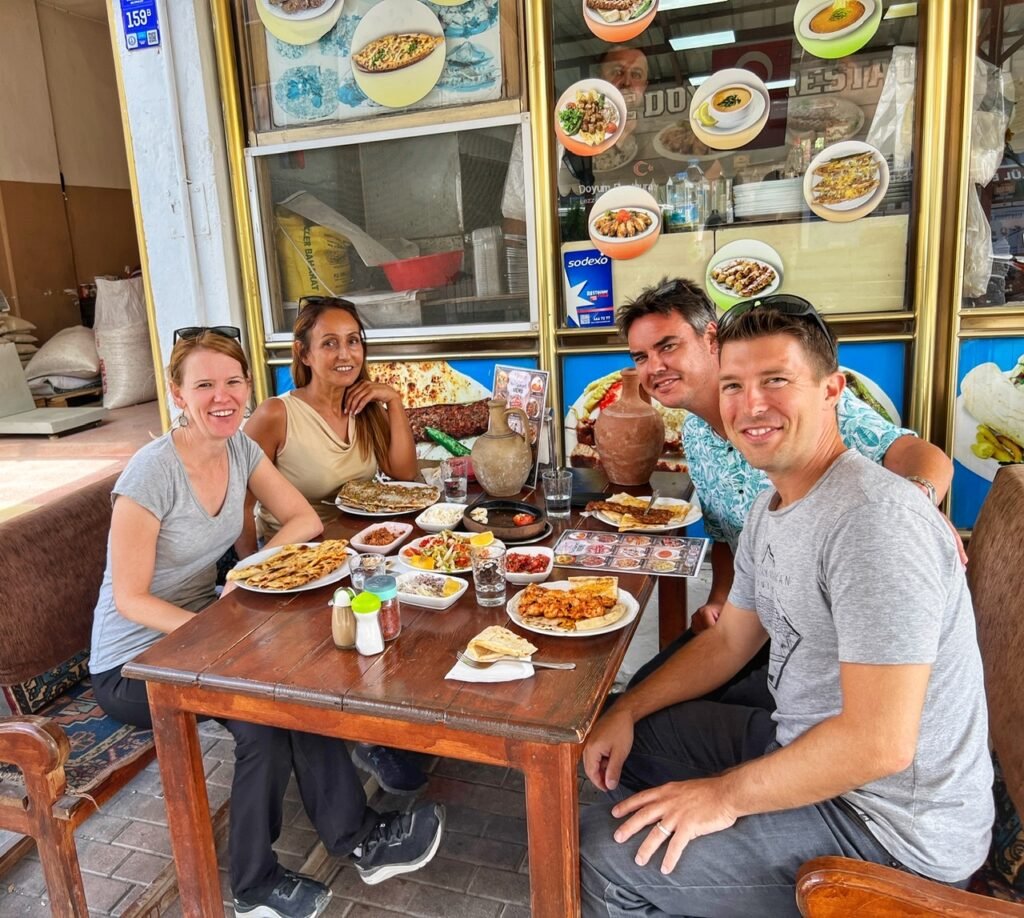
So fun to be on the go with friends again!
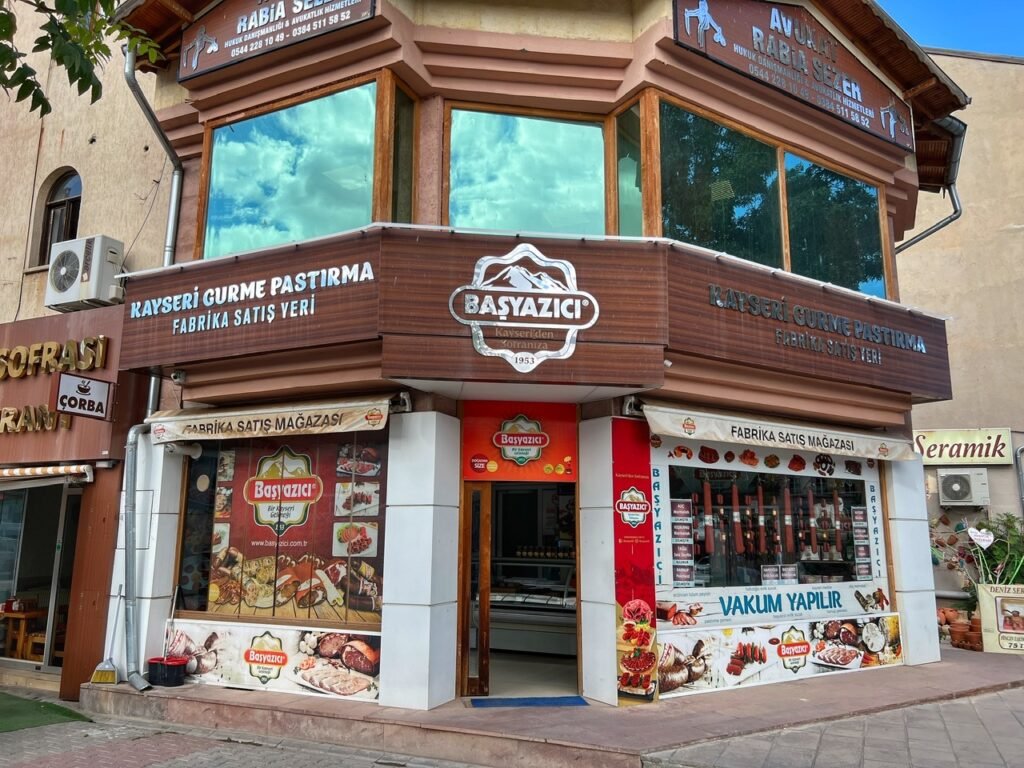
From Derinkuyu, we headed north to the town of Avanos. Most people think that pastrami originated in Italy or food stalls of Bronx of New York City (ha!), but in fact, this peppery meat has much earlier origins from jerky-like pastirma of the Ottoman Turks. In Avanos you’ll find lots and lots of pastrami shops.
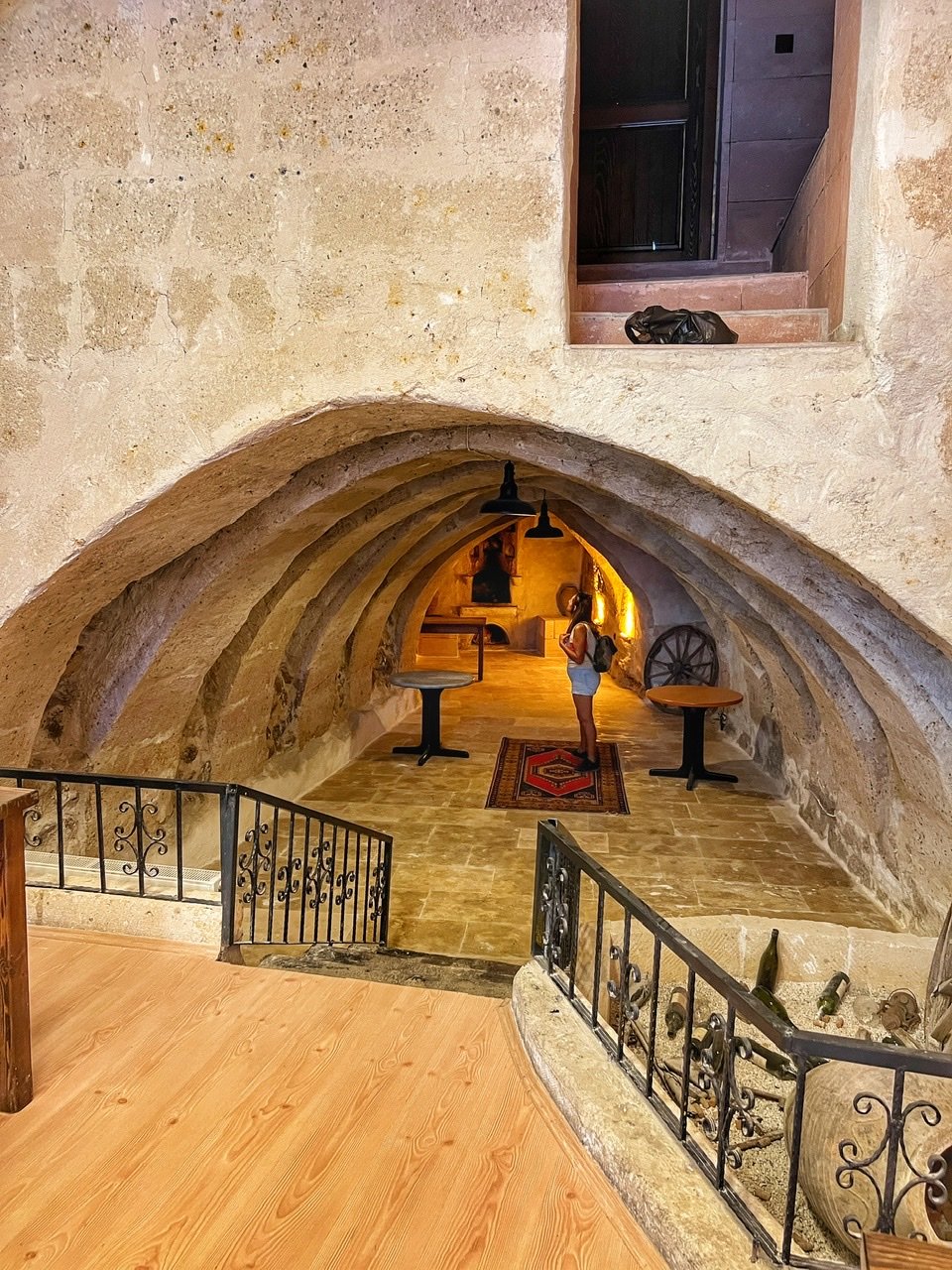
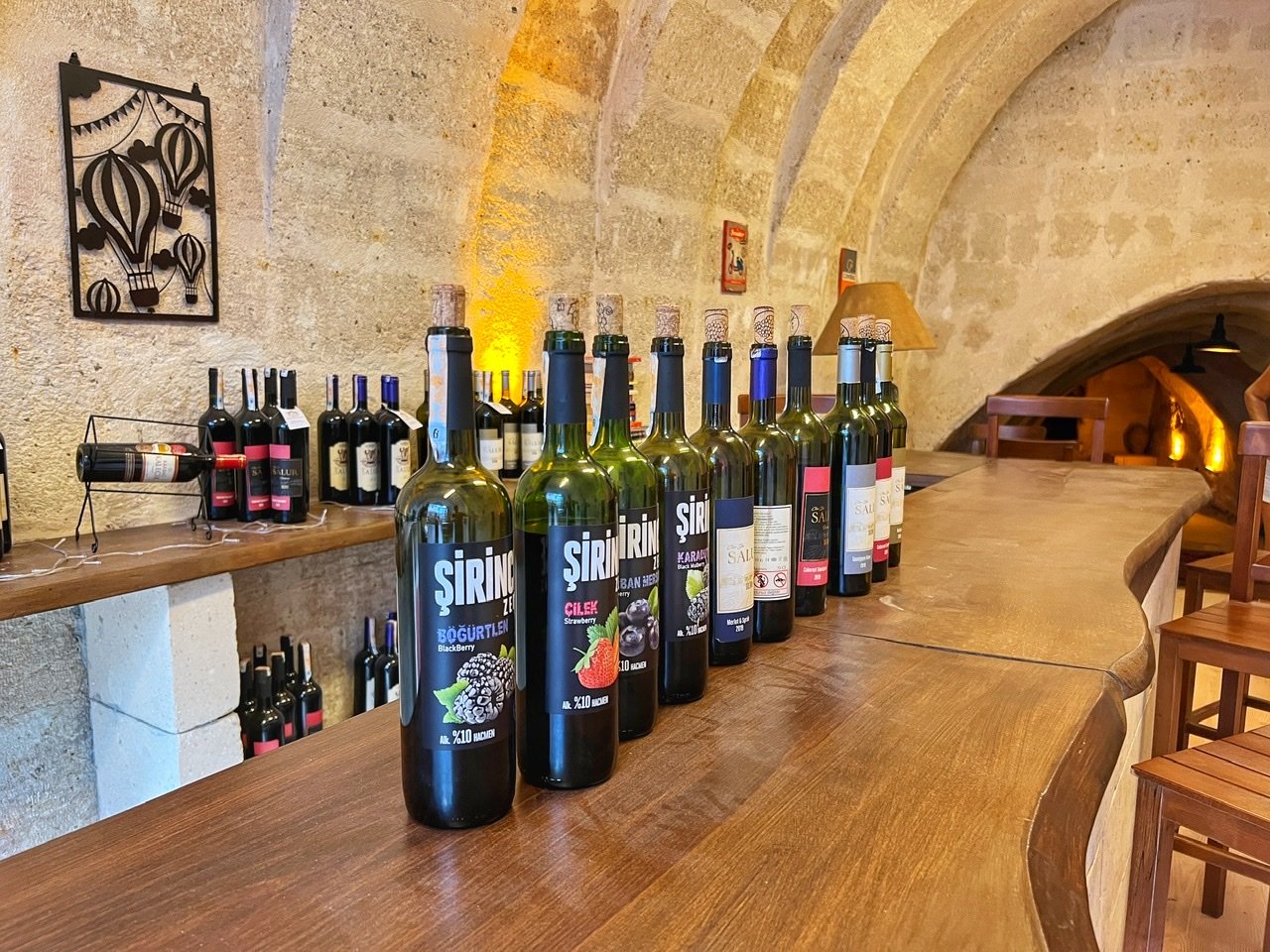
Feriha wondering into a vacant wine cave. Although the wine industry is thriving in the Cappadocia region, no one seemed to be manning this one. Should we just grab and go? We may have wished we would have because once we finally got our paws on a bottle, we dropped 300 Lira ($16.) Ugh. I don’t think we’re in France anymore, Toto….
Ortahisar
After two nights in Göreme, we were ready to jump off the tourist bandwagon and relocate to the quieter and cheaper village of Ortahisar for five additional nights. The taxi to Ortahisar cost about $4 and took 20 minutes. Buses also available but we usually opt for taxis when carrying all our stuff.
Ortahisar was a complete 180 from Göreme…clusters of waving old men at corner cafes pounding Turkish tea like it was beer, a giant rock that felt like an obstacle course with only a splash of tourists, good food and great value and getting invited to tea by random strangers…now friends.
We chose to stay in Tatli Kaya Hotel, which was about a eight minute walk to the center. It was a really great choice thanks to the phenomenal breakfast on a comfy terrace, the extra friendly staff and opportunities for Ottoman princess dress-up, which Greg particularly enjoyed.
Tatli Kaya was half the price of our hotel in Göreme at $32/night, but granted, it wasn’t a cave.
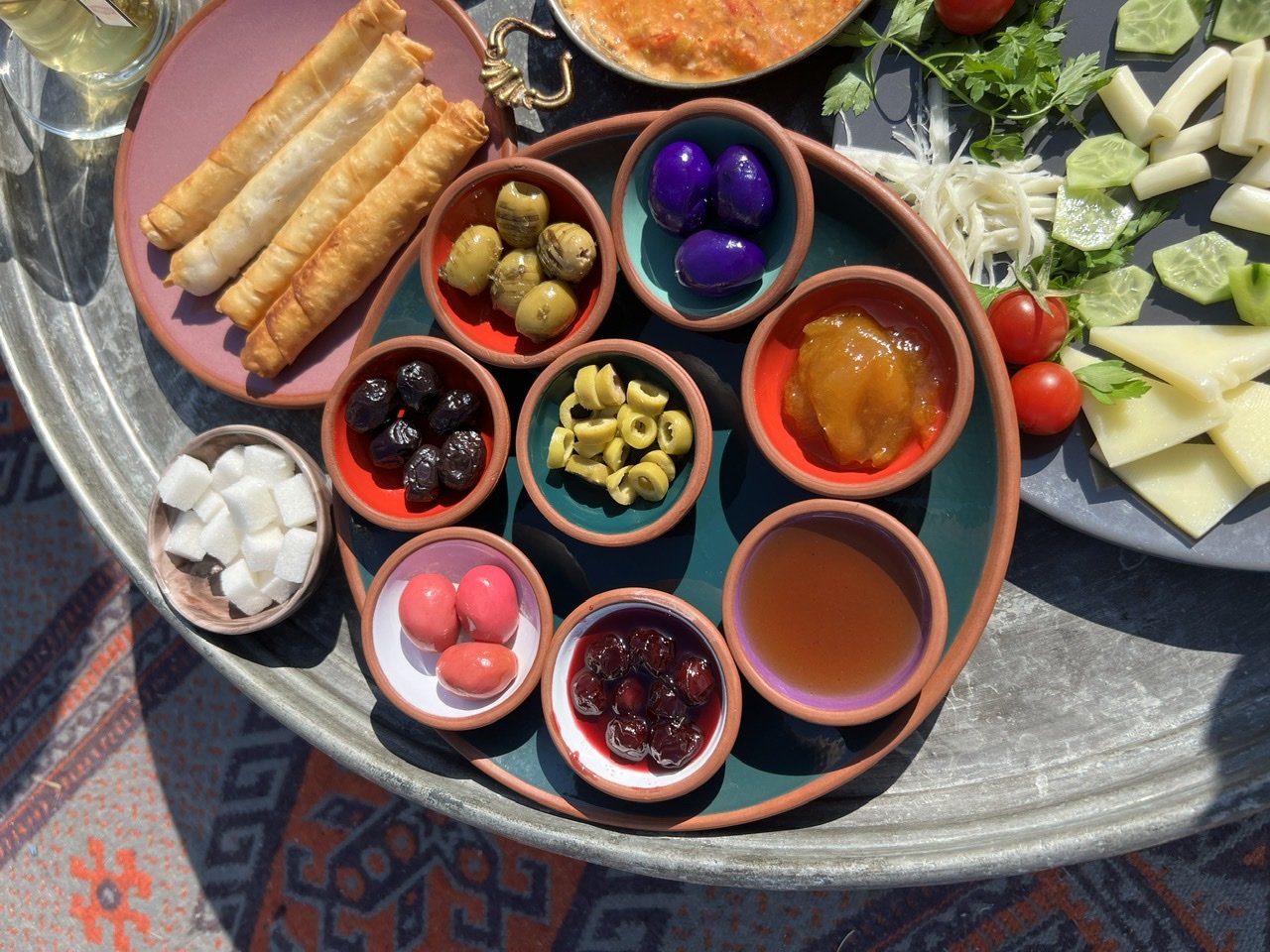

Our daily feast…Turkish breakfasts are among the best in the world and for us, only rival with Sri Lanka. (Another top five country….what does this say about the importance of breakfast?) They are almost always included in any hotel reservation.
We couldn’t get over the glossy olives that practically looked like Easter Eggs. The purple ones were perfectly tart but the pink ones we felt were a bit mushy. They were usually the only olive of five varieties left on our tray. Also, FYI, they didn’t seem to be colored with artificial ingredients because they were dyed down to the seeds.
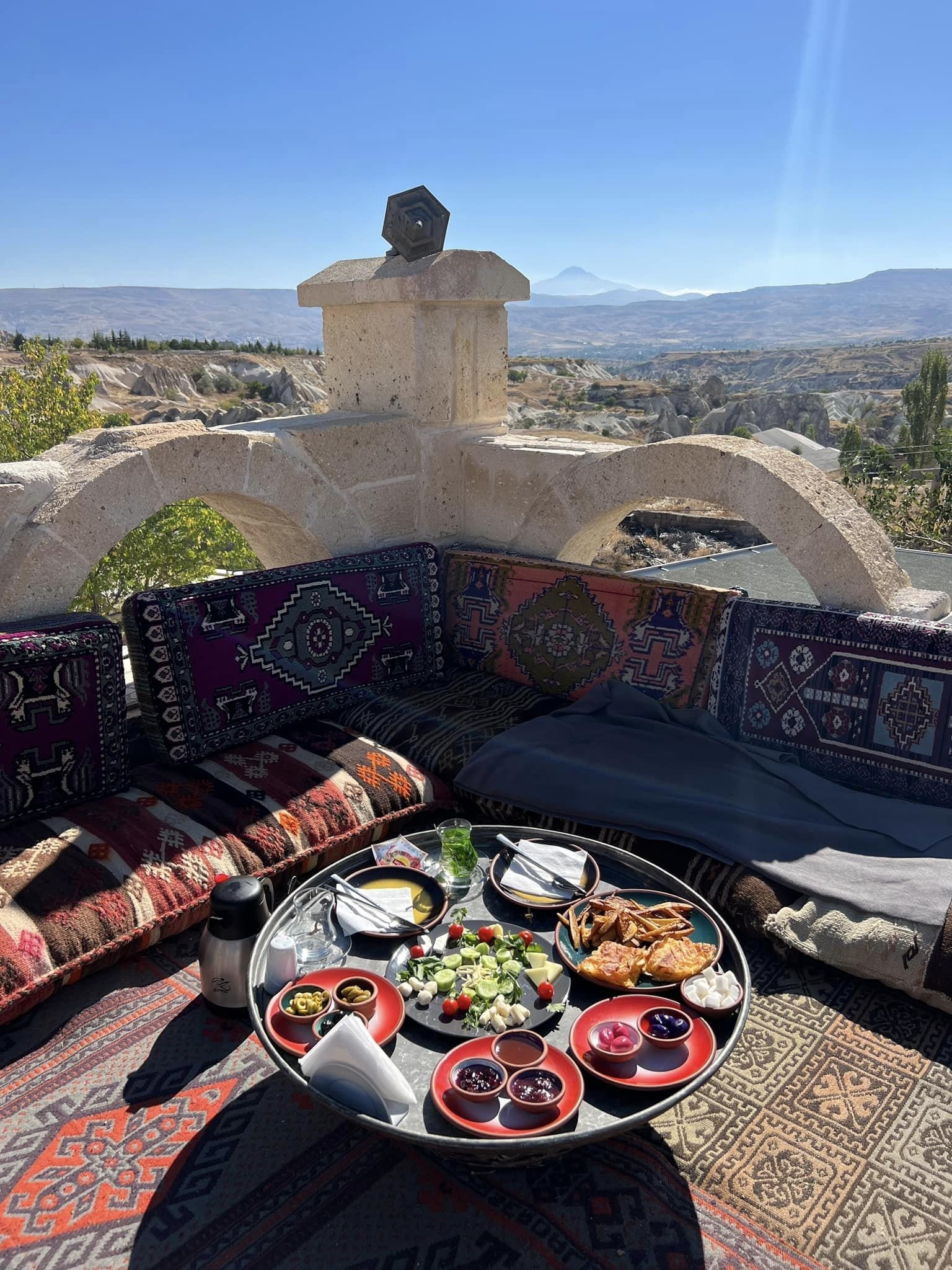
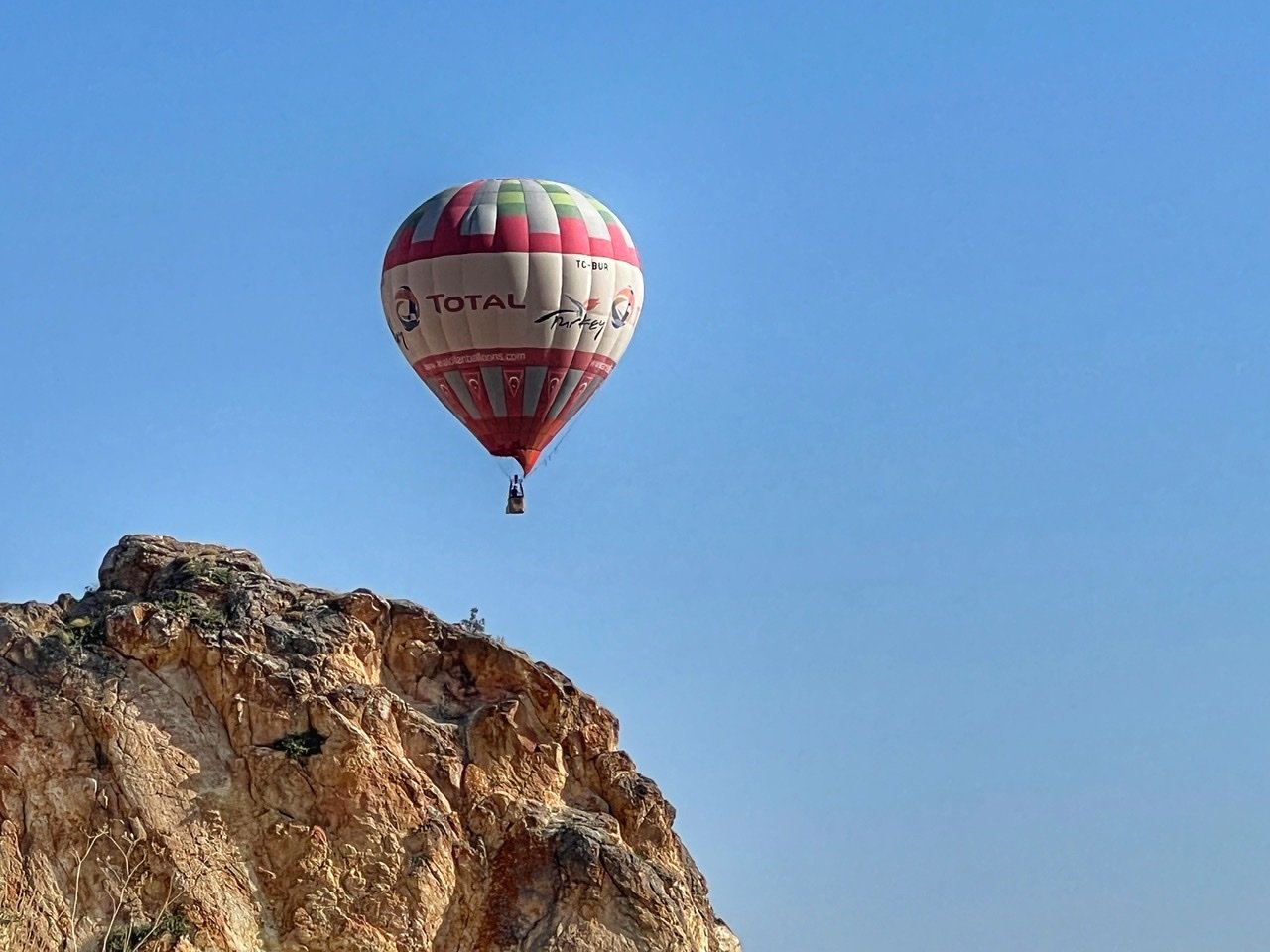
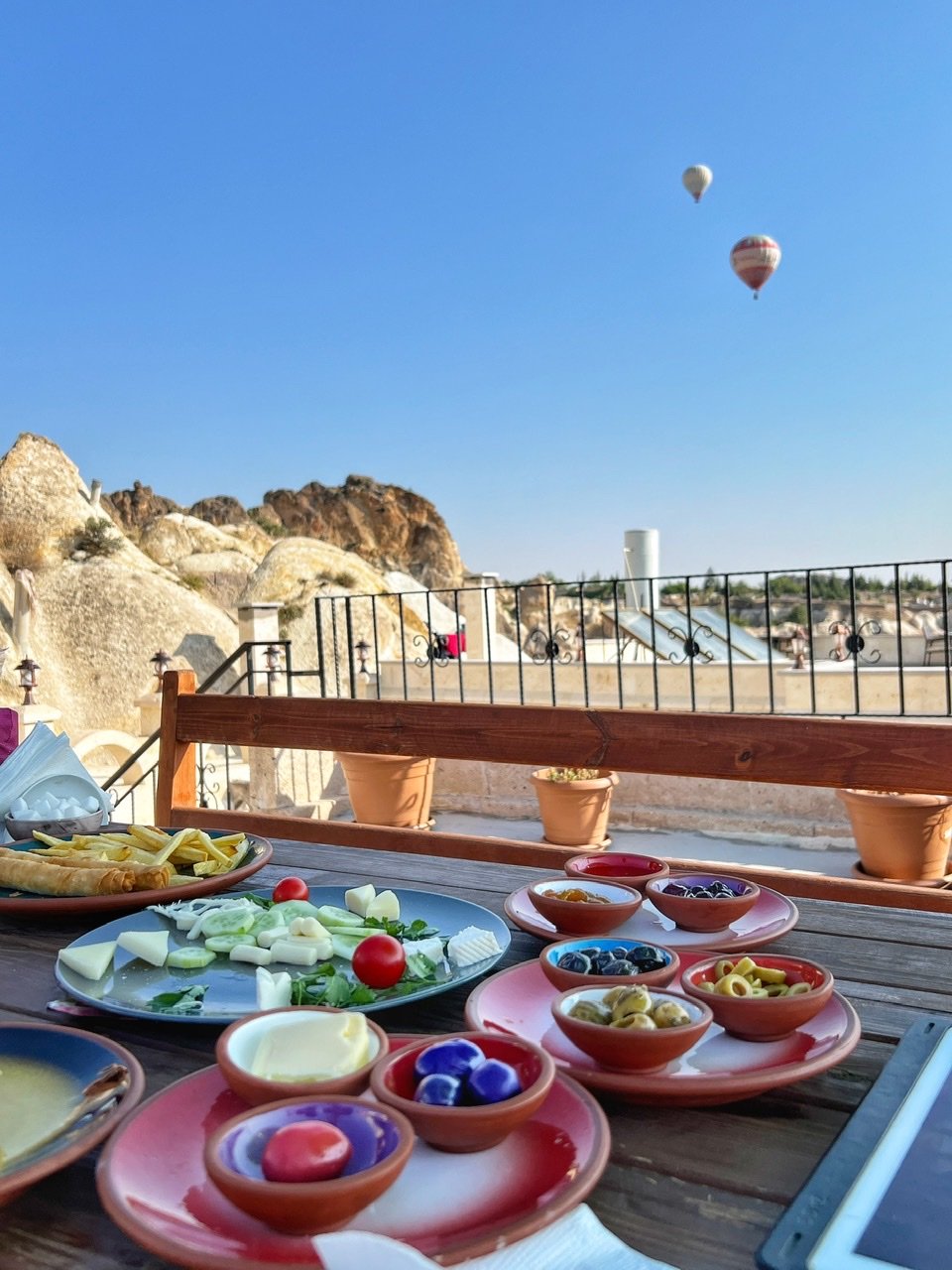
The full shebang. In addition to the olives, jams and honey, it always included a plate of cucumbers, tomatoes and cheeses, something fried like eggs or potatoes, bread and mint tea. The view looking east was to Mt Erciyes, which is more than 12,851 feet or 3900 meters, and sometimes included some stray balloons or two floating overhead.
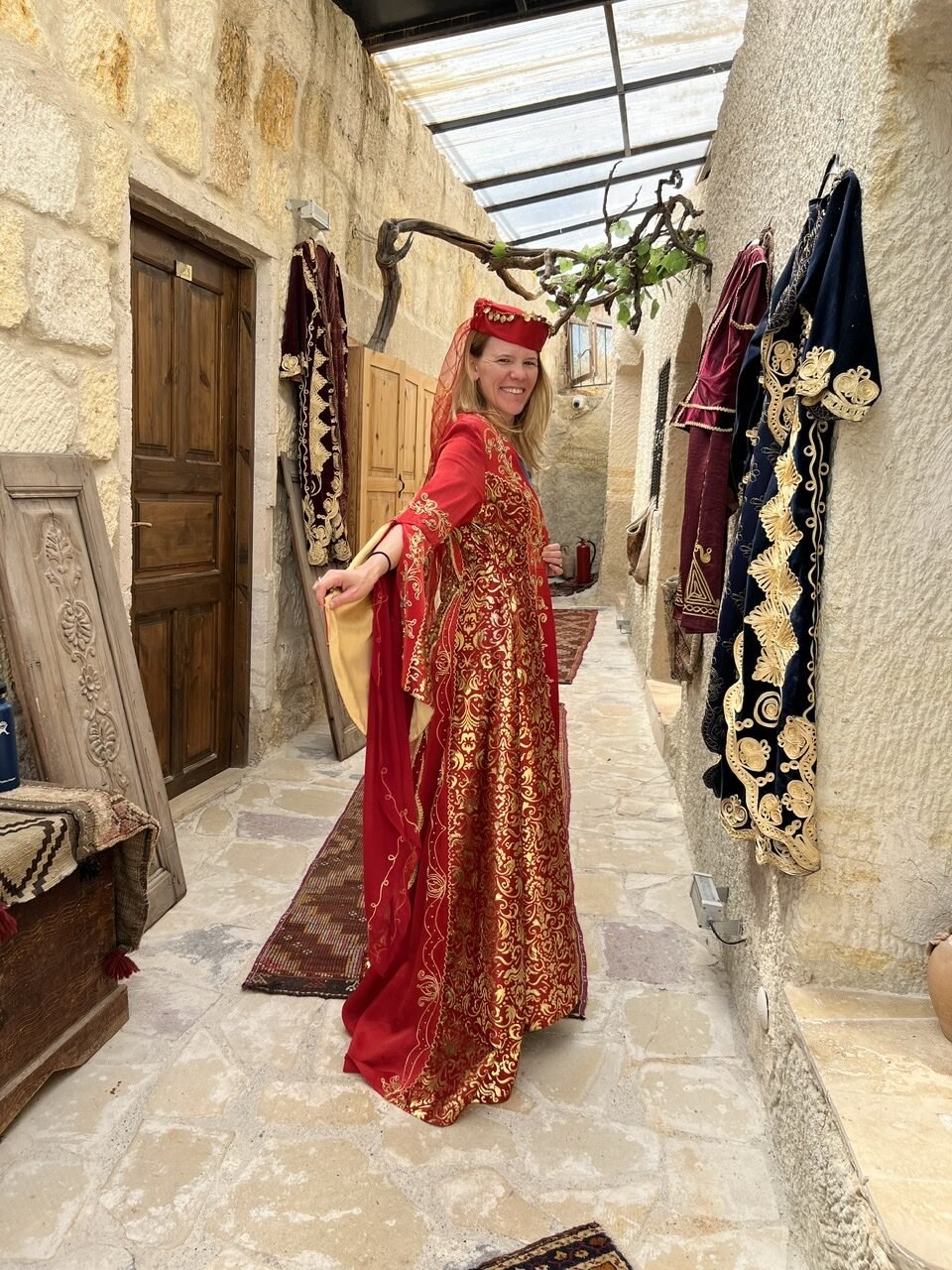
Time for dress up. And no, Mandy disappointingly did not take this out in public.

Mandy and Sehat, the owner, who was incredibly friendly and spoke four languages…Turkish, English, Dutch and German.

Our room for five nights.
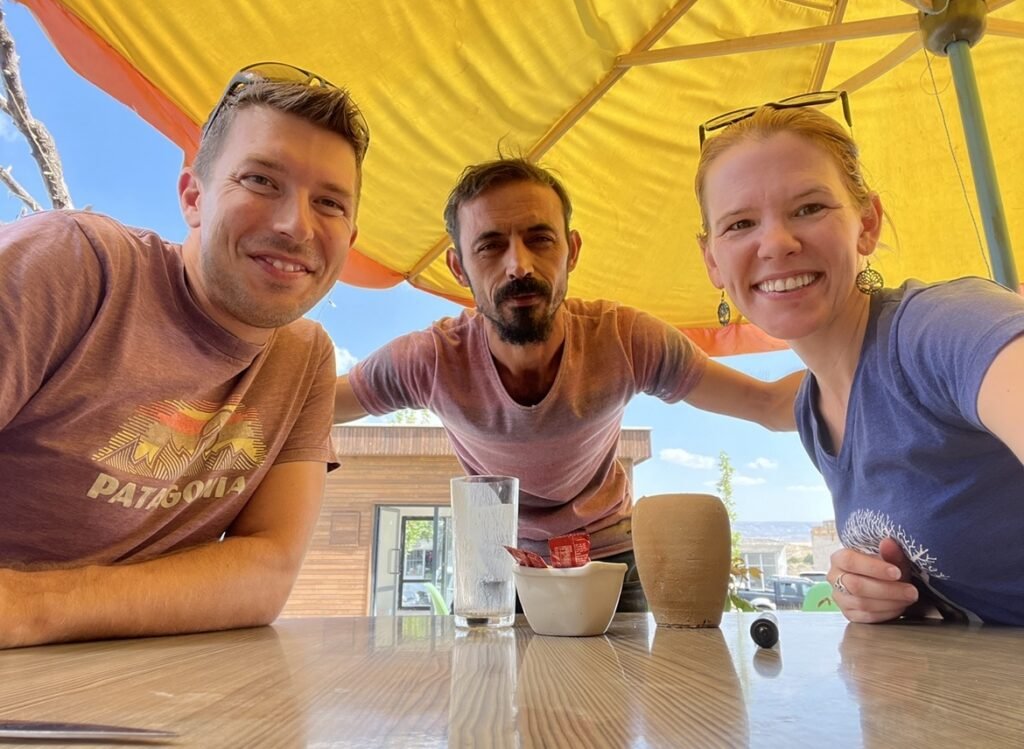
While mingling in Ortahisar, Muhammad the writer/barman/restaurant owner/traveler/welder proved he had many skills with his resume of credentials. He was the owner of one of the restaurants we visited. We chatted about his travel dreams, especially regarding Thailand, writing and why we chose not to have children. As a 36-year-old bachelor, he was a bit mystified that you could get married, live a life of travel, and not have children. It seemed quite intrigued by this foreign concept.
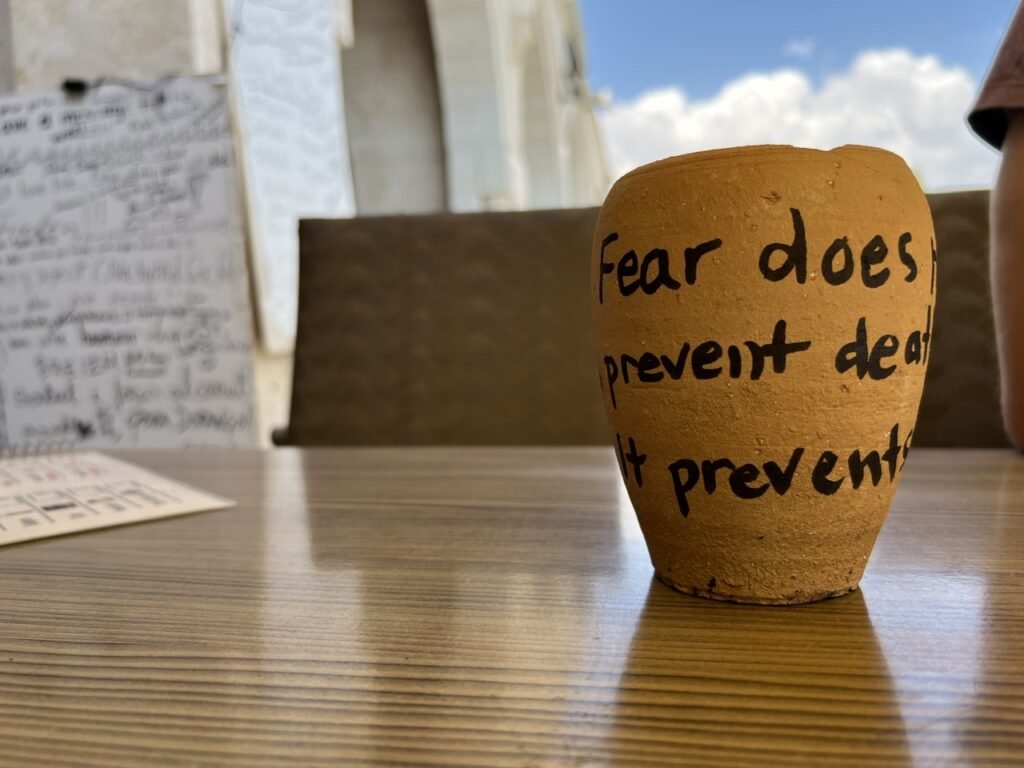
Cooking meat in pottery dishes is quite common in this part of Türkiye so one fun thing Muhammad does is have his guests write a meaningful phrase on a piece of cookware. The cookware will then randomly be selected and paid forward to a future guest. We hope ours goes to the perfect person. It says, “Fear does not prevent death. It prevents life.”
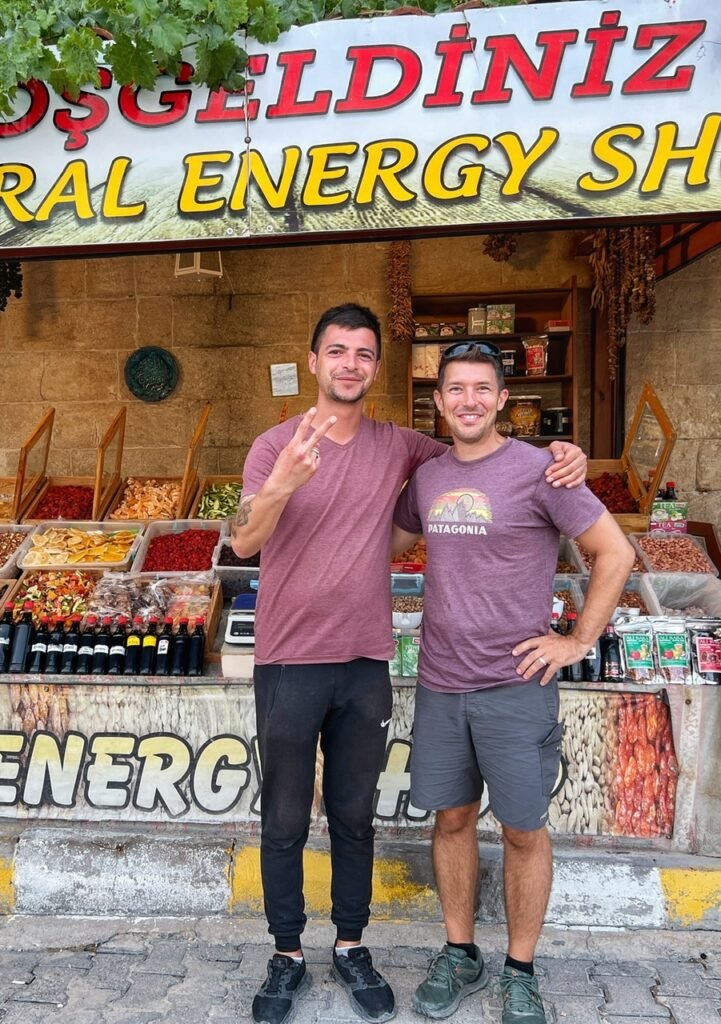
27-year-old Mustafa was our official “nut guy” in Ortahisar and after a couple visits, he invited us to have tea with him.
His stand featured nuts, dried fruits and seeds of all varieties coated with enough bees to drive nearly any man crazy…but they didn’t. He truly seemed to take great pride in his shop and enjoyed his life of working 18 hours a day, for the last 11 years, only going home to his parents’ house to shower and sleep.
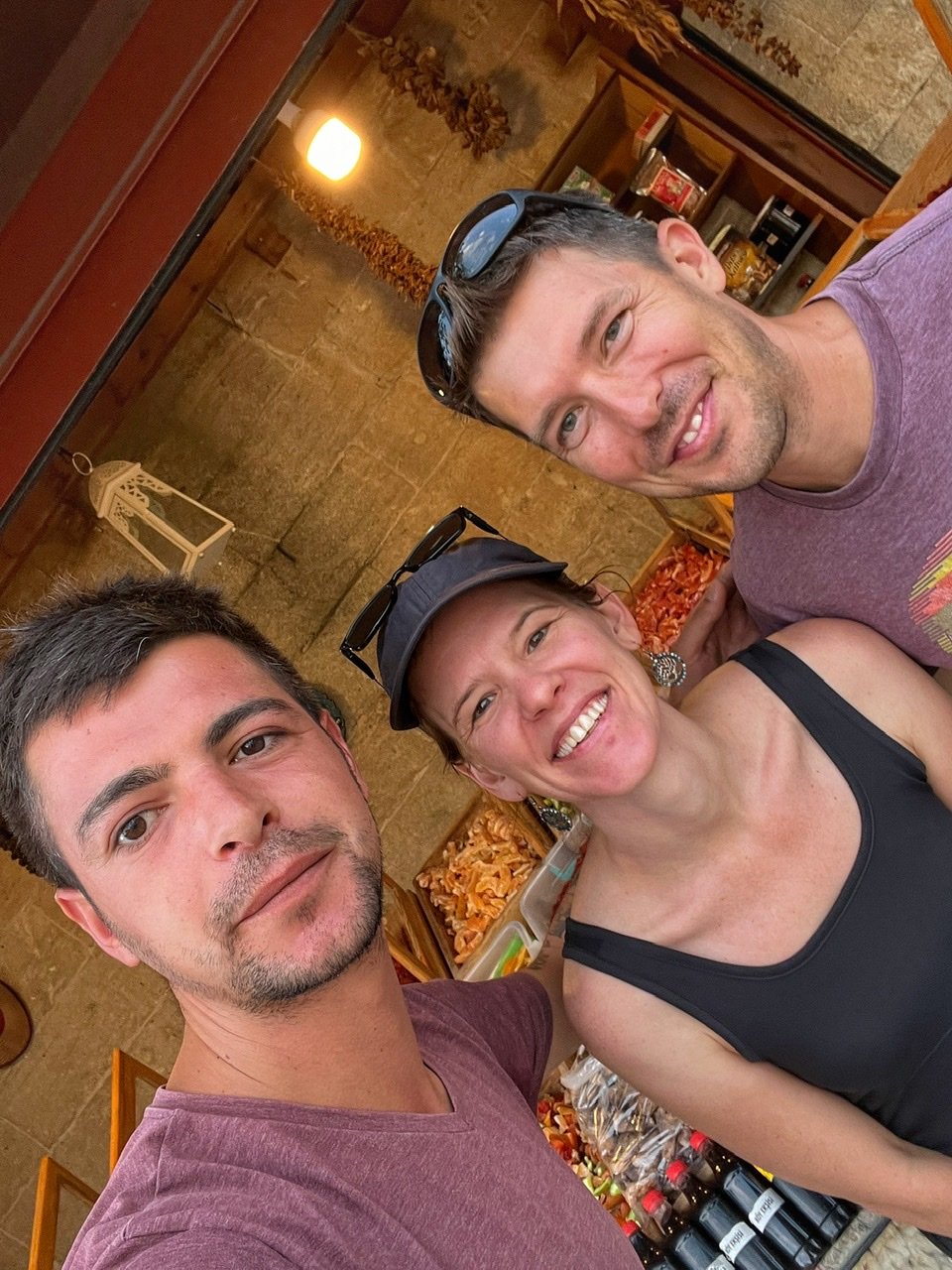
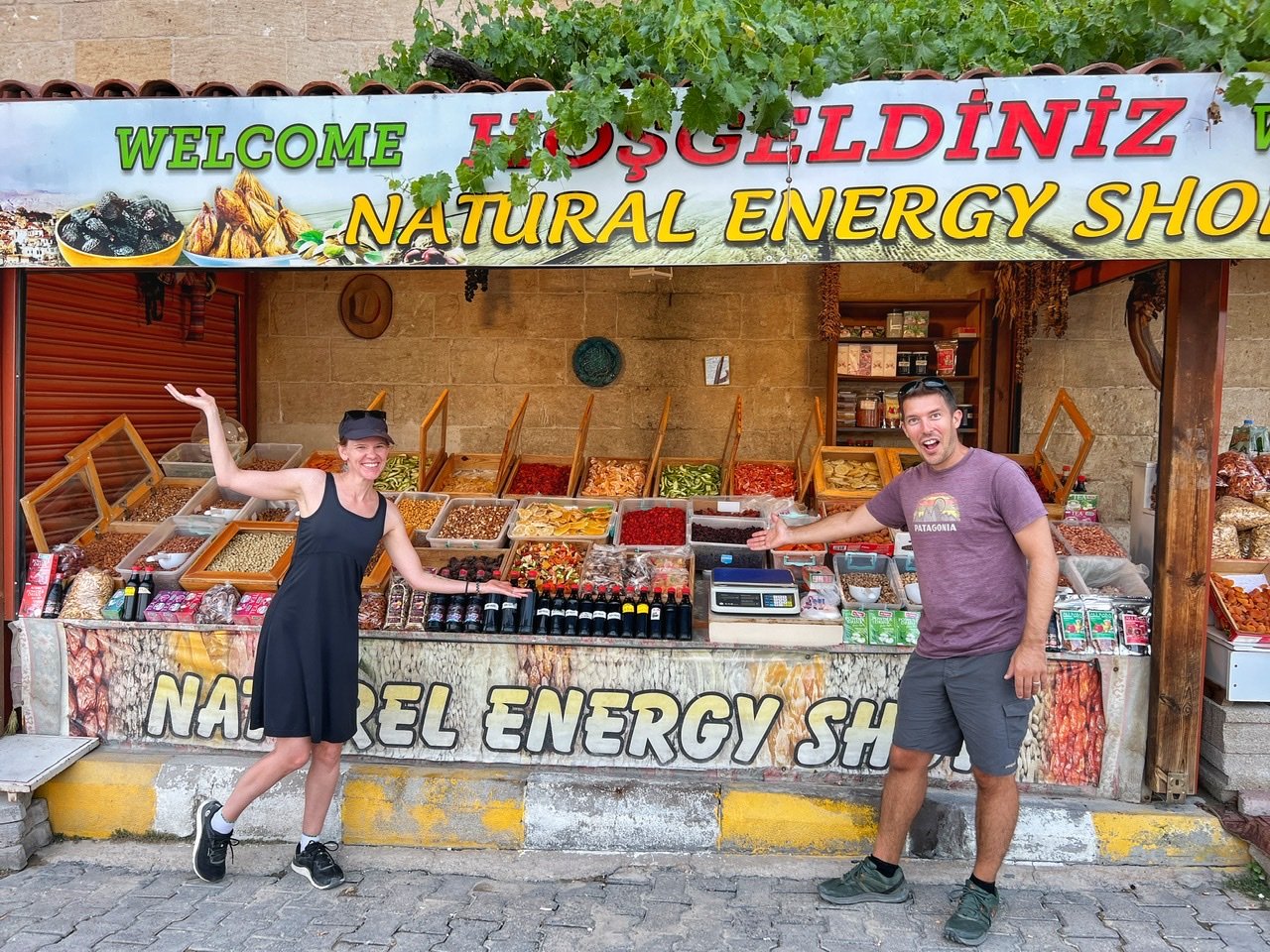
When we had apple tea (yay!! Variety!) with him, there was one question he tossed at us very quickly…”are you happy?” This question has surprisingly been asked of us multiple times in Turkiye. It seems to replace the obligatory Ameri-inquiry of “what do you do?” and is beyond refreshing. After all, this is what really matters.
Another question game the Turks like to play is “How old am I?” pondering how old we think they are. Unfortunately, every single time we’ve guessed a bit older than they actually are, even though we think we’re aiming conservatively young. Sorry guys, not sure all that caffeine and nicotine are doing you any favors! ?
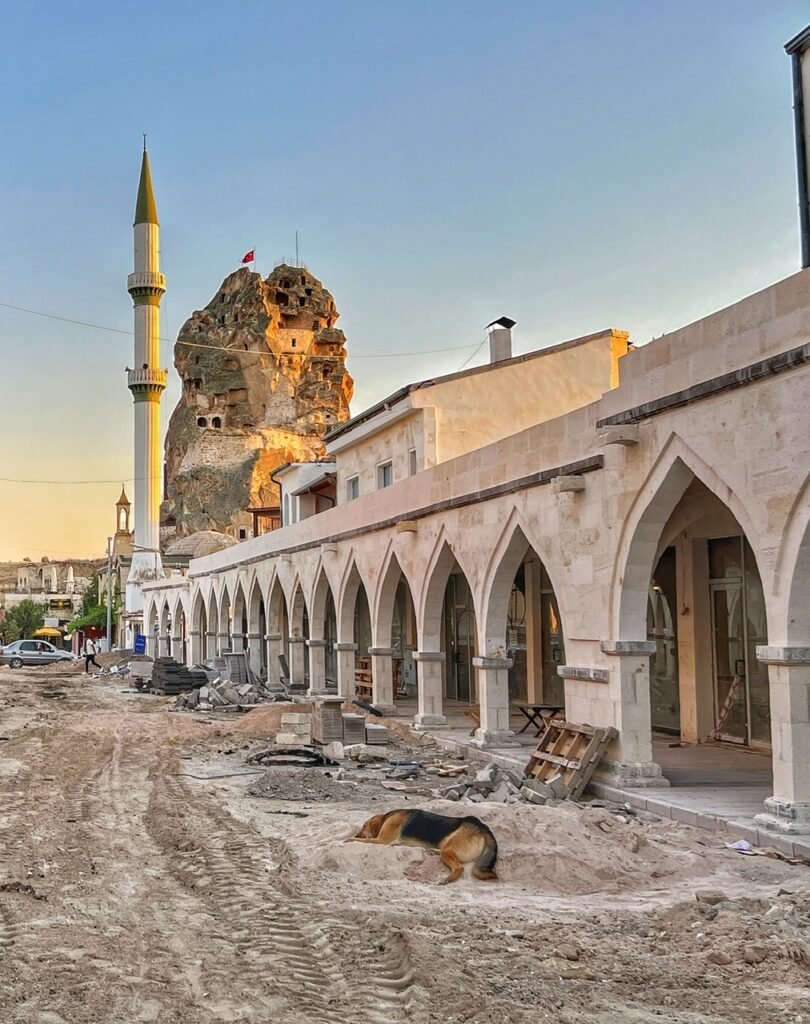
The main thoroughfare of Ortahisar was unfortunately ripped up due to construction but it still offered a welcome ambience. Like in Istanbul, there were quite a few cats and dogs roaming Cappadocia although they seem to keep the dogs relatively quiet. (Or, it could just be the thick stone walls of the accommodations!)
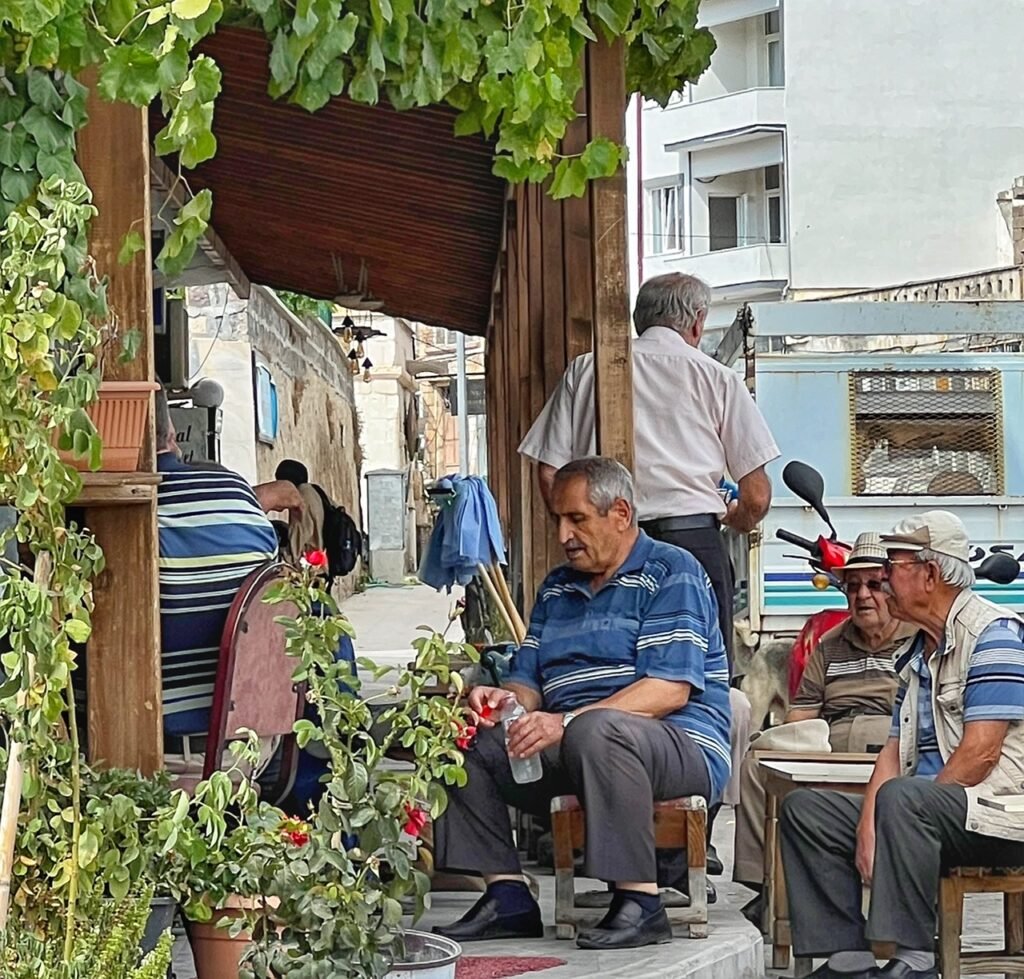
The local men in the corner cafe.
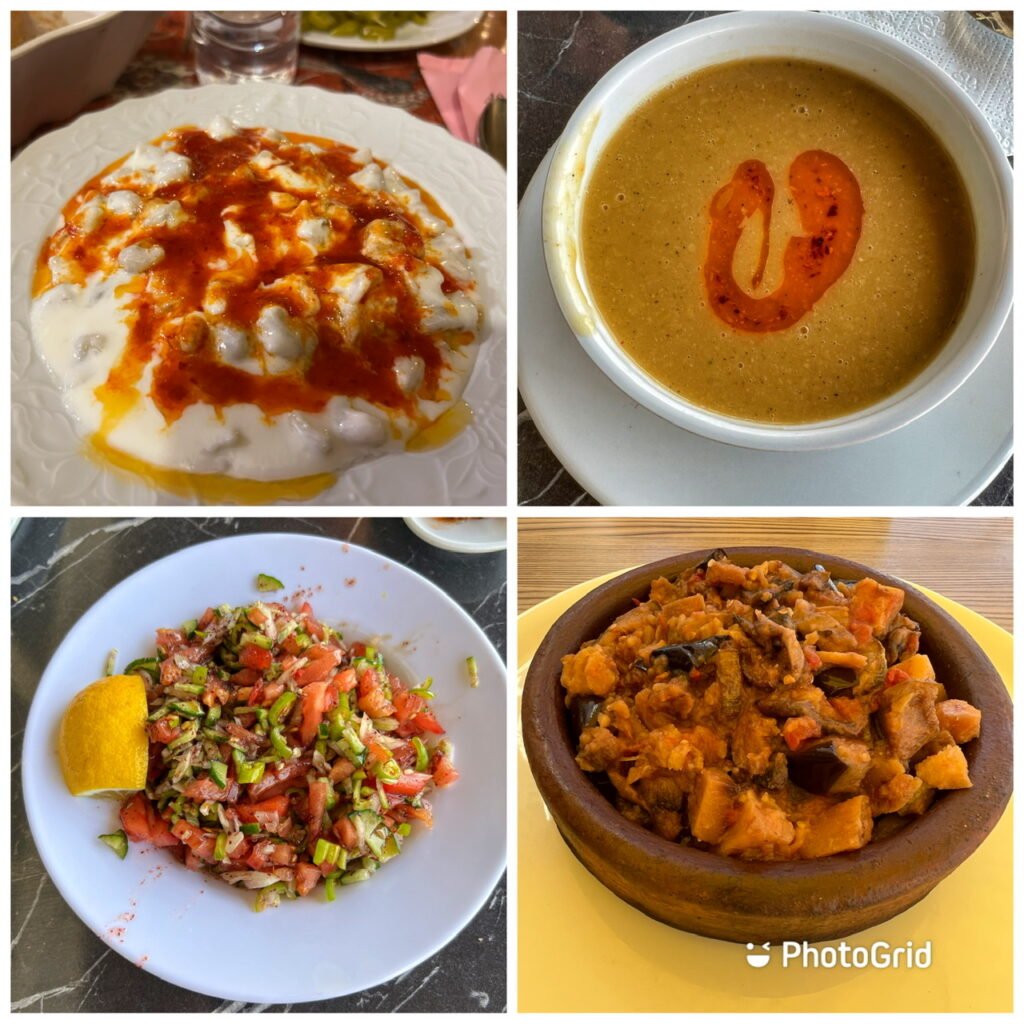
A selection of the food we had in Ortahisar:
- Manti-which means dumpling in Turkish is traditional comfort food. Small ravioli type pasta with meat filling and topped with a garlic yogurt sauce and chili oil. (80 Lira or $4.25)
- Çorba-lentil soup (30 Lira or $1.60)
- Kasik salatası or spoon salad-definitely our favorite salads in Turkiye so far. It features finely chopped tomatoes, cucumbers, peppers, parsley, onions topped with sour pomegranate sauce, olive oil, mint, lemon and sumac. It might just beat out taboulleh (30 Lira or $1.60)
- Eggplant, tomatoes and potatoes (80 Lira or $4.25)
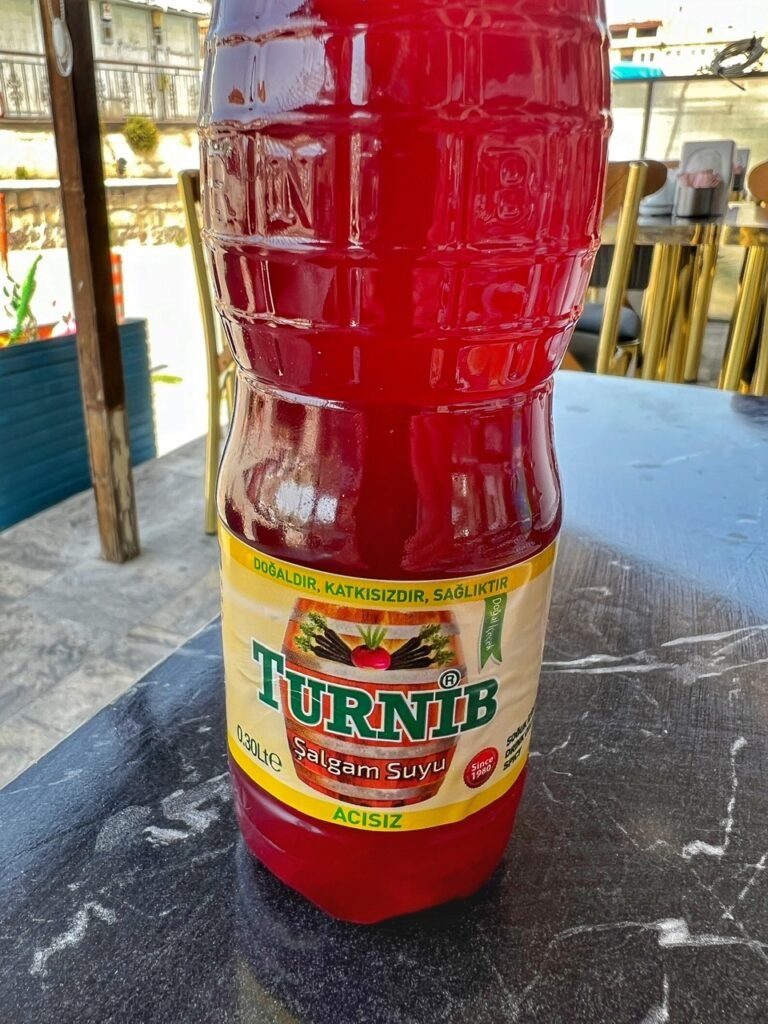
A fermented drink called Salgam is made of fragrant turnips, purple carrots, bulgar wheat, salt and yeast. The turnip was not too noticiable, slightly sweet with a bit of tang. All in all, we didn’t love it but didn’t hate it either. Interesting drink.

The exterior or the Culture Museum in Ortahisar.
Ortahisar Castle

The castles of Cappadocia are basically polar opposite to the ones we’ve checked out recently in Western Europe. There are no fairytale turrets, no astounding architecture (at least man made variety), no photos of royalty or no magnificent grandeur. Instead, the castles of Cappadocia are giant lumps of rock completely composed of volcanic tuff which has taken its fundamental form due to wind, rain and erosion in hundreds of years. However, the insides are miraculously carved by human hands and have a remarkable history which makes it very much worth a longer look.
The Orthisar fortress, carved out by the Hittites around 2nd Century BC, was our favorite of these castles. There’s far less people, (it was nearly empty at 6 pm), it costs $.50, and it involved clambering up practically vertical ladders, peering through lookout holes, slinking through constricted passages and once at the peak, you get rewarded with a helluva view.
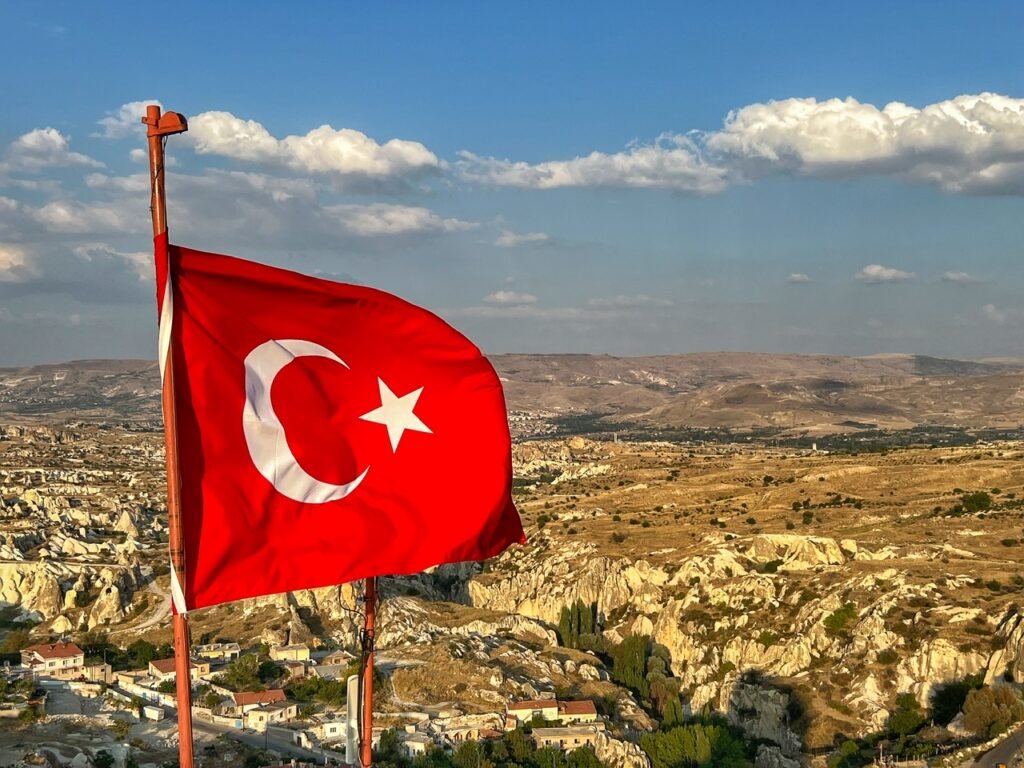
From the top, we took in the valley of Hallacdere, aka the fairy chimneys valley, and the majestic volcano Erciyes, looming on the horizon.

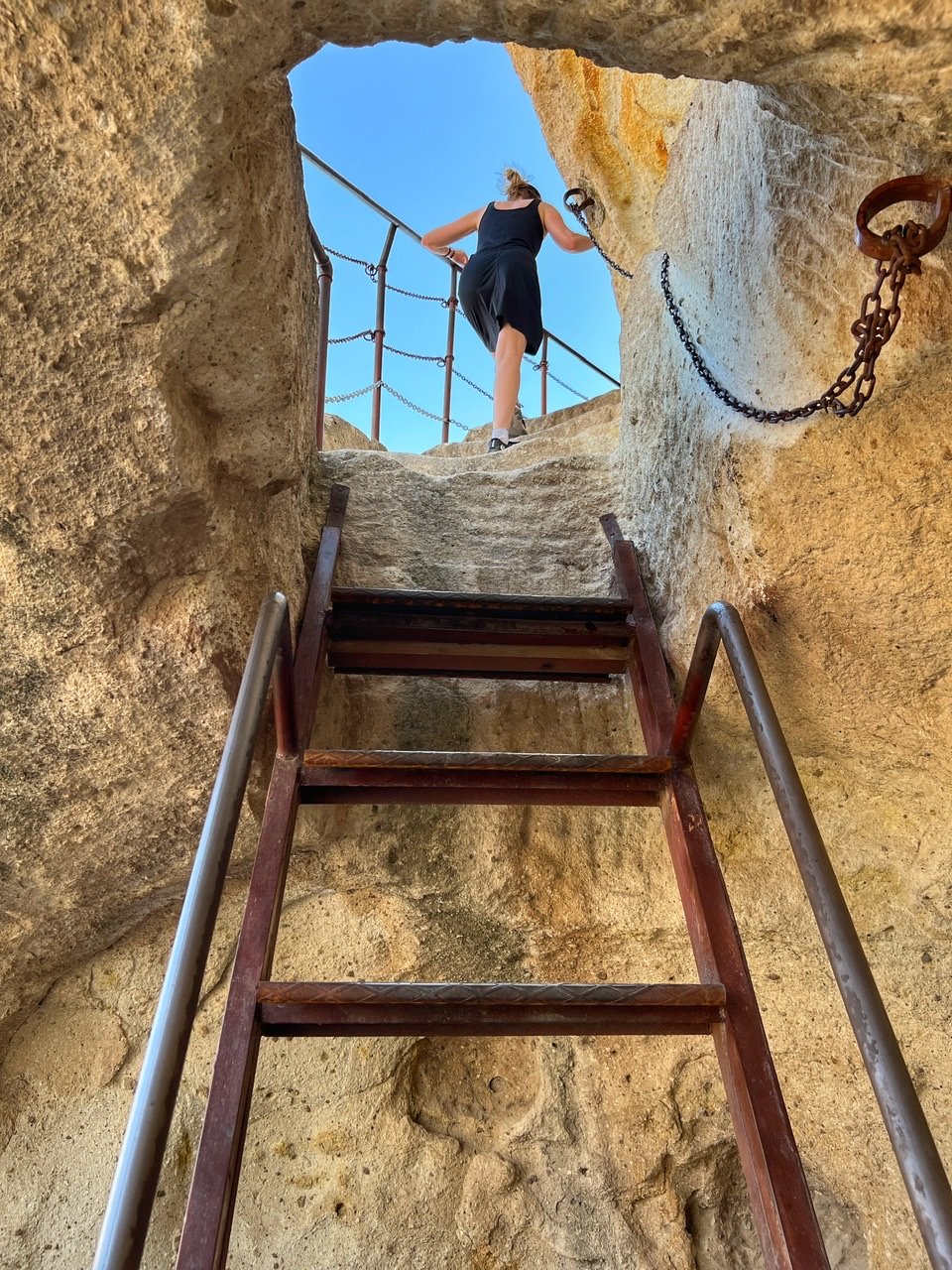

But first we had to get there. Up she goes…good day to wear a dress. This picture doesn’t really capture just how vertical these stairs are! Oh my!
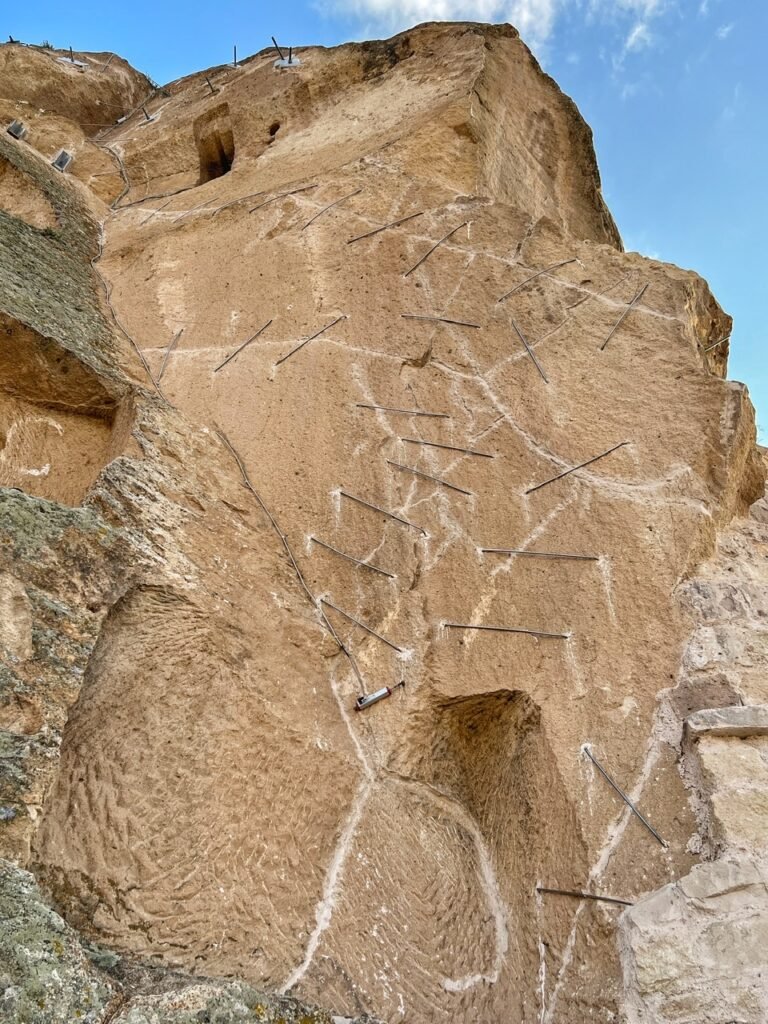
Oh by the way, the tuff volcanic rock Cappadocia is made of is not as tough as they name implies. It contains more than 75% ash, which might explain why it’s bustled together by giant staples. That said, it’s still managed to last 3000+ years.
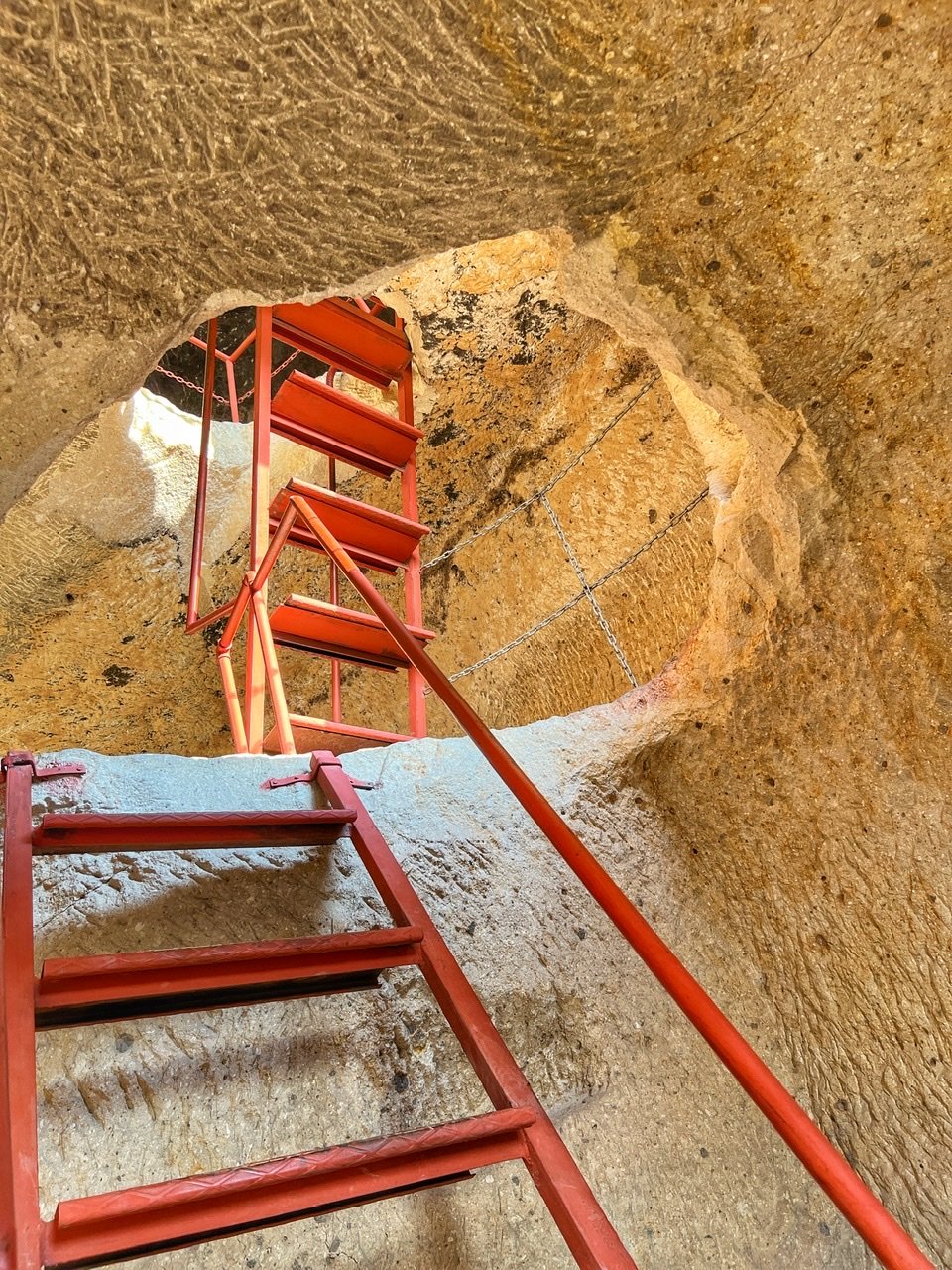

Up and up!!
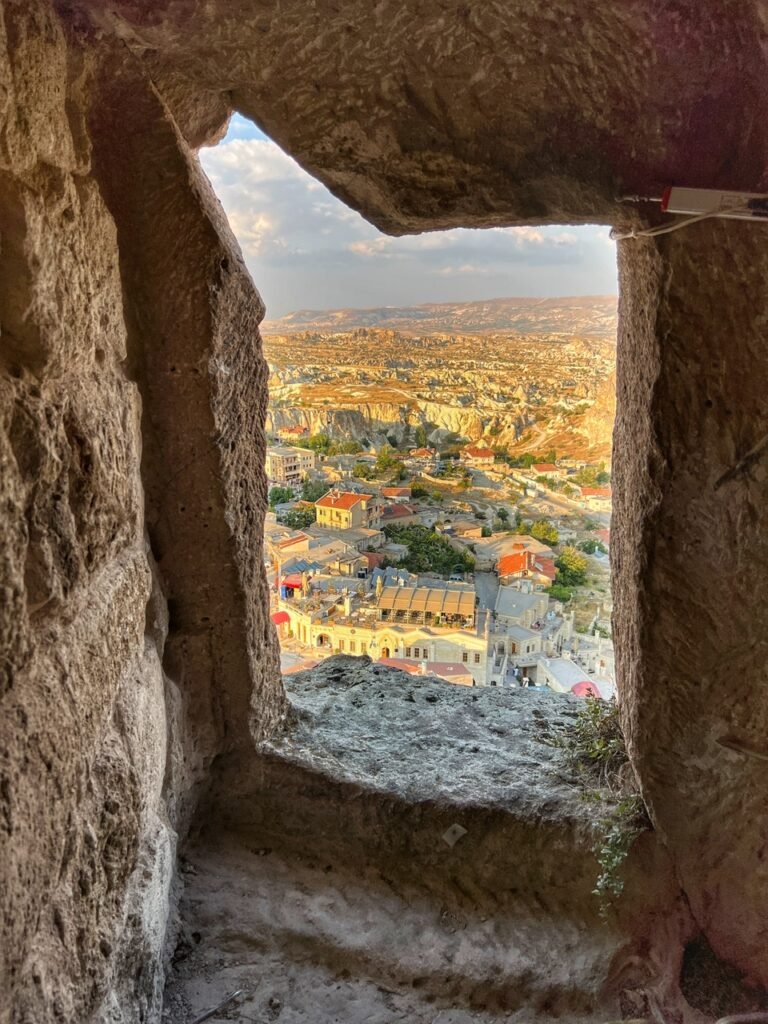
The views are getting good!
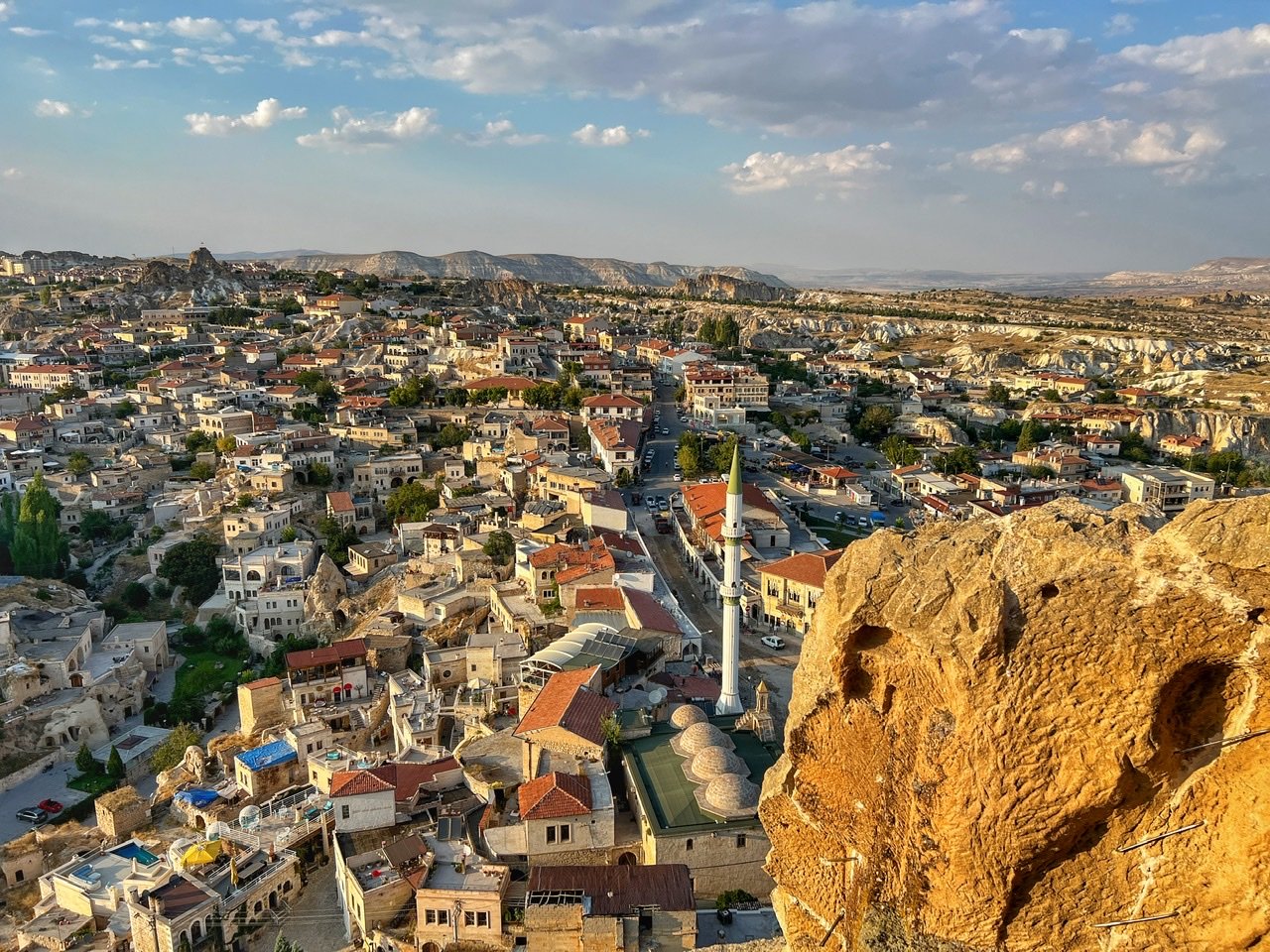

We made it!
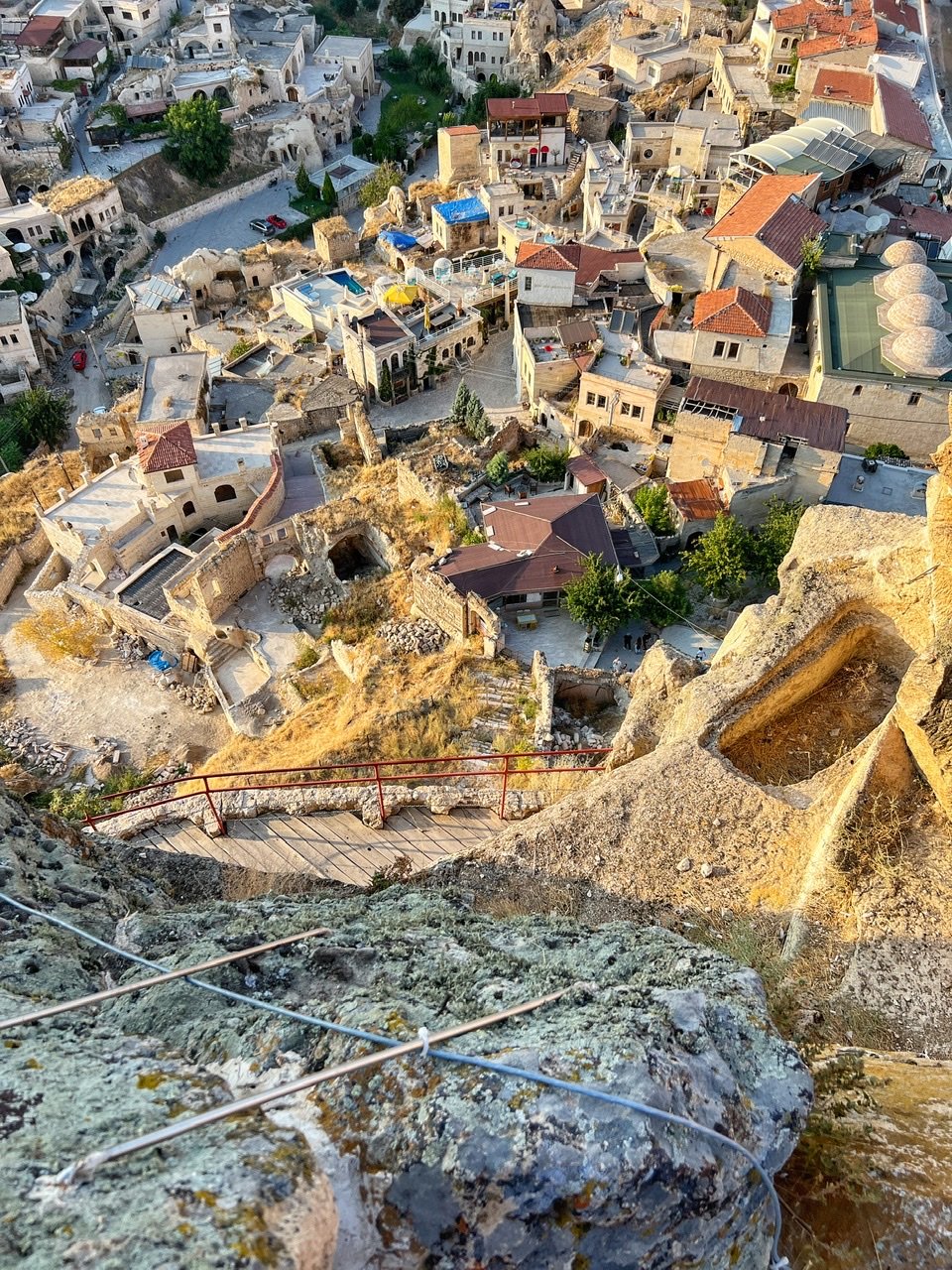
It’s a bit of a dizzying view looking down!
Ortahisar is normally a sleepy village of 14k but while we were at the top, we heard the horns of a Turkish wedding! Happy life to the newlyweds!
Uchisar Castle
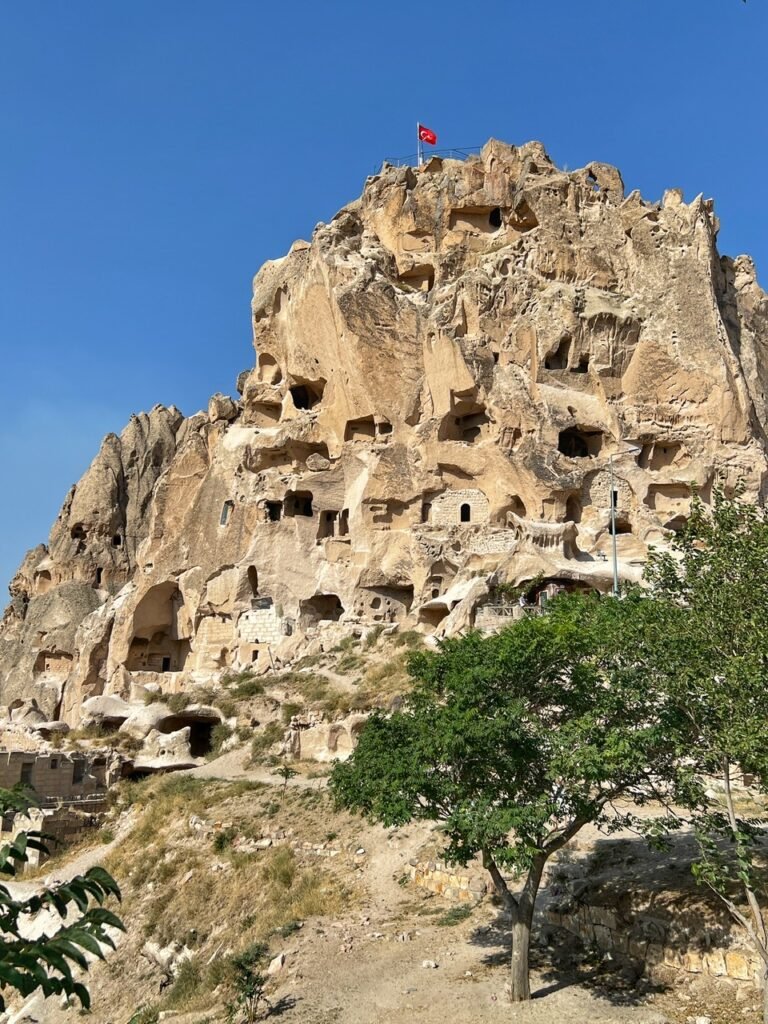
Uchisar castle is the most splendid of all the castles in terms of sheer size and tourist jams. It hosted many civilizations from the 3rd up to the 15th Century AD and was the first and main point of defense in the Cappadocia region. It is located about 1350 meters above sea level and is the highest point of Cappodocia region.
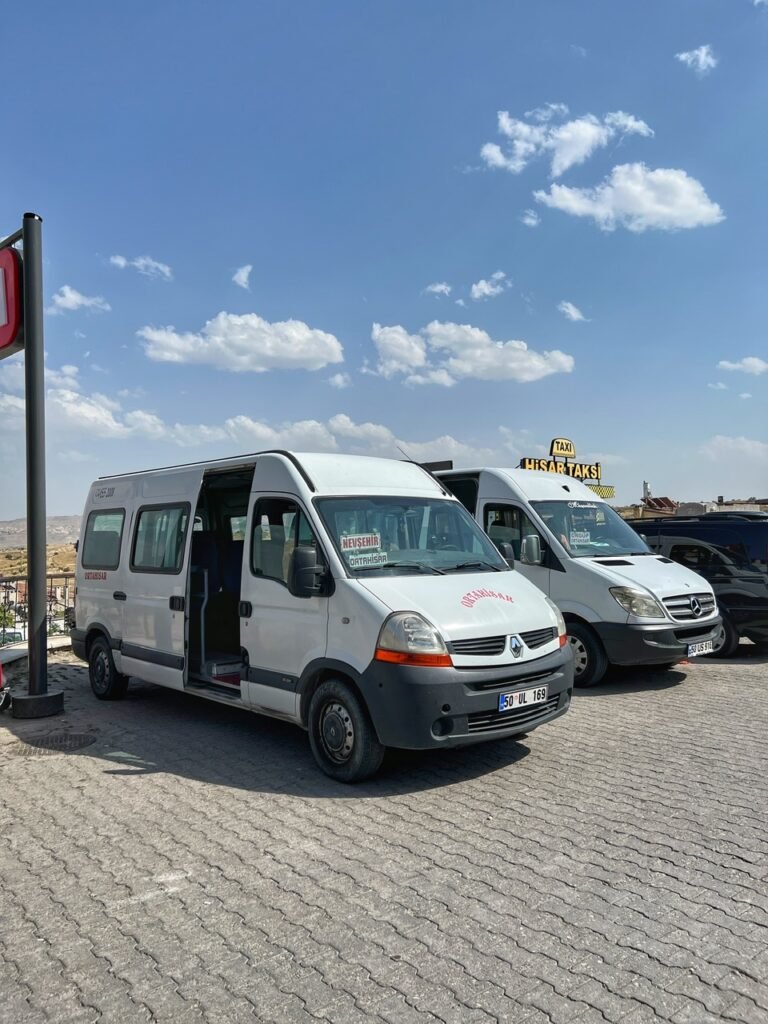
We got there by piling on a nearly empty local bus from our home in Ortahisar, a 15-minute taxi ride from Göreme. Local buses are very simple to use around Cappadocia and cost about $.50/ride. In this case, we had to ride to the “metropolis” of Nevşehir and transfer to Uchisar. And yes, all town names sound relatively the same to a foreigner here.
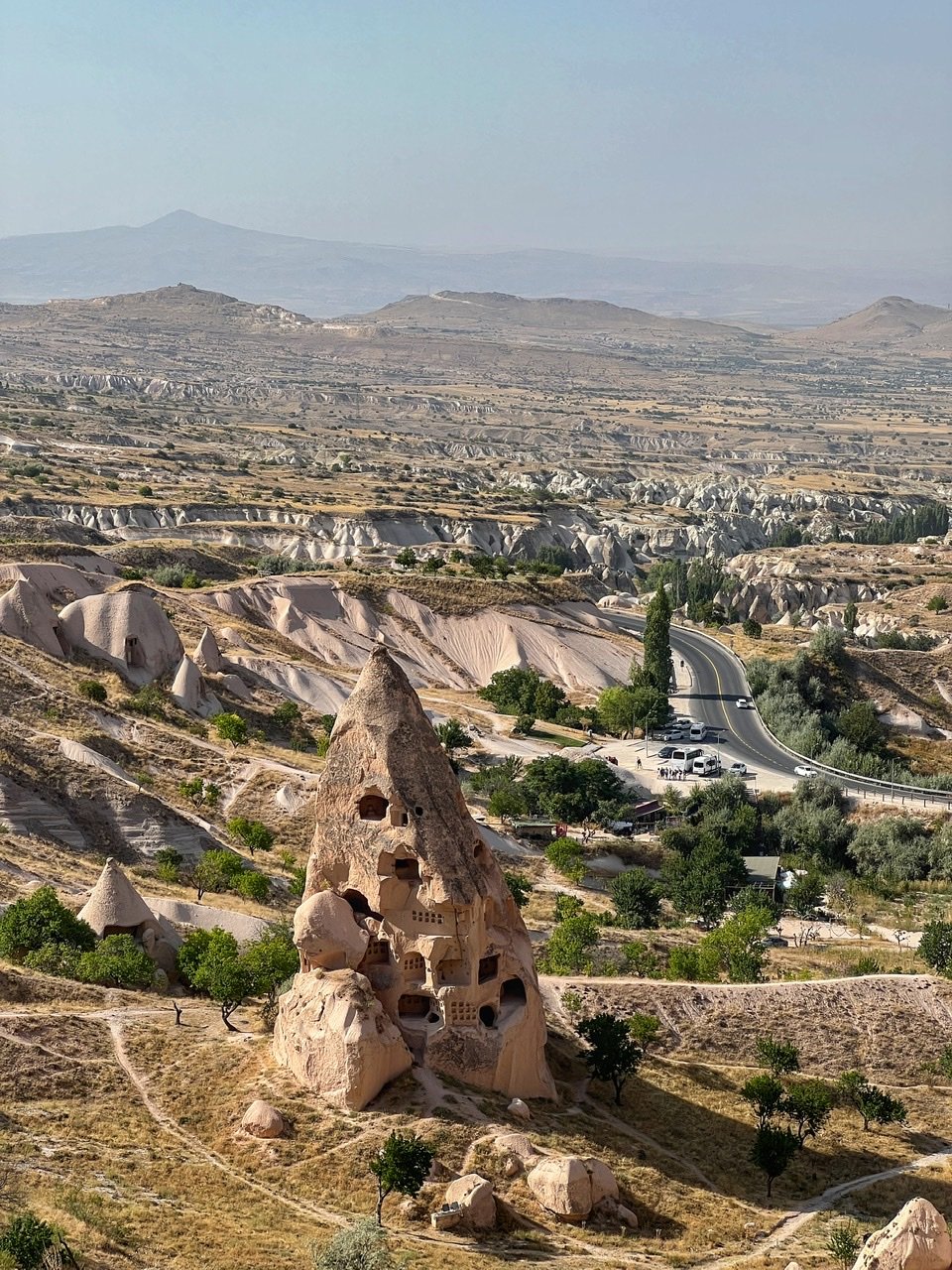
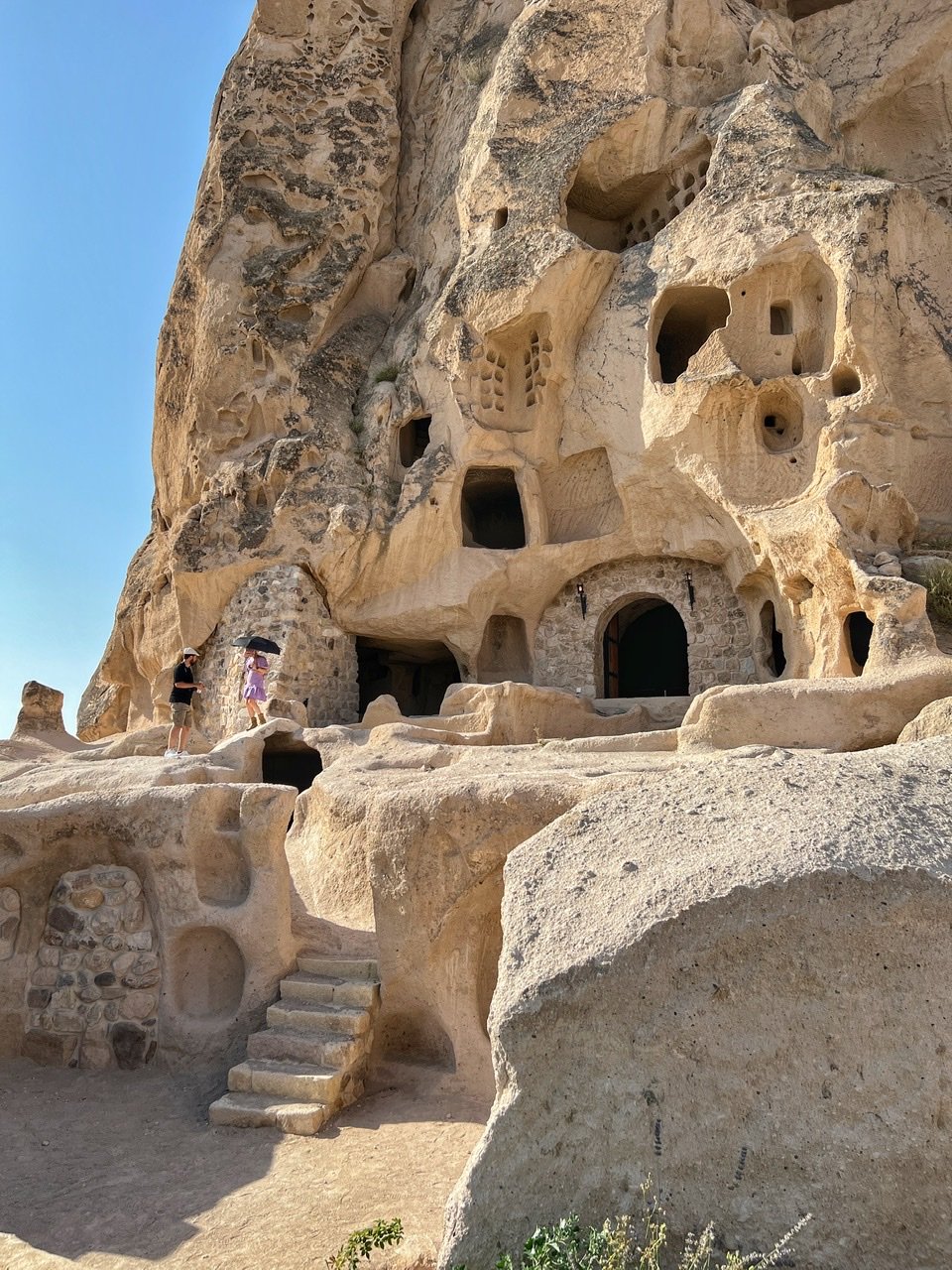
The striking view as you enter the castle complex. It’s a major tourist attraction in Cappadocia and costs 100 Lira to enter ($5.50). We chose to go late in the day which made it far less busy.
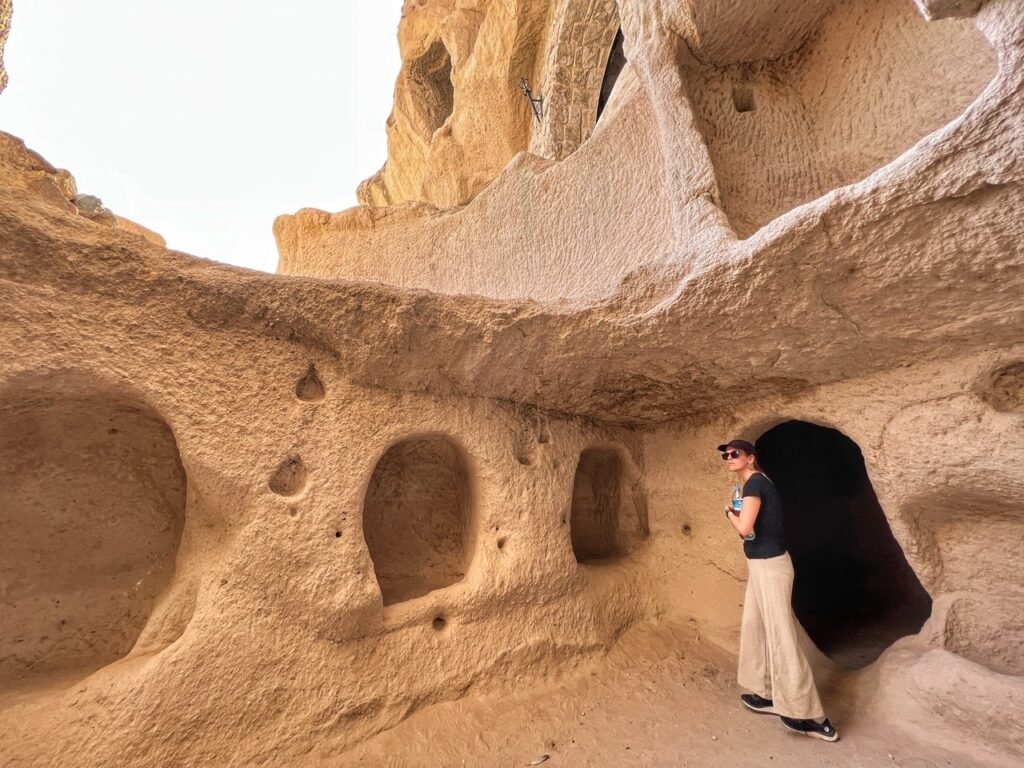
Having a peek inside. The rooms in the main rock mass within the fortress were used for security as the region was frequently exposed to invasions.

We have learned that these were used for ancient wine making. Glad to see the 10th Century security guards were enjoying their downtime. In fact, social life in Cappadocia took its first form in this castle.
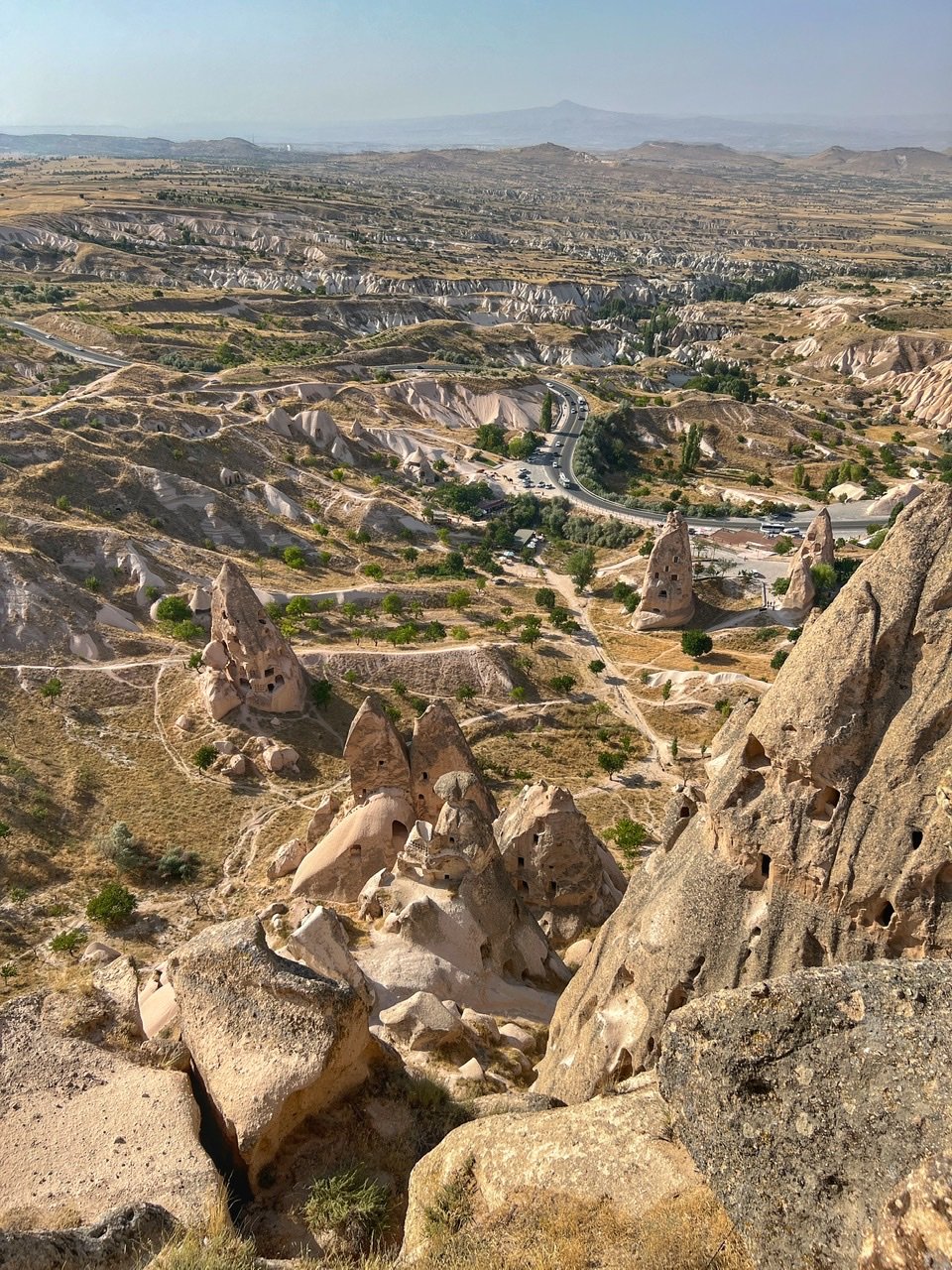

Viewing fairy chimneys from far above. And, check out this boulder balancing atop ?
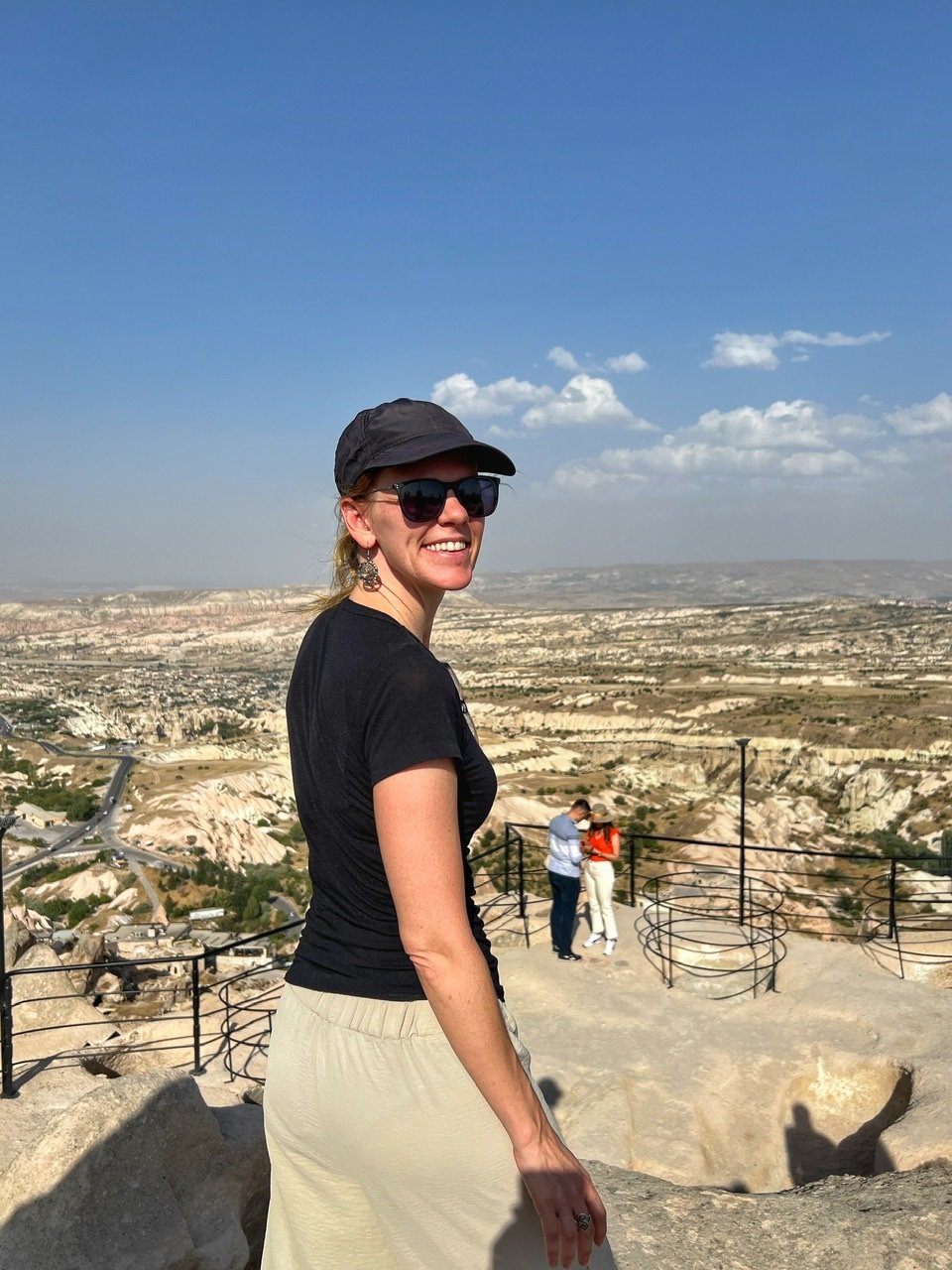
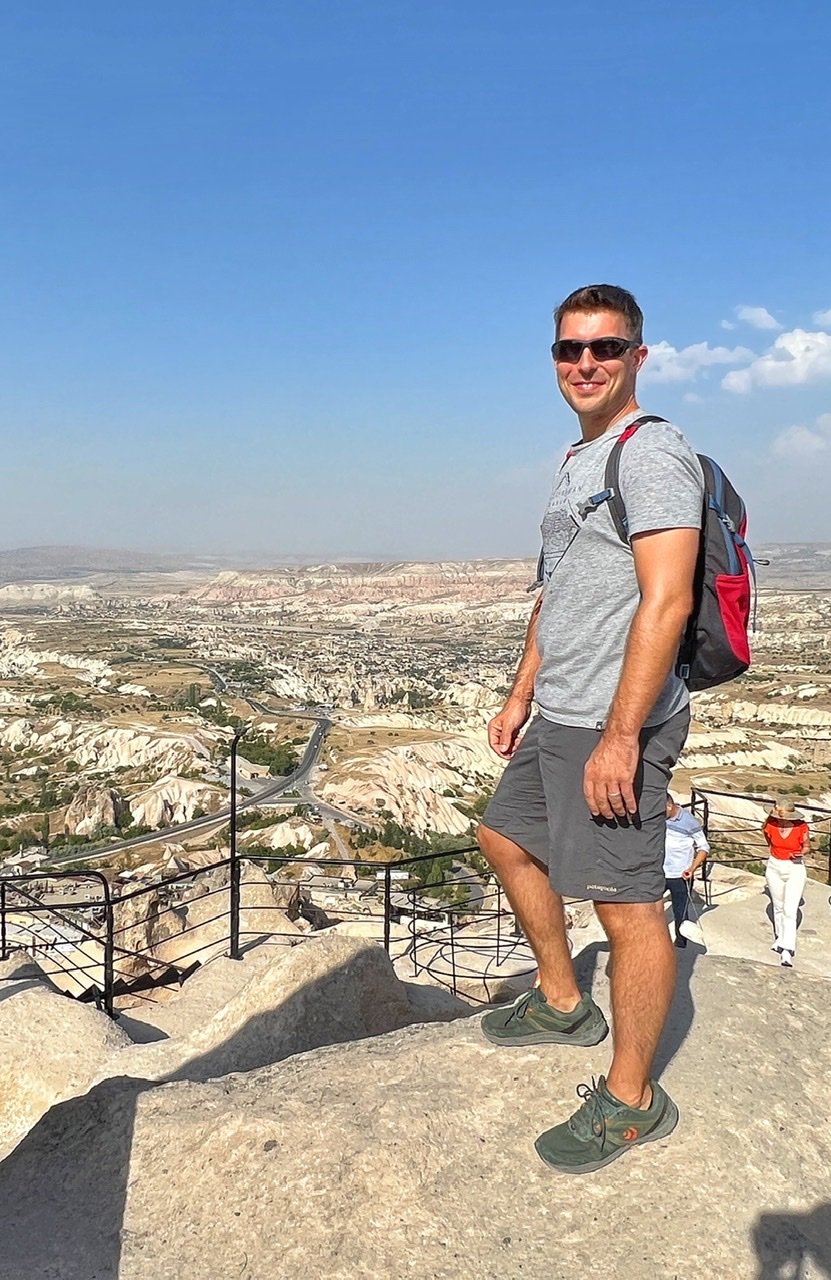
What a commanding view of the area! You reach the peak of 95 meters in a quick jaunt of 275 stairs.
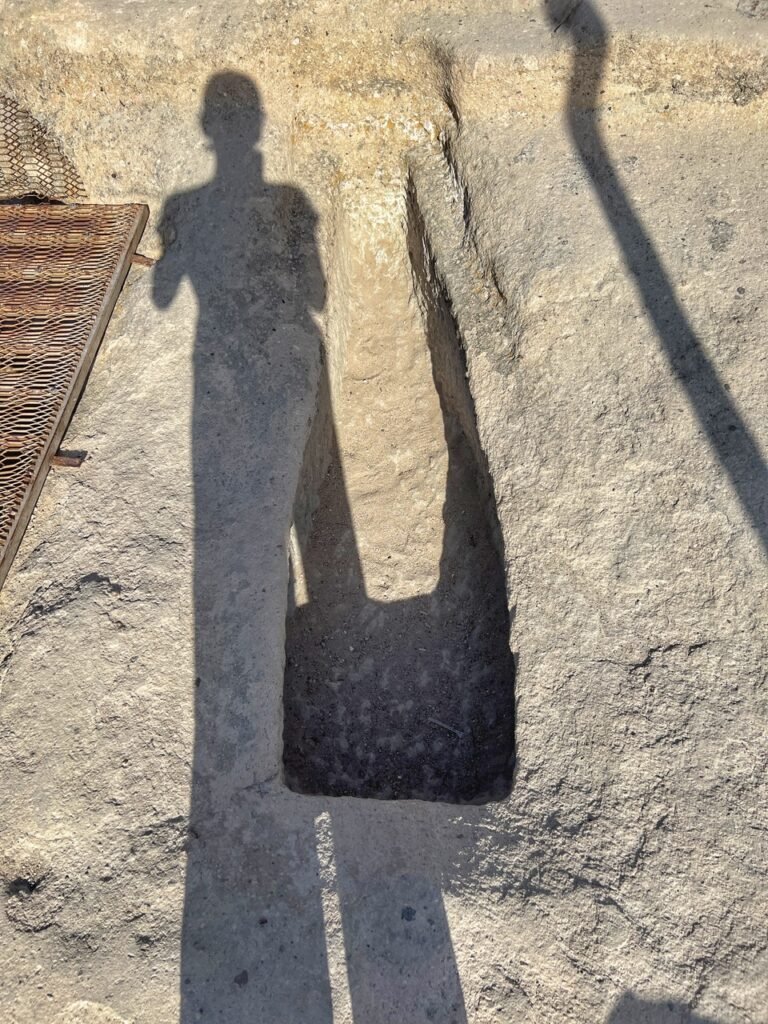
Interestingly there were crypts at the top. Mandy tried to line her shadow up as if she was inside but it didn’t quite work out.
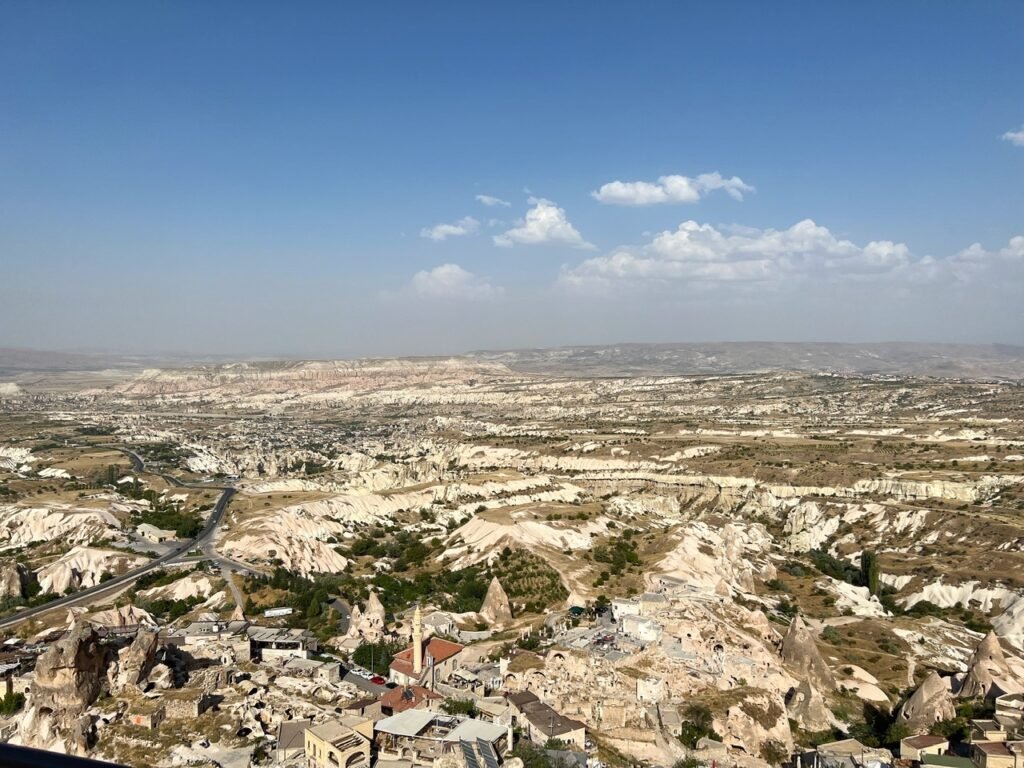
The endless expanse of Cappadocia. From the top of Uchisar Castle, we could see every town around including Göreme and where we stayed in Ortahisar.
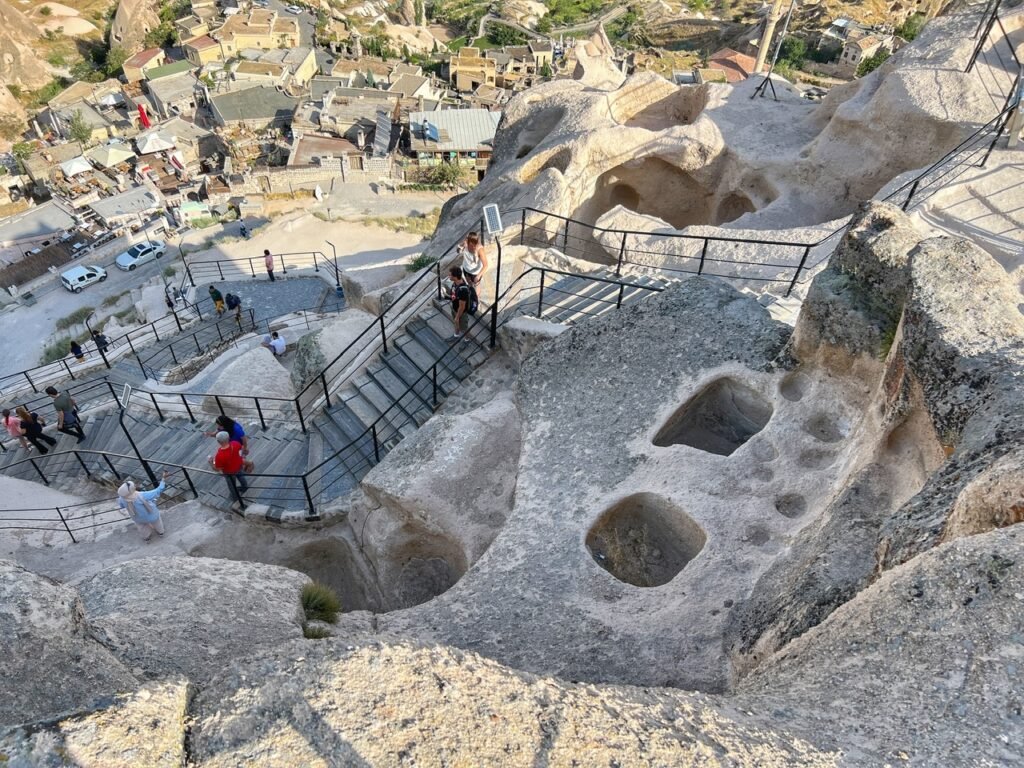
The stairs we traversed to get to the top. The real question is…how’d they truck their way to the top 1000 years ago?
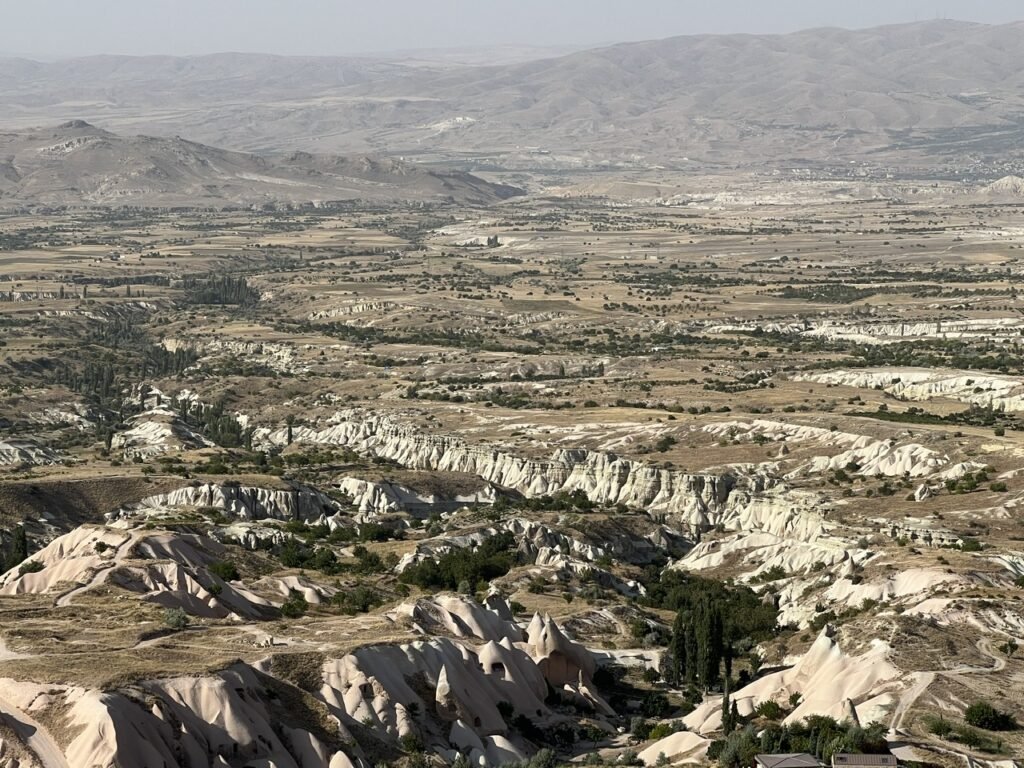
The spectacular canyon we were about to hike through to get back to Göreme. See hiking in Cappadocia.
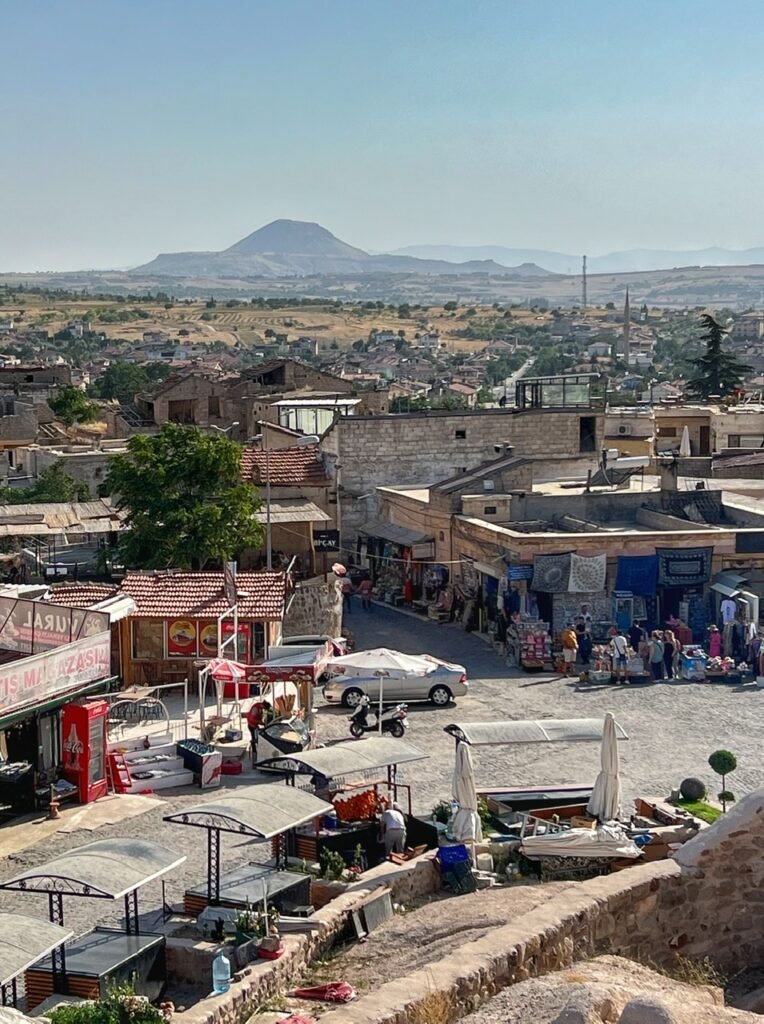
The town of Uchisar which was located on the route of the Silk Road, has a very strategic point. We liked the feel. Much less touristed than Göreme but still with a lively atmosphere and lots to do.

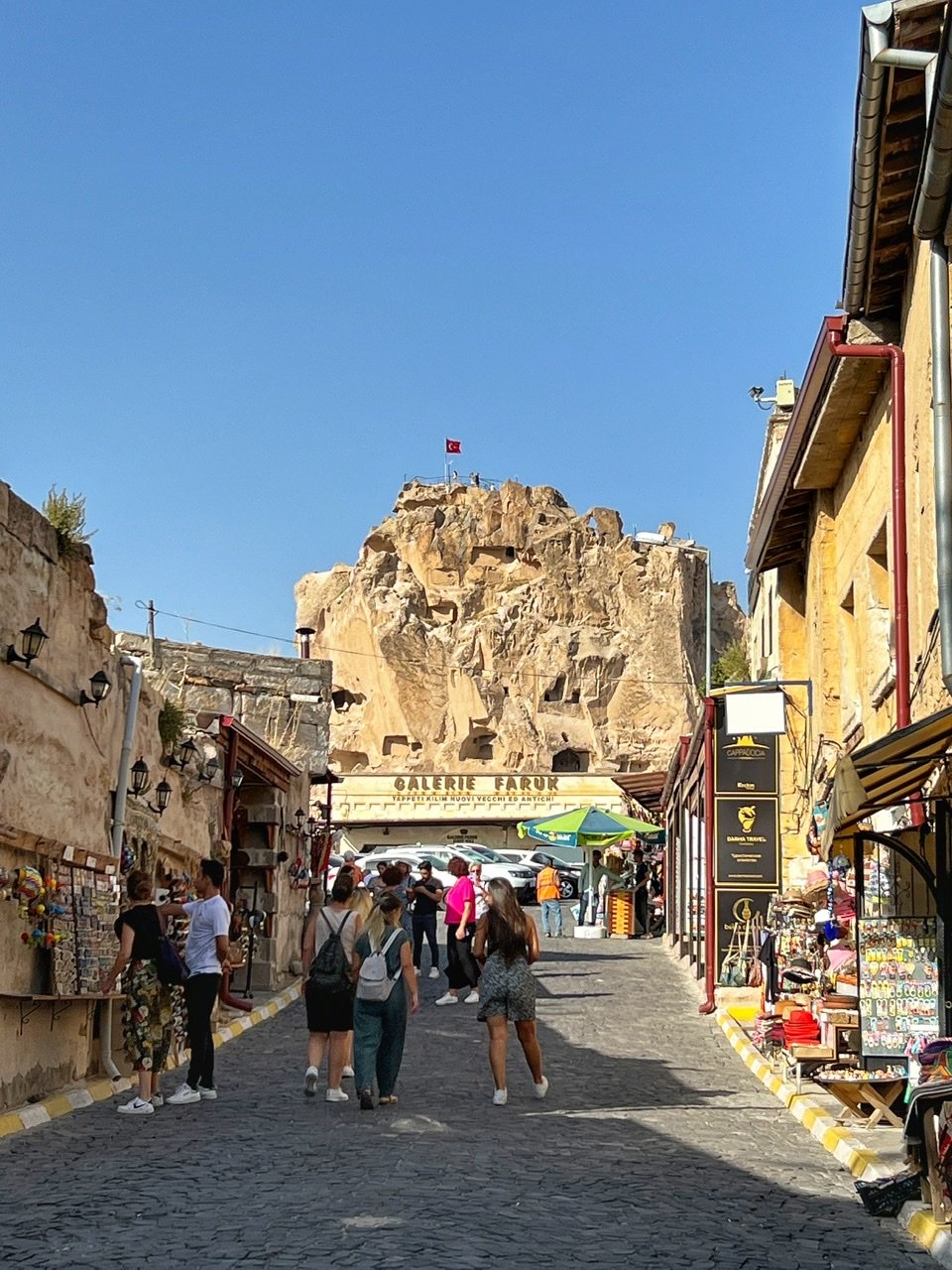
Including a plethora of antique shopping! The streets of Uchisar, one of five main towns in Cappadocia.
Red Valley (Real) Cave Stay

By the time we left Cappadocia we were convinced of three things: 1) Even eight days wasn’t enough. 2) This region is packed with a variety of unique and interesting activities at a great value (other than hot air ballooning—not so cheap!) 3) Finally, although it’s great for any curious individual, we highly recommend it as a family destination to teach kids about ancient civilizations and geology while having fun. From hiking in geologic wonderlands to crawling around in ancient castles, to scrambling through underground cities, to sleeping in ancient caves, it’s truly got it all!

We saved the best for our last night in Cappadocia by jeeping off the grid with our friends and experiencing it as it should be…tucked into an open lofted mini cave under the stars. This piece of treasure in the Red Valley was owned by our host Ibrahim, and it has been passed down for generations from his great grandfather. The entire land is packed with hiking trails, amounting to 3.7 acres.
There is nothing comparable to falling asleep gazing at the moon as you curl snuggly underneath the warm blankets, pillows and mattresses they provide and hearing the whooshing noise of hot air balloons overhead to make you begin stirring at 6 am.
We couldn’t recommend this extraordinary experience enough and it will definitely go into our “best of” list. It cost $57 on Airbnb which was again a splurge heavily tacked with service fees. Our friends, who booked directly with the owner, paid about $20 less.

We had to climb a steep but short rock staircase to summit our loft…
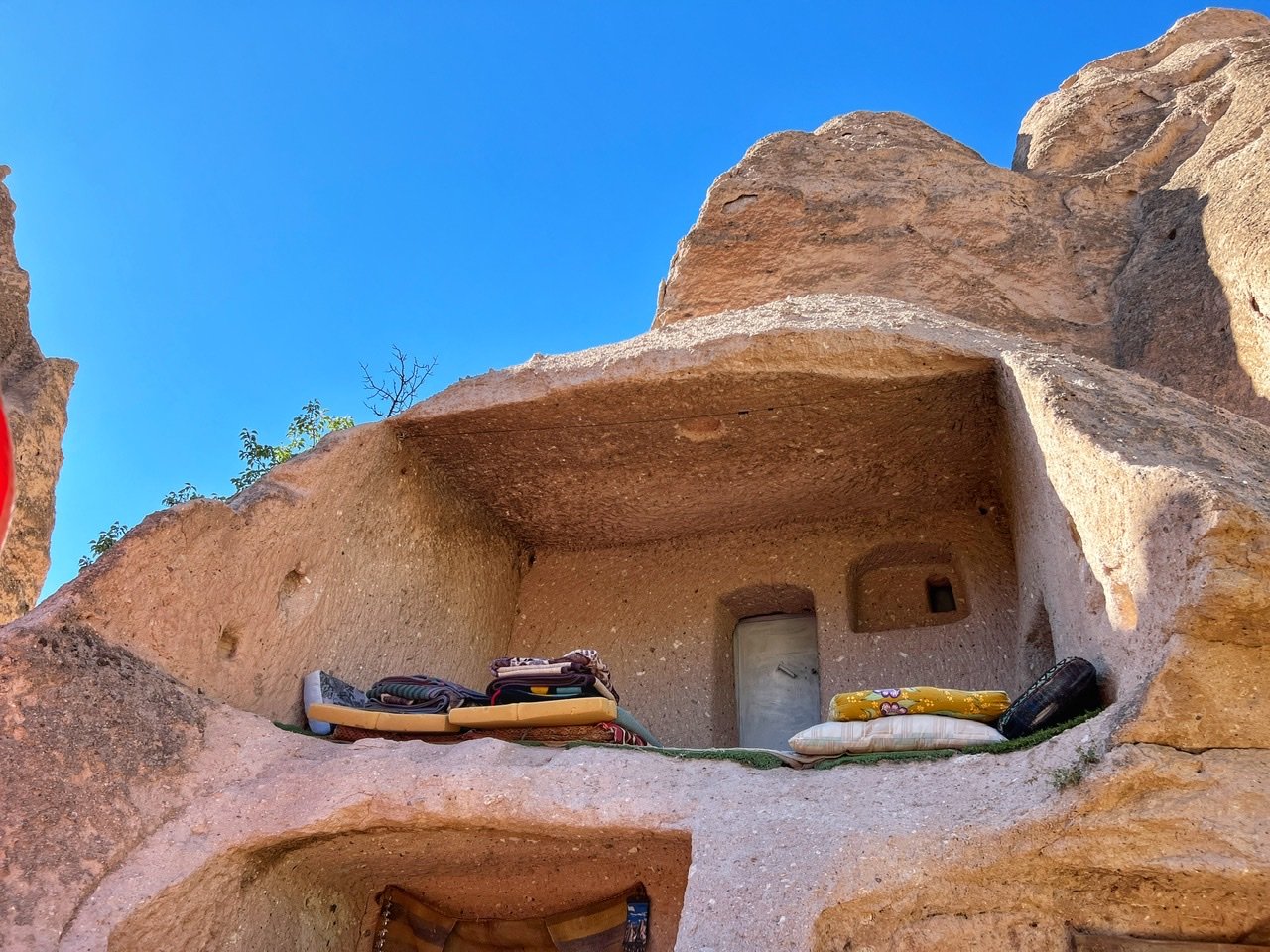
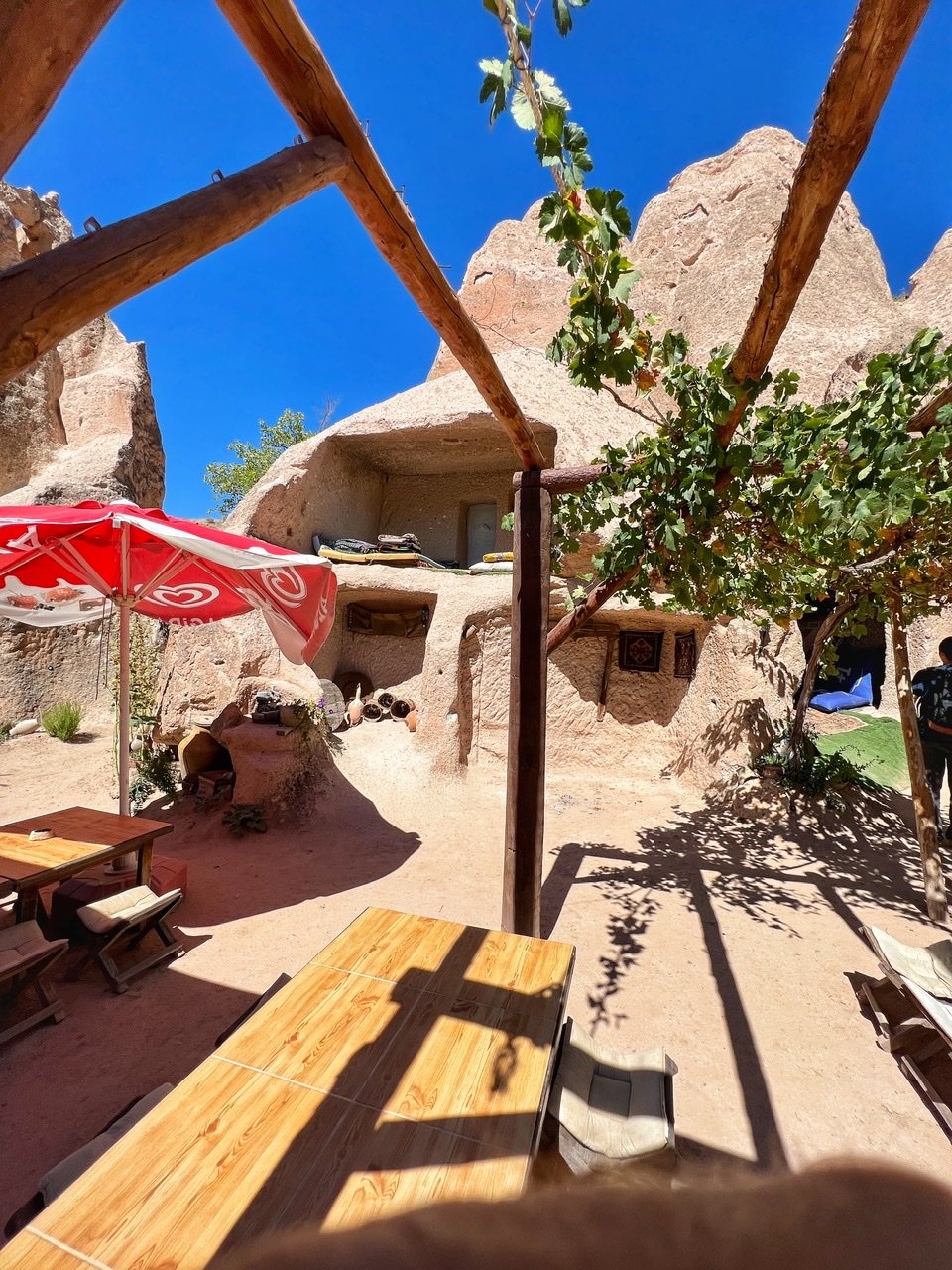
…which was only about 10 feet from the ground.
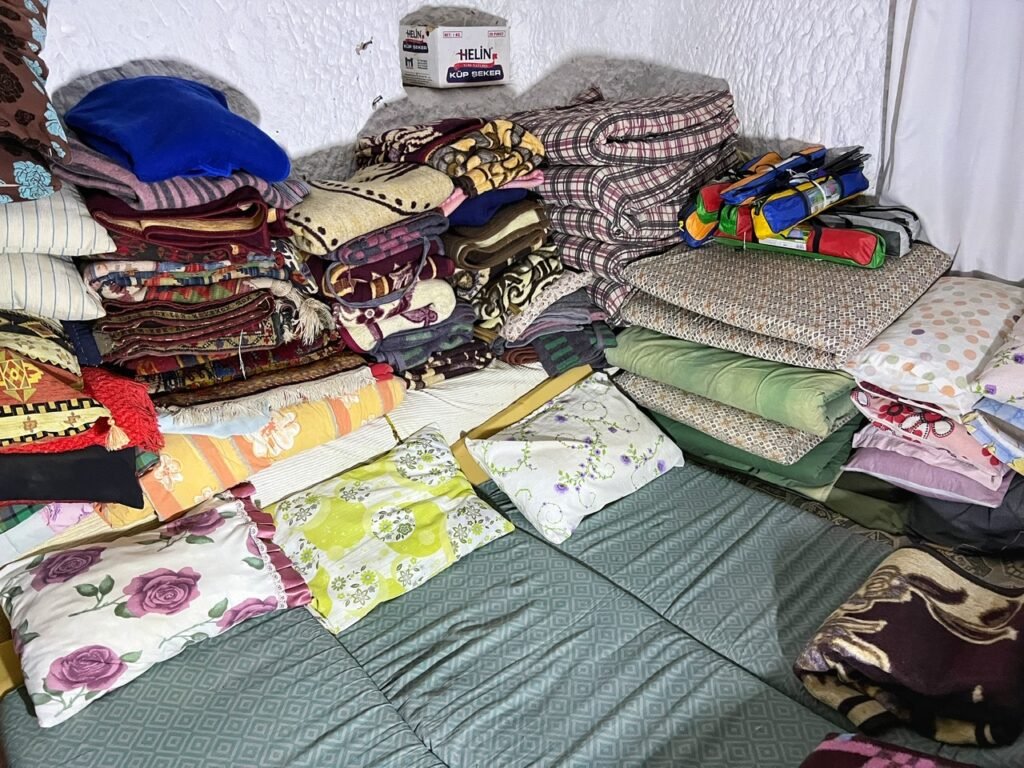
Behind the door was another room which held the bedding materials for the entire camp. Few of these had to be used, however, because the four of us had the place all to ourselves!
It also gave us a backup cave to sleep in should we get too chilly. Although the temperature dropped to around 44F/6C, we managed to stay toasty without climbing into the bed(s) room.

After hiking the Rose and Red Valleys, our hosts served us lots of goodies including lemonade, Turkish tea (because why wouldn’t they?!) and dried apricots doused with a grape syrup and walnuts. Delicious.
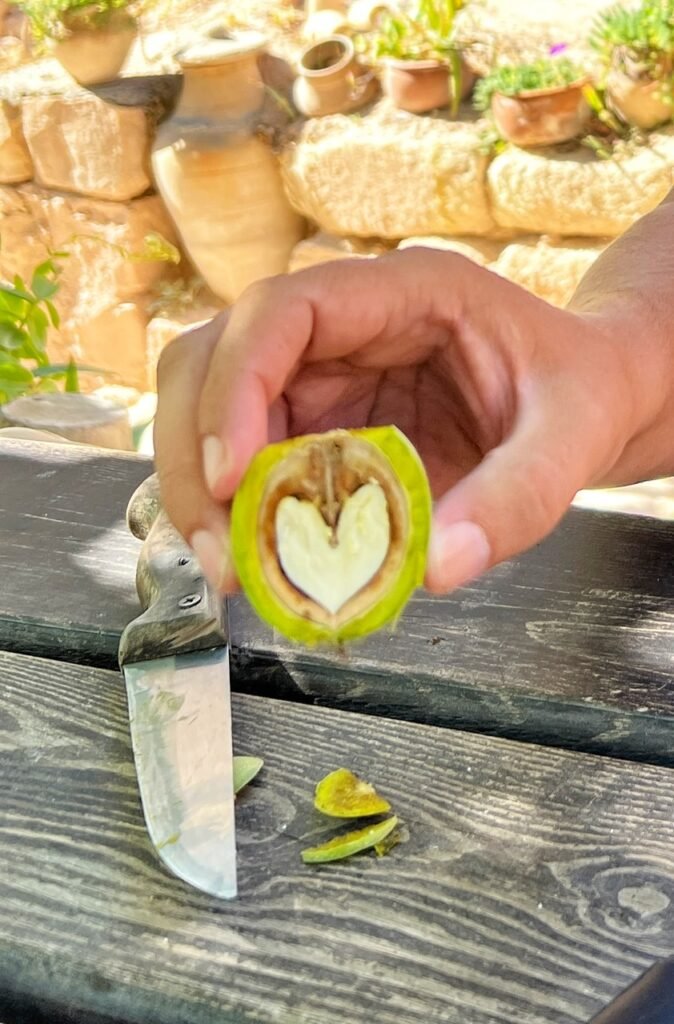
Ibrahim also taught us how to eat walnuts right off the tree dangling over our heads. This one was especially sweet.
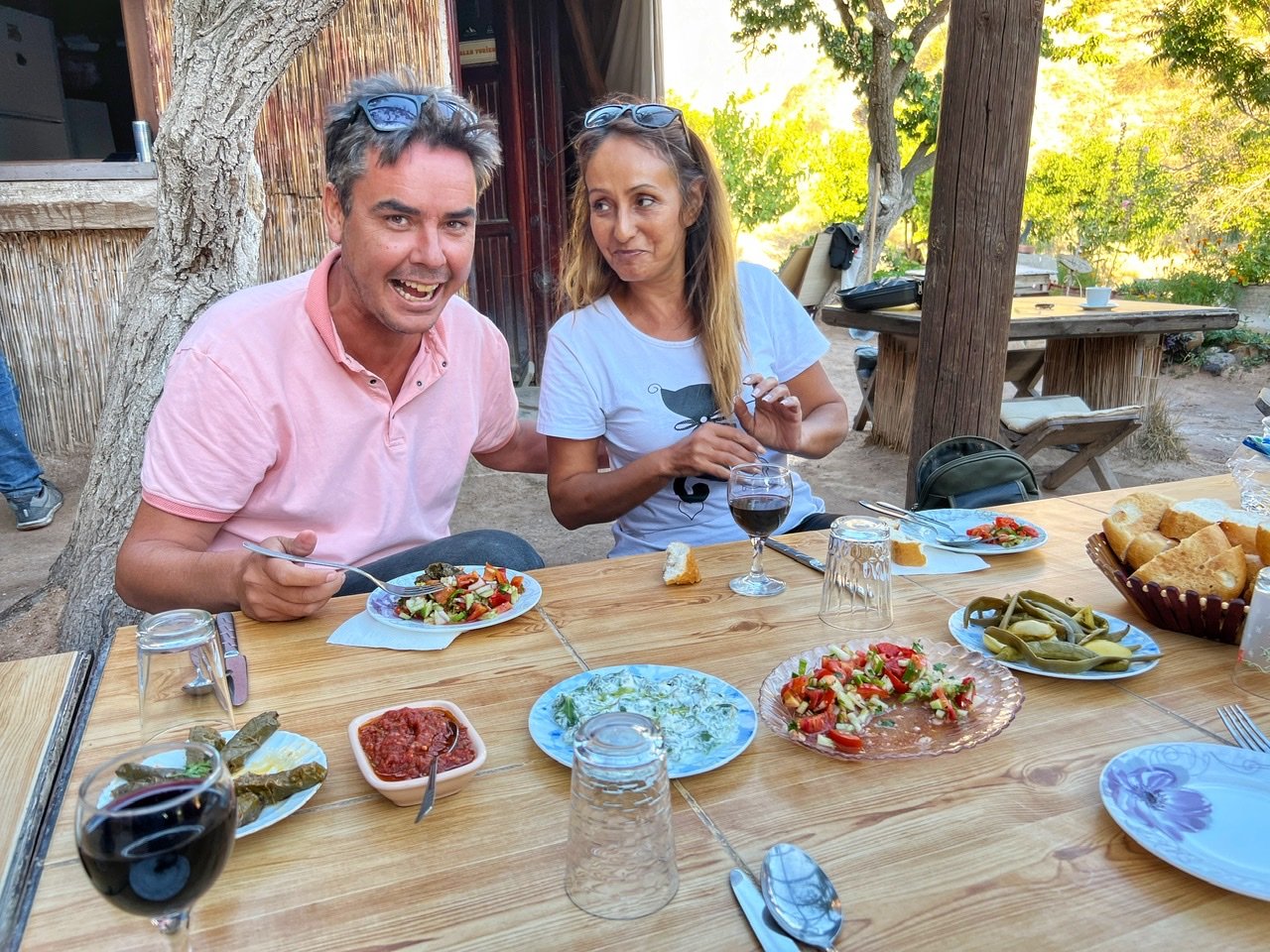
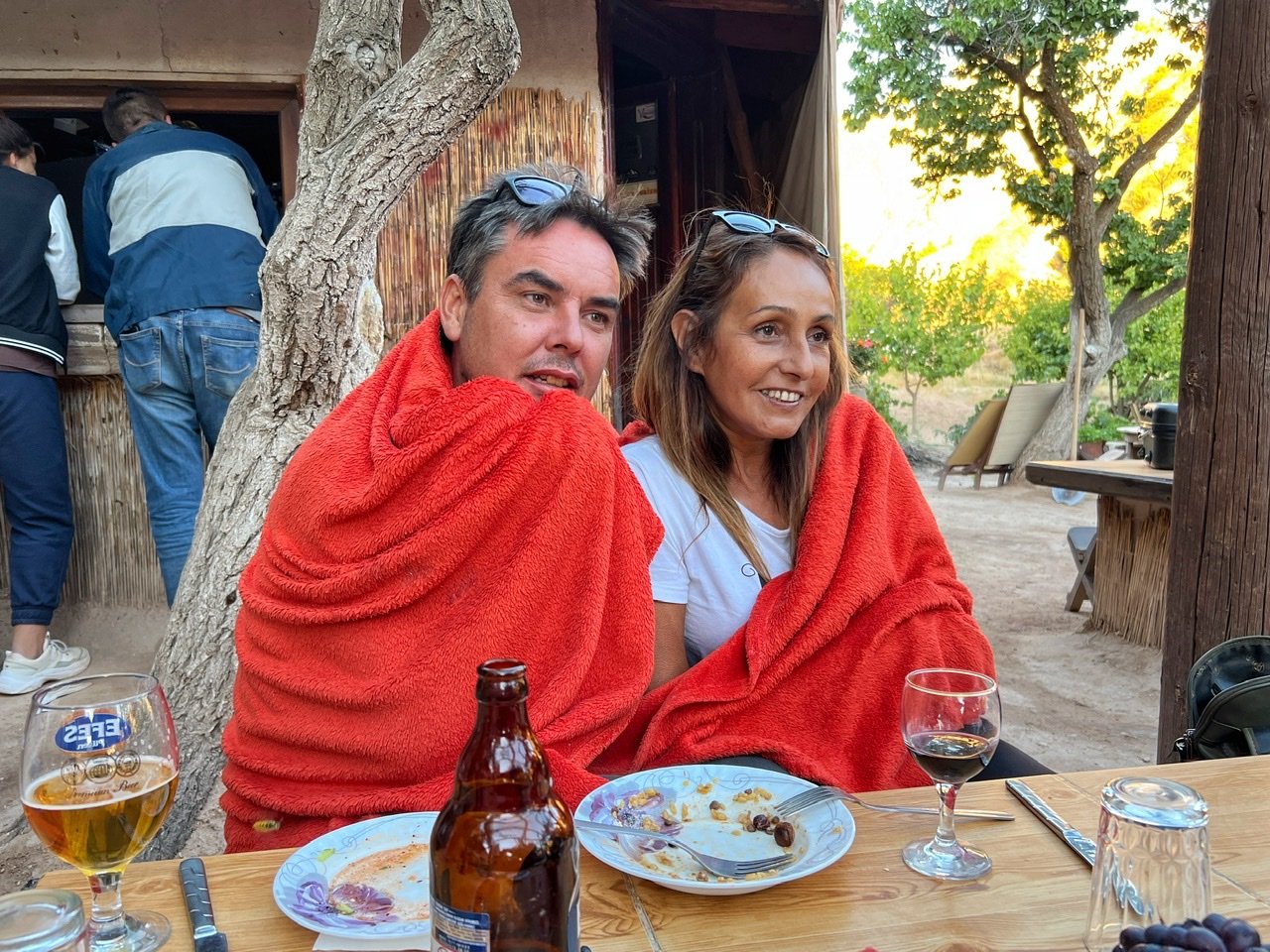
The delightful $10/dinner was a bit steep by Turkish standards but it also had to be schlepped in making that totally understandable. We also brought our own wine. Robin and Feriha failed to bring any warm clothes so Robin instead walked around looking like a “hobo.”
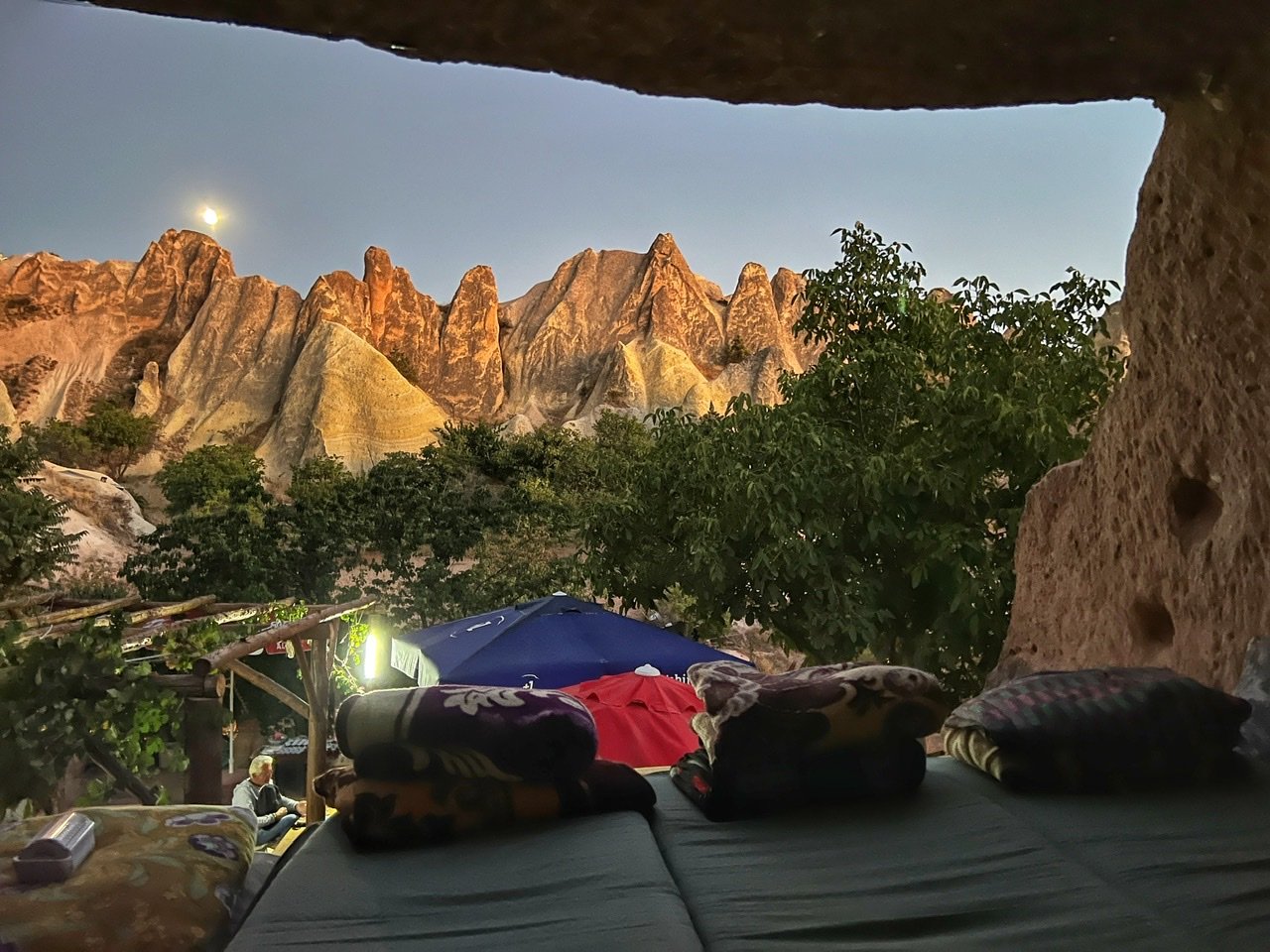
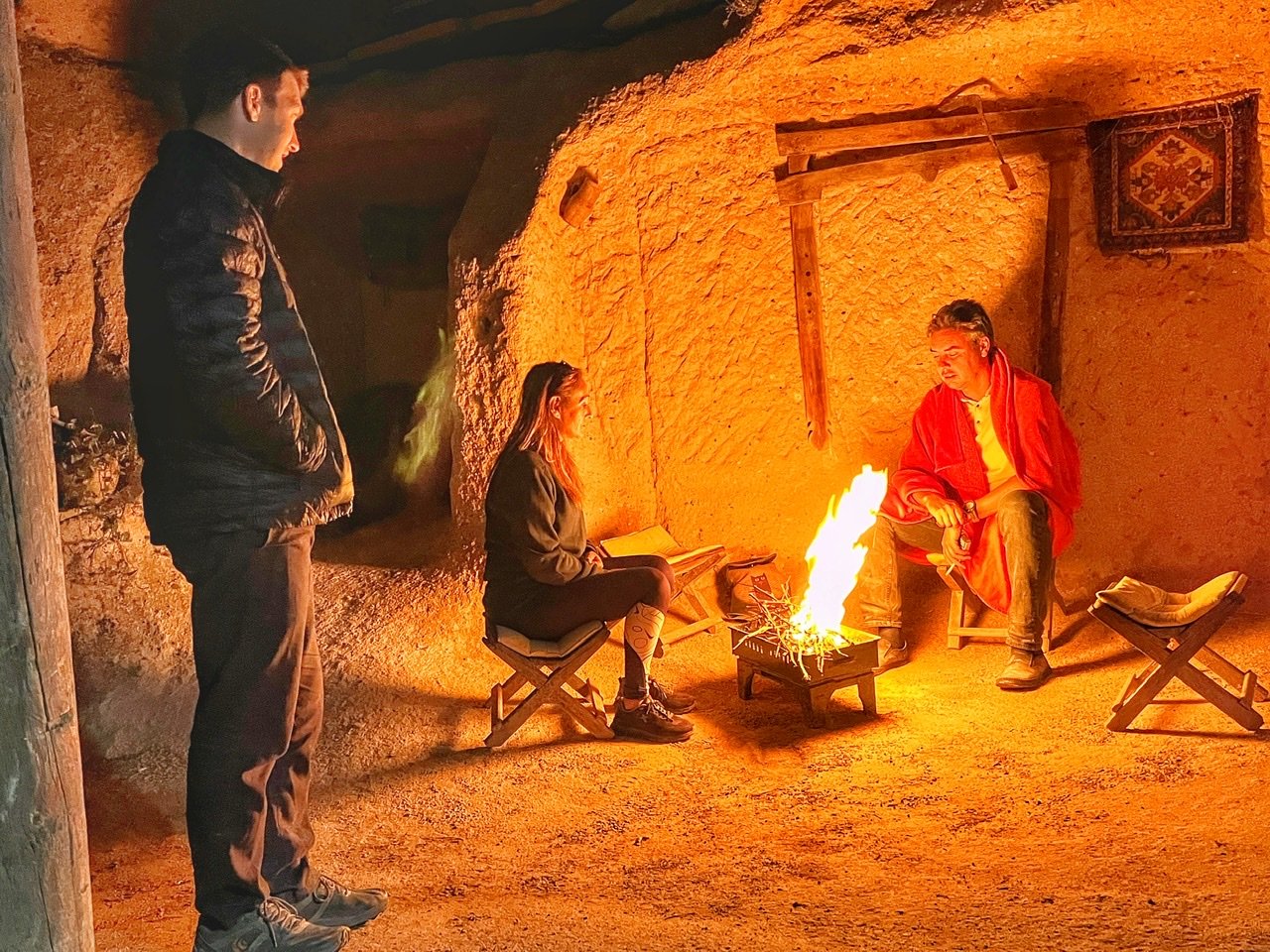
Our little home at twilight. The hosts even made us cave people a little campfire for us before leaving us all alone overnight!
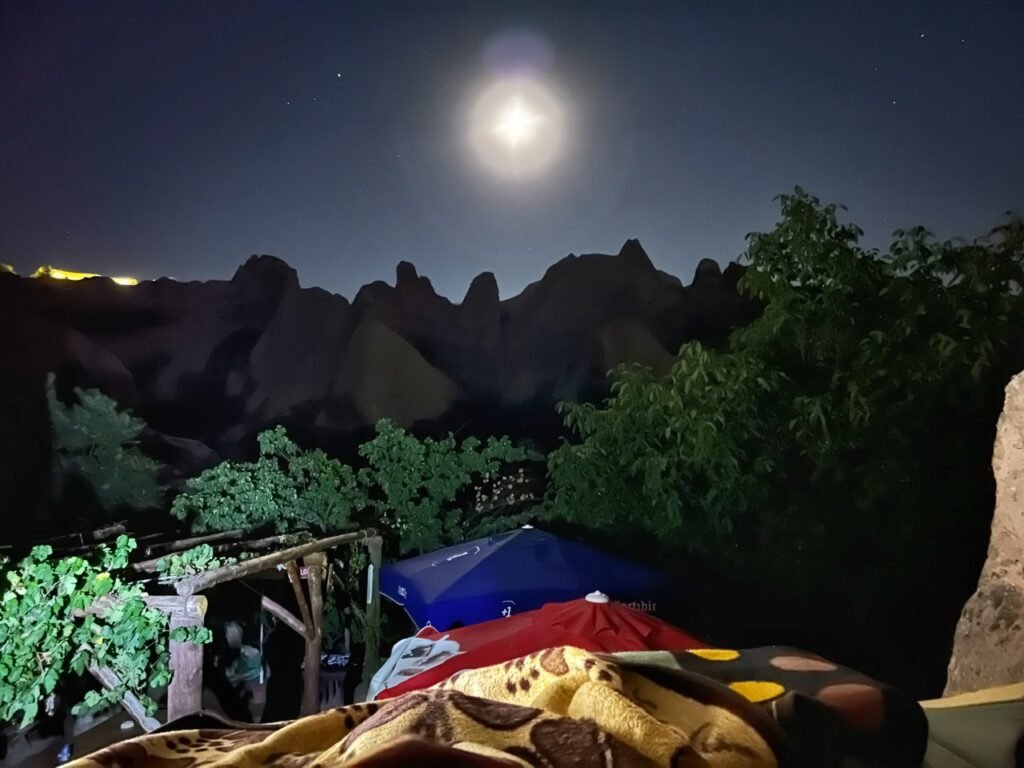
It was one bright moon to sleep by! Eye masks to the rescue!
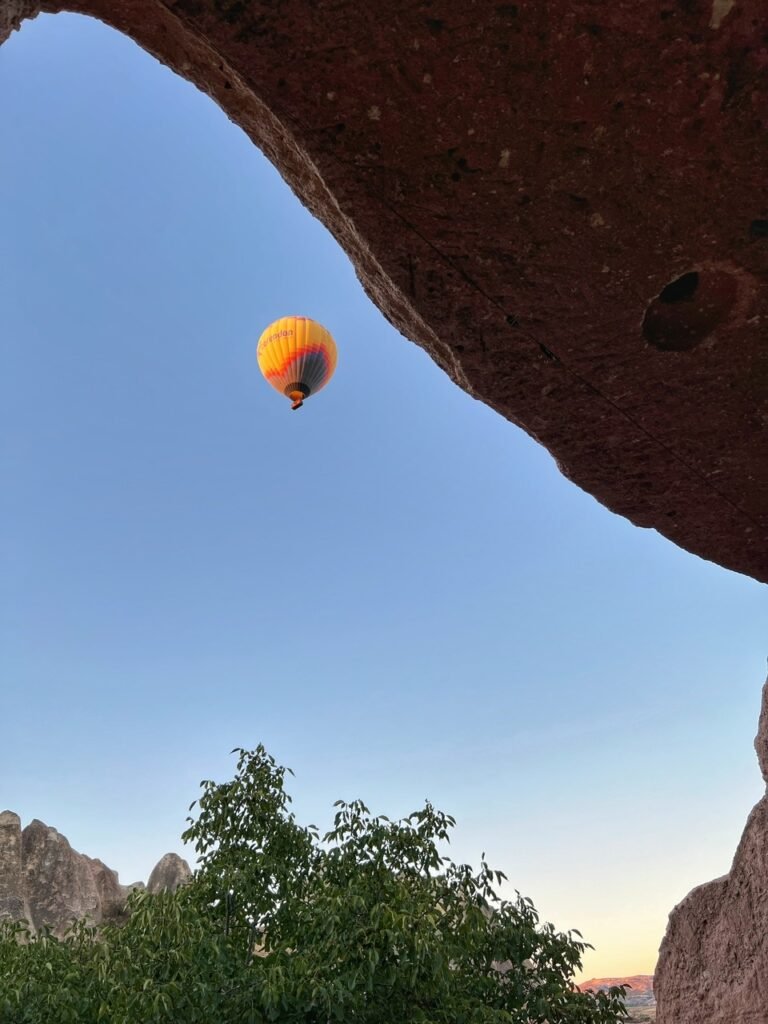
Now that’s a fun alarm clock!
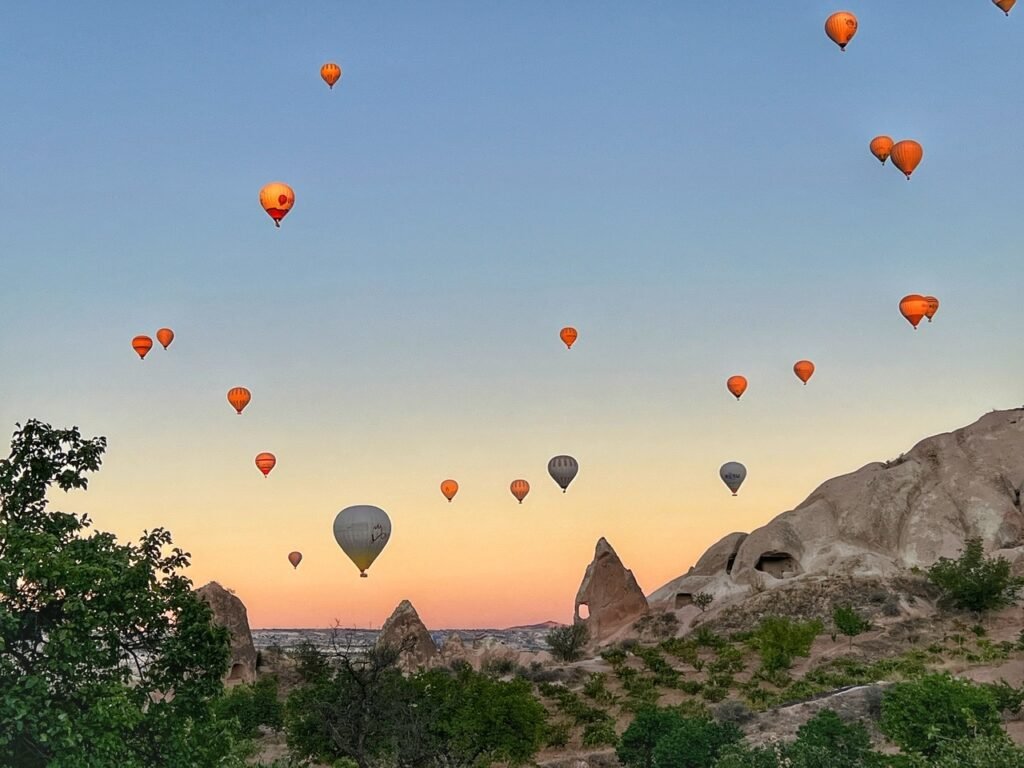
Mandy was first to hit the loo and was rewarded with quite a view!
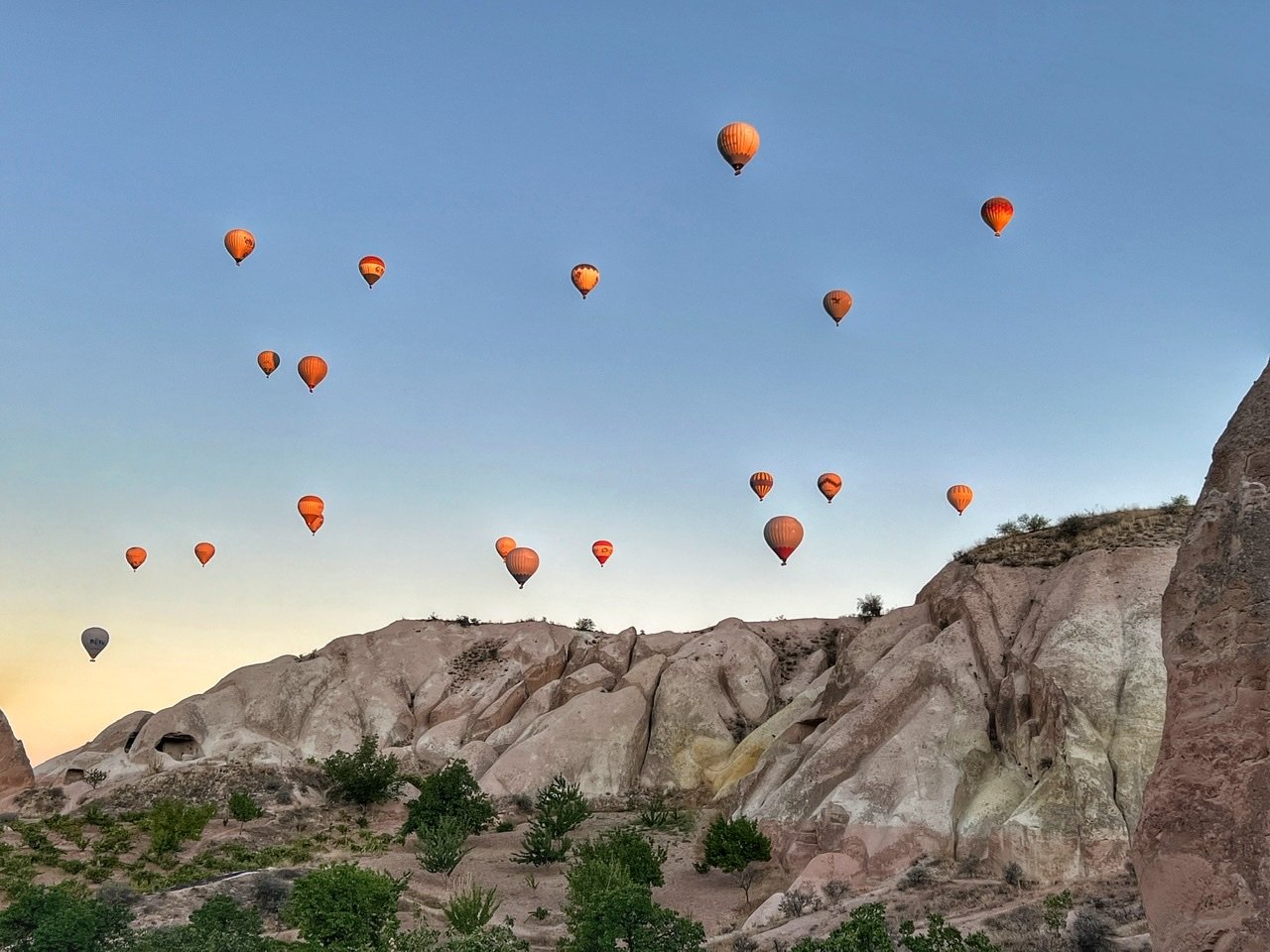
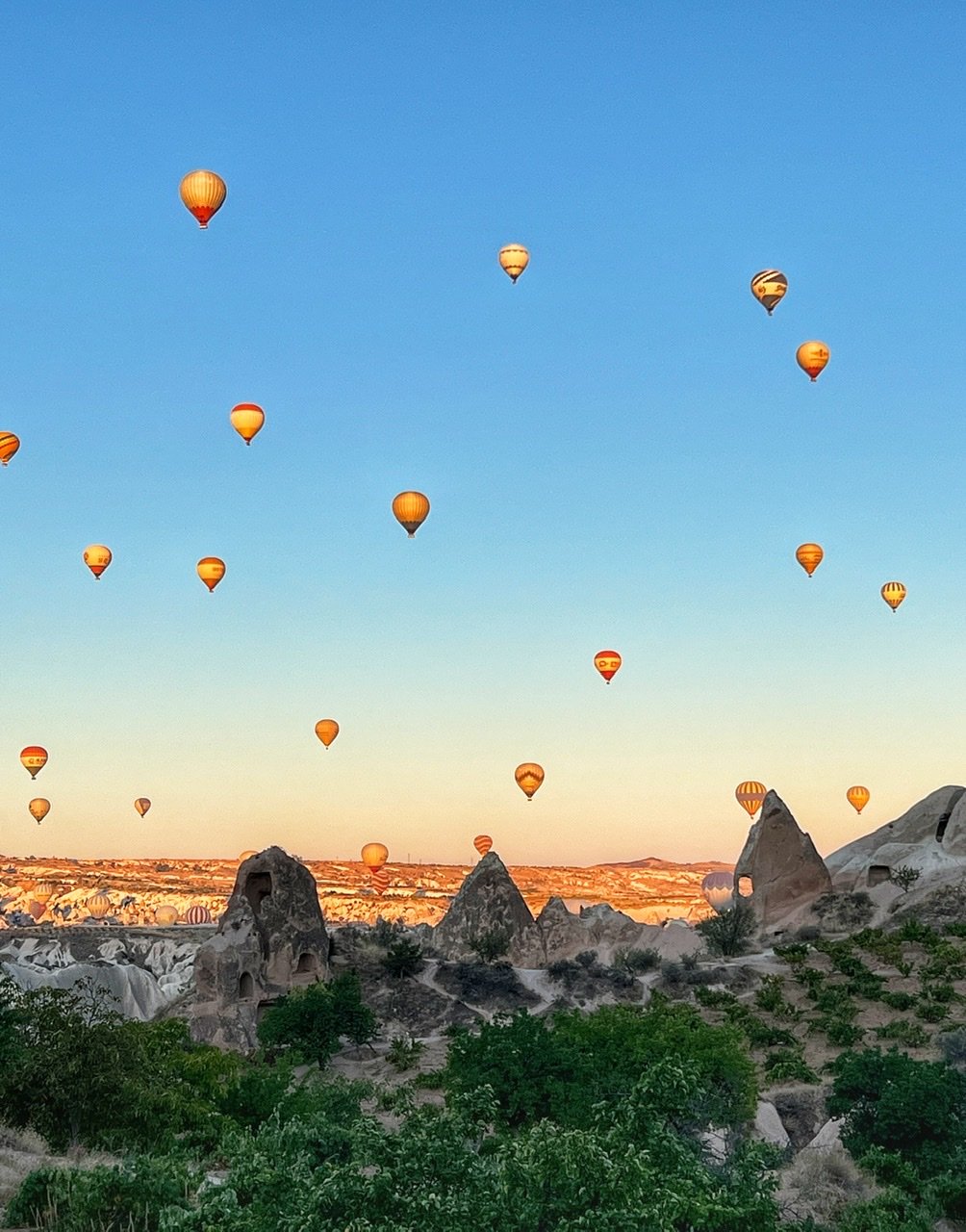
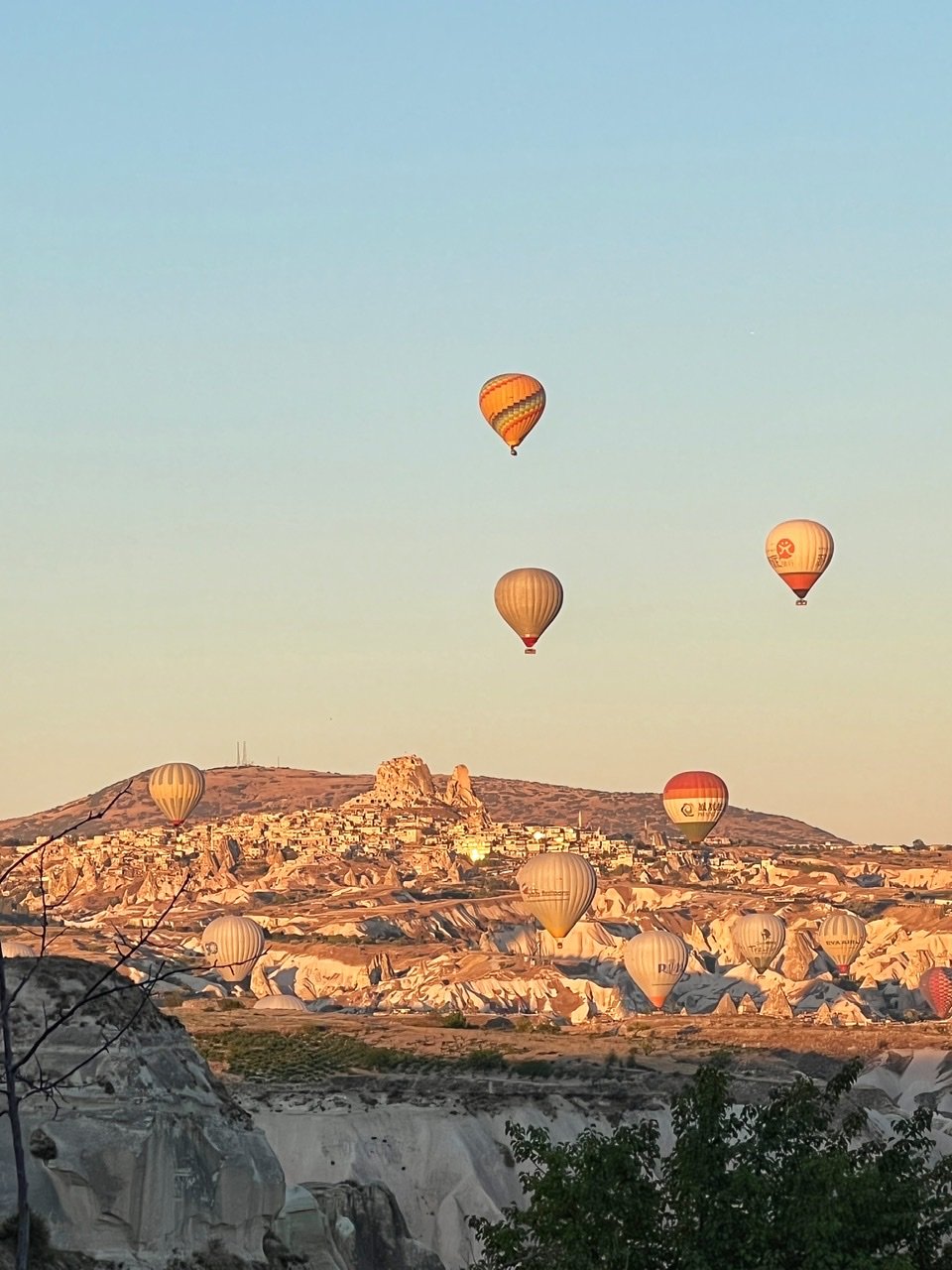

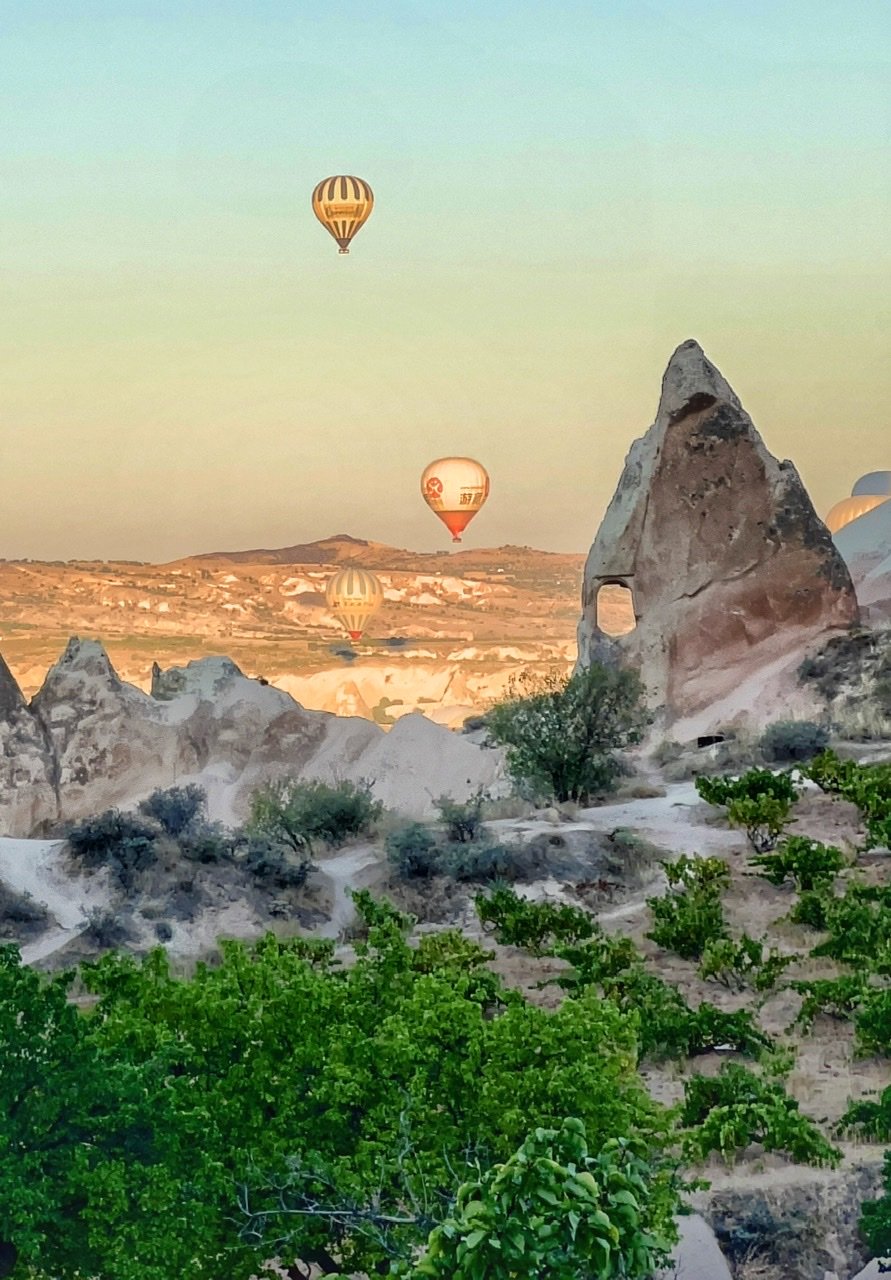
We counted 65 balloons that morning. It was almost a better experience watching them from this angle than our actual balloon day.
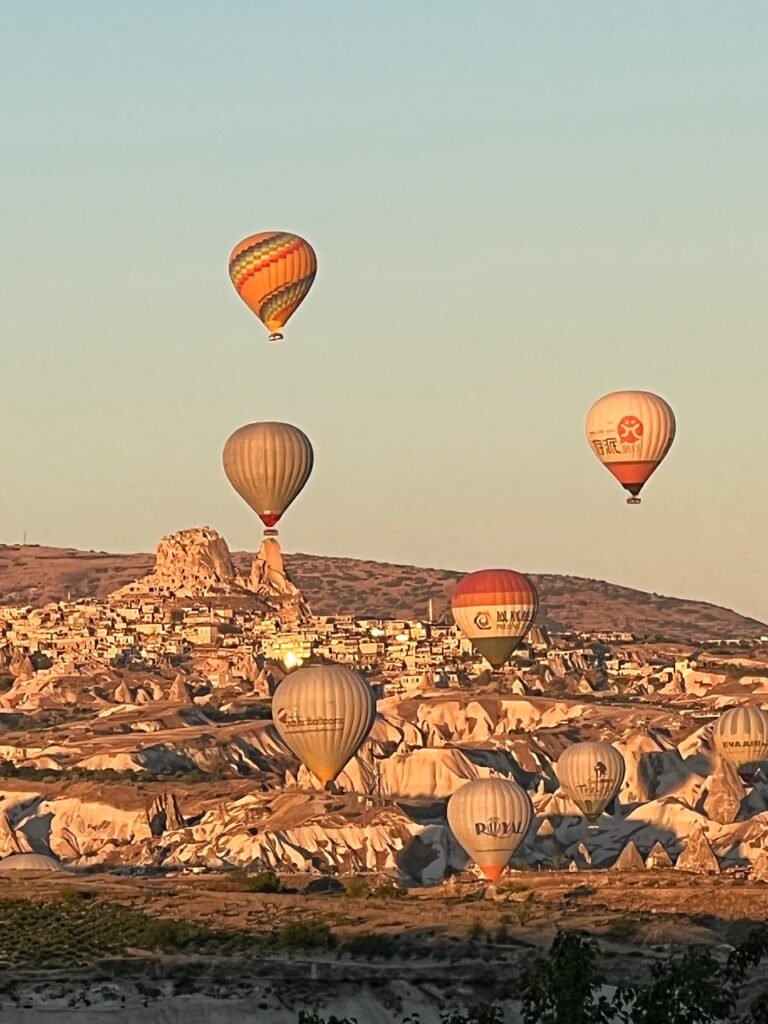
Nailed it!
Feriha, always the hostess with the mostest, tidied up our cave.

Our hosts came back at 8:00 to cook us an amazing Turkish breakfast. Hmmm….which guy is the morning person? Or, perhaps its just the warm puffy coat? We love you Robin! ? In fact, we had so much fun hanging out with Robin and Feriha that we can’t wait to see them more very soon!

If you want to stay at the Red Valley cave, contact Ibrahim directly by what’s app. Definitely don’t book with Airbnb!

